
FIELD GUIDE TO IMPACT INVESTING
FOR AUSTRALIAN CHARITABLE TRUSTS & FOUNDATIONS
3rd Edition (V3.1) | 2023
ABOUT THIS FIELD GUIDE
The Field Guide is presented in 8 parts. Click on the navigation menu icon in the top left hand corner of your browser to expand the sections of this document and help you find what you are looking for.

ACKNOWLEDGEMENTS
This Field Guide is the result of the collaborative effort of experts from the field, investors, investees, students, and other passionate people keen to see Australia's impact investing ecosystem grow and thrive.
Special thanks in particular to contributors, interviewees, and the supporters listed below.

2018 Advisory Committee
- Kylie Charlton - Chief Investment Officer, Australian Impact Investments
- Lisa George - Global Head, Macquarie Group Foundation, Macquarie Group
- Michael Lynch - Executive Director, Impact Investing, Social Ventures Australia (now Managing Director Social Infrastructure Investment Partners)
- Sally McCutchan - Executive Director, Impact Investing Australia (now Executive Director, Breakthrough Victoria)
- Belinda Morrissey - Chief Executive Officer, English Family Foundation
- Will Richardson - Managing Partner, Giant Leap & Non-Executive Board Member, Alberts
- David Rickards - Executive, Co-Founder, Social Enterprise Finance Australia
- David Ward - Technical Director, Australian Philanthropic Services
Researchers, writers and editors
- Jessica Mendoza Roth, Social Impact Hub
- Rob Haggett, Social Impact Hub
- Mia Sturrock, Social Impact Hub
- Jen Fong, Social Impact Hub
- Kylie Marks, Social Impact Hub
UNSW student research and writing teams
- Rajarshi Roy; Daniel Brockwell; Joel Nasrallah; Erica Balilo; Fanny Fontaine (Semester 2, 2018)
- Alecia Duong; Christopher Chan; Jasalina Patel; Margaret Kesaris; Marit Olstad; Mark Lin; Simone Chaikin (Semester 1, 2018)
- James Li; Naoko Lambert; Celine Tia; Christopher Joannes; Raghav Iyer (Summer 2017-2018)
Updates for Version 3.1:
- Inclusion of latest data from the Global Impact Investing Network GIINSights Reports
- Inclusions of latest data from Responsible Investment Association Australasia (RIAA)
- General formatting updates
WELCOME
This, the Third Edition of the Field Guide to Impact Investing, was created to update and refresh our 2018 Second Edition. The Field Guide provides practical strategies and support for Australian charitable trusts and foundations that use, or are interested in using, impact investing to amplify the impact they can make in their communities and the world more broadly.
The Field Guide includes a step by step guide to help answer the questions:
- What is impact investing?
- How does it compare to traditional investing and how is it different to philanthropy?
- How is impact investing evolving worldwide? And in Australia?
- Why is it important for foundations?
- What are Australian charitable trusts and foundations doing about it?
Parts 1 and 2 provide a general introduction to impact investing, an overview of the global and Australian markets in impact, and explore the range of asset classes, funds, and sectors directed at impact.
Parts 3 to 8 of the Field Guide provide more detailed guidance to Australian charitable trusts and foundations looking to begin, advance or deepen their journeys in impact investing. Challenges and myths that can get in the way of impact investing efforts are explored and debunked, and initiatives and ideas to overcome barriers, both real and perceived, are illustrated.
Case studies from a range of Australian impact investors help to illustrate how impact investing works in practice and provide recent examples of initiatives and experiences from the field. Each story links to extended content - interviews, videos and other material - created to support your journey.
Read on to learn about opportunities, strategies and tactics for advancing your impact investing journey.
PART 1
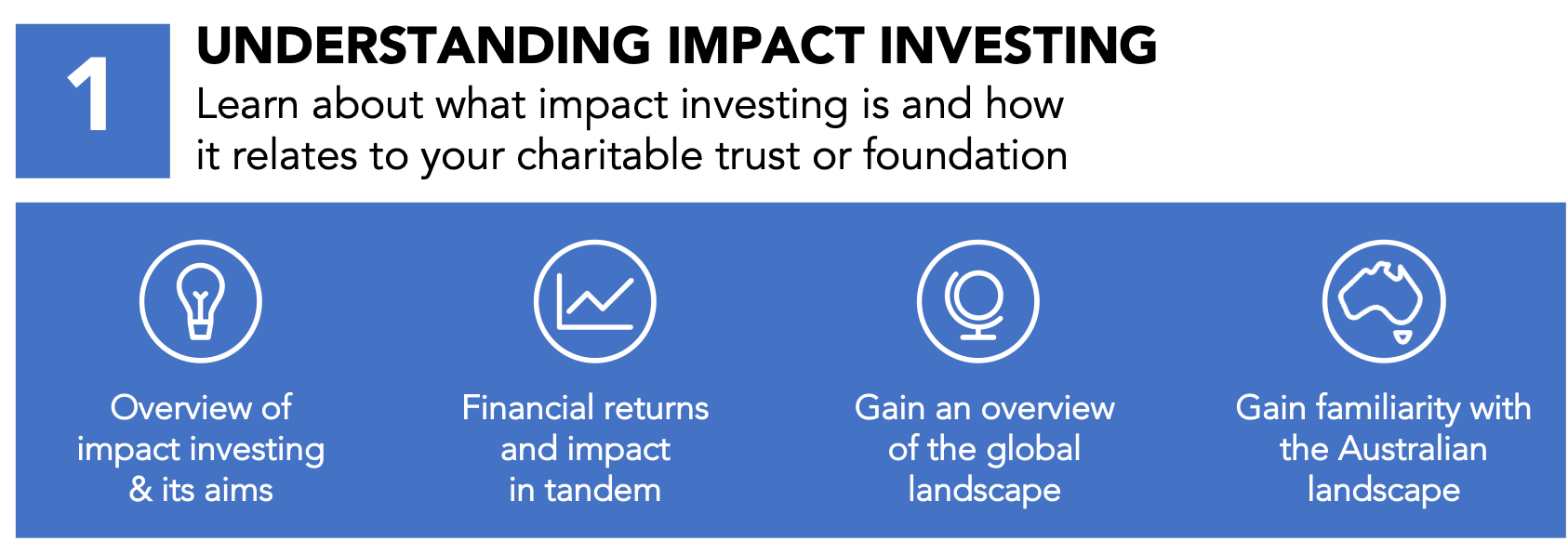
1.1 Overview of impact investing & its aims
Impact investing… harnesses entrepreneurship, innovation and capital to power social progress… By bringing a third dimension, impact, to the traditional capital market priorities of risk and return, impact investing has the potential to transform our ability to build a better society for all. Social Impact Investment Taskforce (1)
A vibrant impact investing market is growing worldwide, as the private sector and governments seek innovative solutions to address the world’s most pressing challenges. At the same time, investors’ increasing recognition that their investment decisions have an impact on the world and its communities are leading them to seek out opportunities that not only minimise the negative impacts of their investments, but intentionally drive positive impact.
Emerging as a response to the growing challenges facing the world, impact investing has the potential to bring game-changing capital to challenges too large and complex to be addressed or funded by the government, the social sector, or philanthropy alone.
What is impact investing?
The Global Impact Investment Network (GIIN) state that impact investments are investments made into companies, organisations, and funds with the intention to generate measurable social and environmental impact alongside financial return (2).
The 3 key characteristics of impact Investing
When considering what is and what isn't impact investing, it's helpful to understand that there are three core characteristics of an impact investment:
- 1.Intention - the investment opportunity must be designed with a specific objective to achieve social and/or environmental impact. Investments where the impact is unintended are not considered impact investments.
- 2.Measurable impact - the impact is able to be measured and reported.
- 3.Financial return - the return on investment can range from concessionary (below market) through to market-rate and market-beating returns, but there is an expectation of at least return of capital.

Figure 1.0 The core characteristics that define impact investing.
In the past decade, impact investing has developed to provide capital across a range of sectors including sustainable agriculture, conservation, renewable energy, microfinance, and affordable and accessible housing, healthcare and education (3).
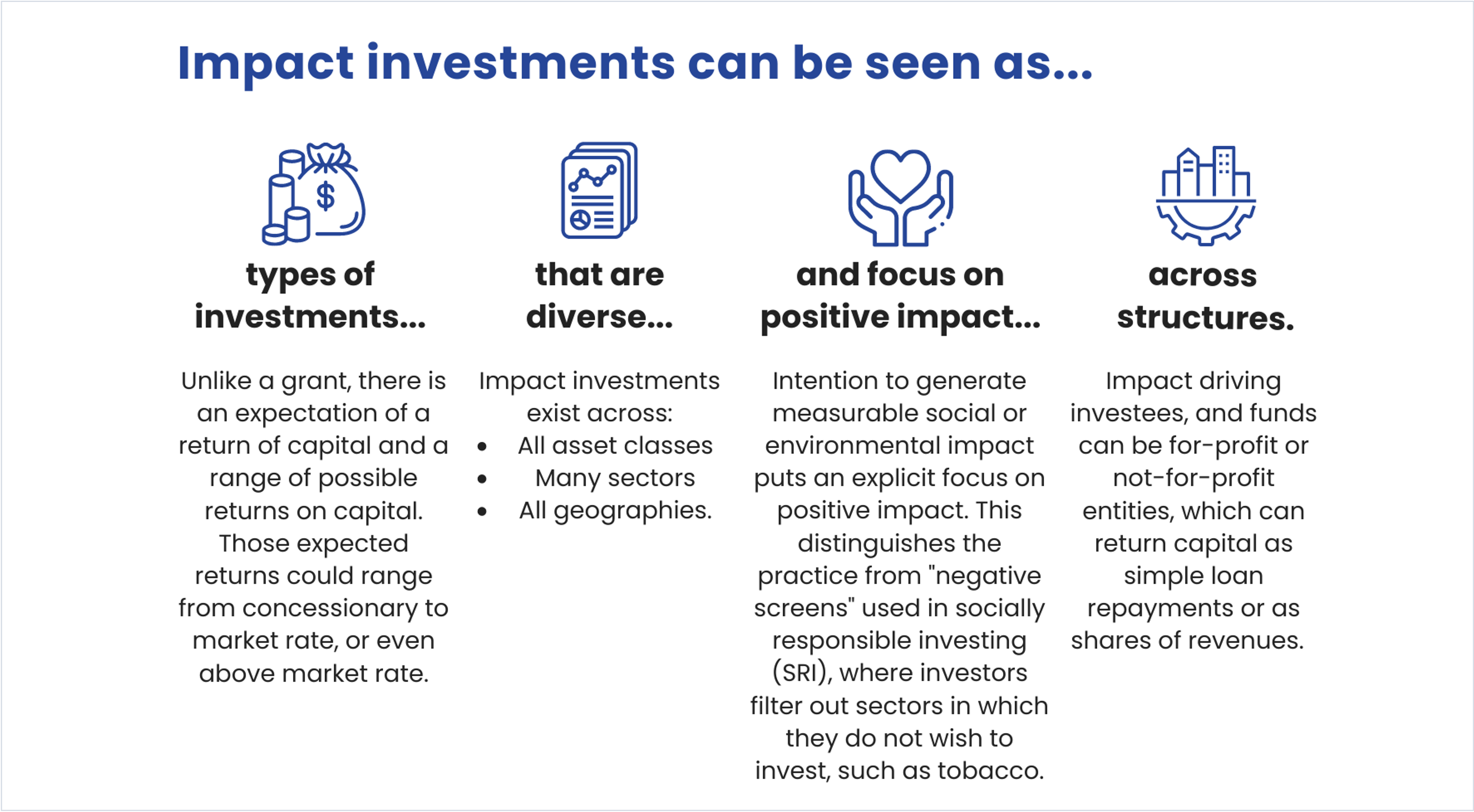
Figure 1.1 Adapted from Case Foundation’s A Short Guide to Impact Investing: A primer on how business can drive social change 2015.
The potential for impact investing
Allowing investors to make a meaningful financial return whilst investing in social and/or environmental objectives, impact investing directs the flow of capital towards funding and sustaining the innovative, scalable solutions needed to address the world’s most pressing social and environmental challenges(4). While impact investing is still in an emergent phase, its growth presents excellent opportunities for forward looking investors who know that the only profitable future is a sustainable one.
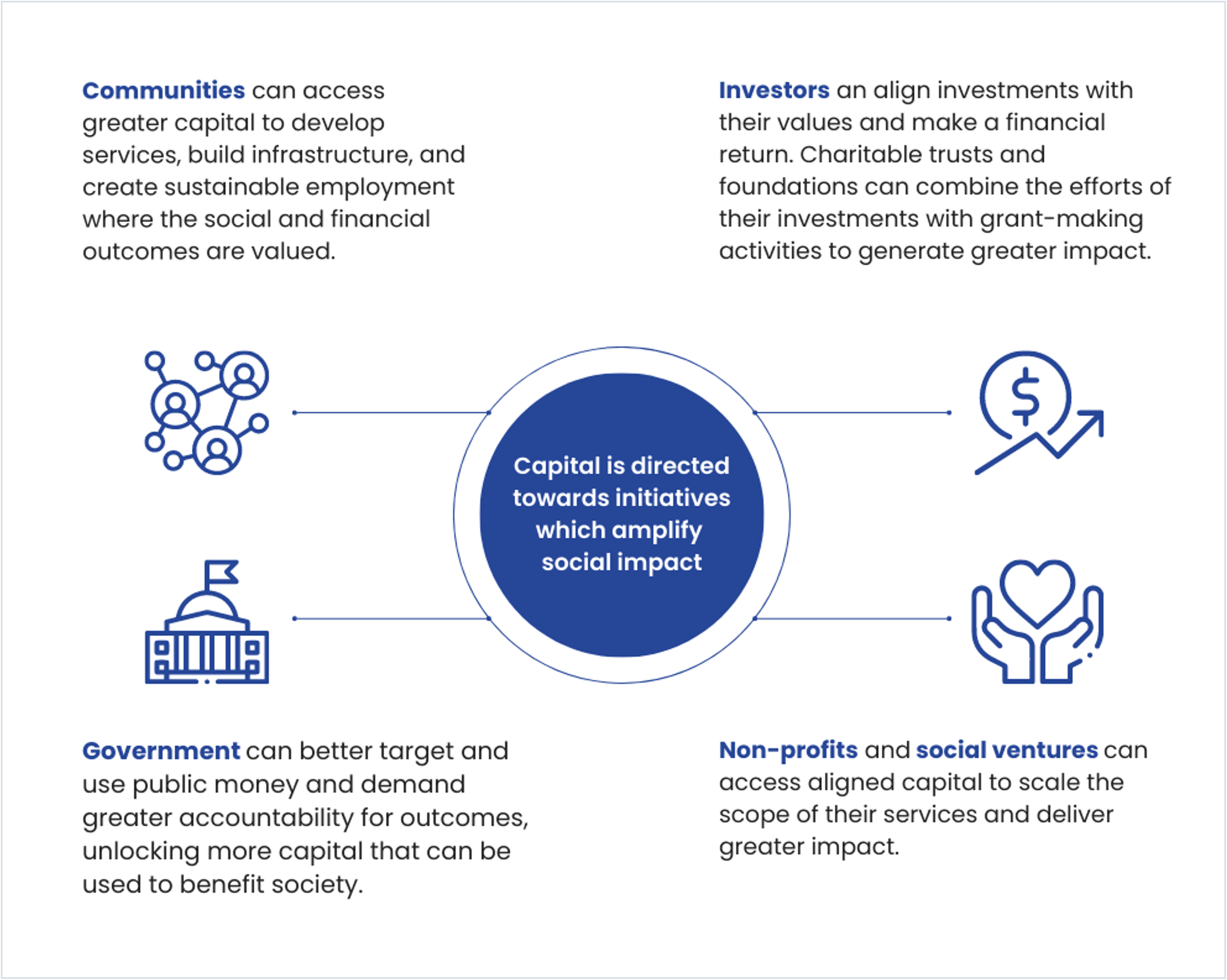
Figure 1.2 sets out the potential of impact investing for investors, government, not-for-profit organisations (NFPs), social ventures, and the community.
1.2 Financial returns & impact in tandem
The expectation of financial return differentiates impact investing from philanthropy, and the specific objective of making and measuring impact differentiates it from traditional forms of investment.

Figure 1.3 Impact investing in context, financial return and impact.
The terms impact investing, Environmental, Social and Governance (ESG) investing and Socially Responsible Investing (SRI) are often used synonymously, but impact investing is distinctly different from ESG and SRI and other forms of ethical or socially responsible investing and it is helpful to understand these differences. Figure 1.4 shows the spectrum of common investment typologies.
ESG and SRI generally apply a set of negative or positive screens to an investment. Negative screening involves avoiding or excluding investments with low environmental, social or governance metrics, and screening companies under certain criteria. In contrast, impact investing goes beyond passive screening by seeking investment opportunities with the goal of affecting either or both social and environmental change with returns that may be below, at, or above market.
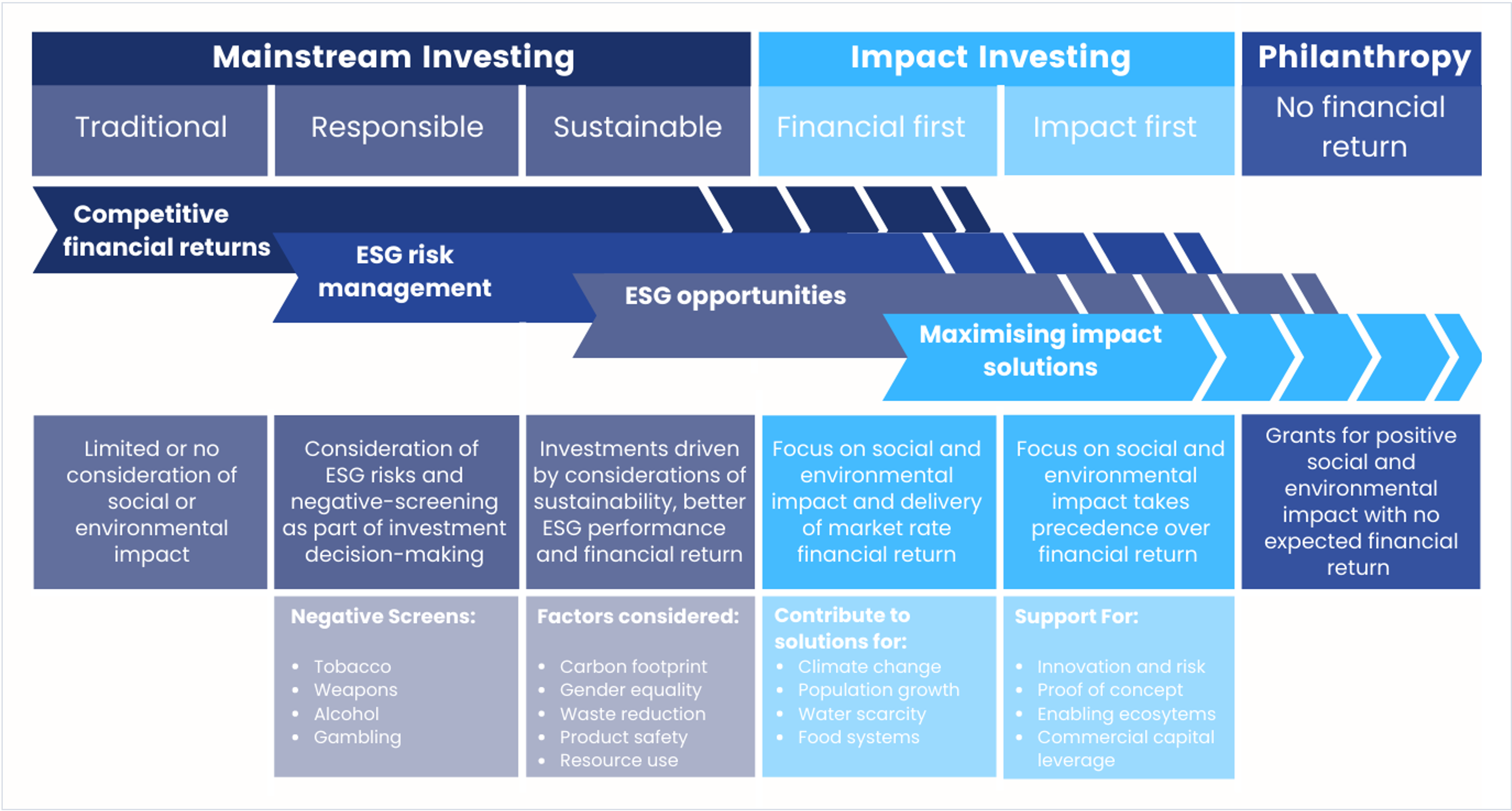
As Figure 1.4 shows, across the spectrum of impact investments, there are varying levels of financial return, reflecting the differing risk appetites and requirements for financial return from various investors. (5) Adapted from Impact Investment Spectrum by Sonen Capital. (6)
Impact-first, finance-first, or blended value?
The following terms are sometimes used to describe approaches to impact investment with respect to financial and social/environmental return.
Finance-first Impact Investments seek to maximise financial return while aiming to make a real and measurable impact. This means that investors set minimum impact objectives that must be considered when selecting investments, however the expectation is that these investments will generally achieve financial returns that are competitive with traditional investments.
Impact-first Impact Investments seek to maximise social and/or environmental impact while still making a financial return. The financial return may be above or below risk-adjusted market rates of return. Impact-first investors are primarily driven by their desire to create impact and are therefore willing to accept a below market financial return and/or take higher risks to achieve these objectives. Philanthropic trusts and foundations are more likely to use this type of investment as an adjunct to their granting strategy, rather than institutional investors.
While impact-first and finance-first distinctions may be helpful in characterising opportunities and investment styles for some, there is a growing trend towards investors managing for total performance. (7)
‘Both/and’ or Blended Value Investments seek to create sustainable, long-term solutions to global challenges through strategies that neither prioritise economic return nor social return, but rather a blend of both. They are located in a space between philanthropy, where no financial return is expected, and pure financial investments, which does not focus on social or environmental outcomes.
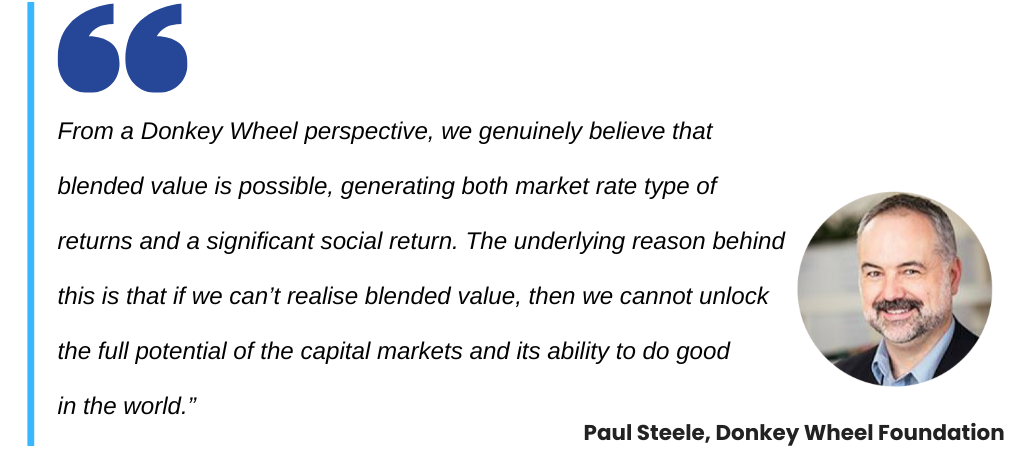
While some investors believe impact investments will lead to smaller returns, with a trade-off between financial return and social impact, history has shown this is generally not the case.
There’s a persistent myth that impact investing automatically necessitates a trade-off in financial performance… But it’s quite feasible for impact investors to make competitive returns.” Abhilash Mudaliar, Paul Ramsay Foundation (8)
While impact investors target financial returns along a spectrum ranging from capital preservation to market-rate, it should be noted that most respondents in the GIIN's '2023 GIINsight: Impact Investor Demographics' report continue to target risk-adjusted, market-rate returns, with this increasing from the 2020 report:
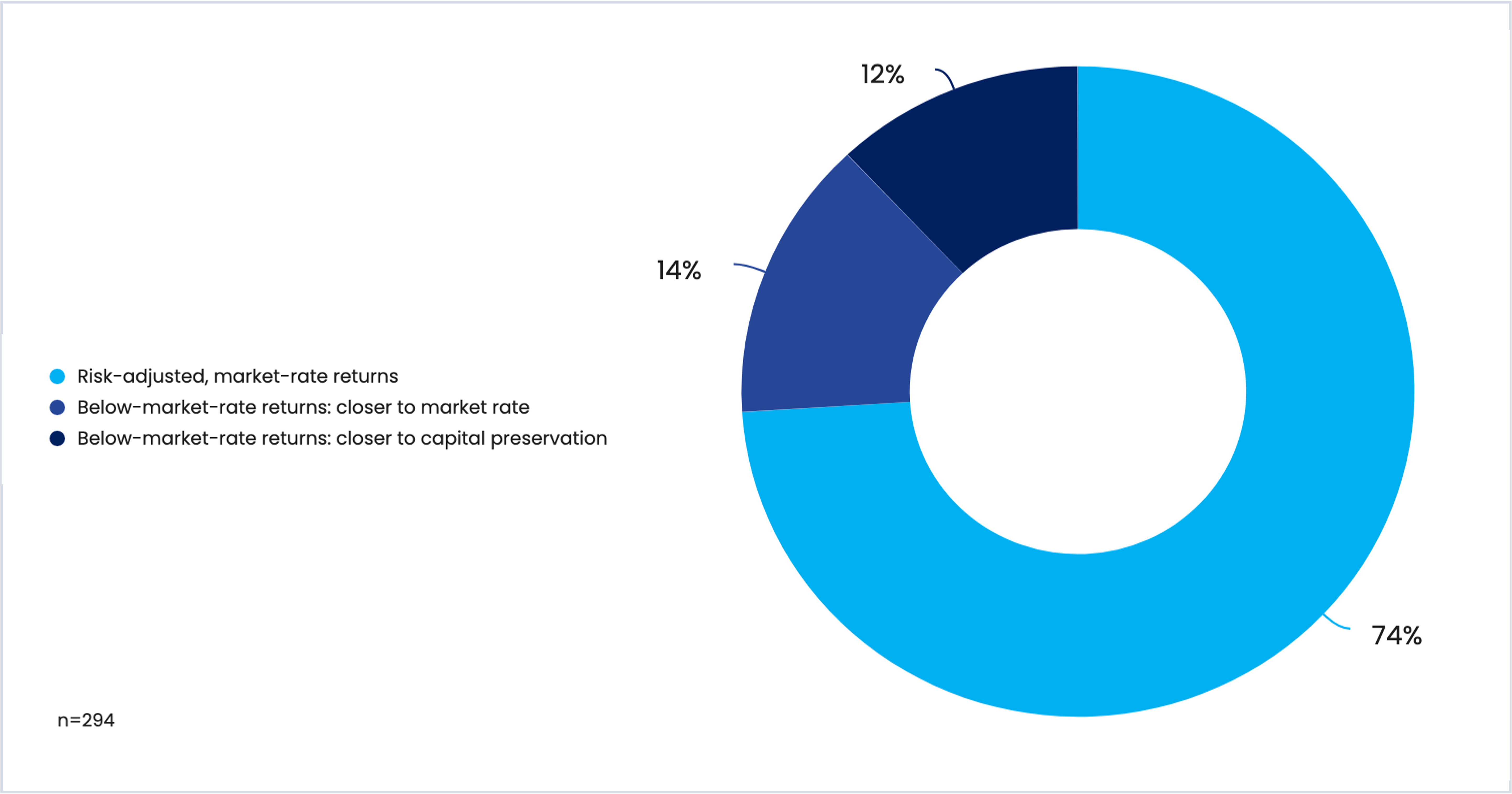
Figure 1.5 Adapted from Global Impact Investing Network (GIIN), 2023 GIINsight: Impact Investor Demographics (29)
The GIIN’s 2020 survey also revealed that 'an overwhelming majority of respondents reported meeting or exceeding both their impact expectations and their financial expectations (99% and 88%, respectively (10):
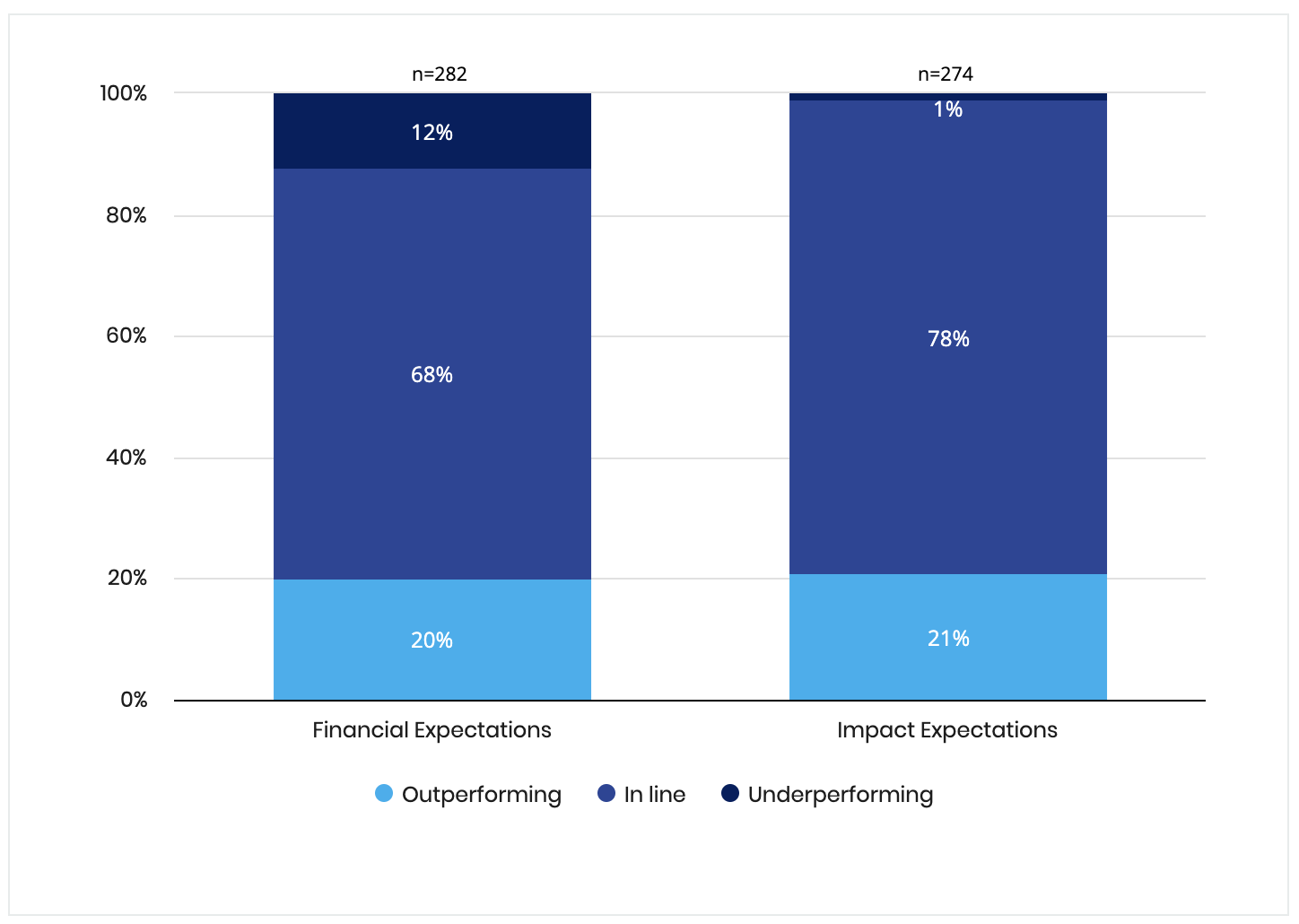
Figure 1.6 Performance relative to expectations (Global Impact Investing Network (GIIN), 2023 GIINsight: Impact Investing Allocations, Activity & Performance) Note: Excludes two organisations that did not share financial performance relative to expectations and one organisation that did not disclose impact performance relative to expectations. (30)
The GIIN’s conclusion was that impact investors can achieve market rate returns, as general funds for impact investment can perform at similar levels to traditional investment. (10) Paul Ramsay Foundation's Chief Impact Officer, Abhilash Mudaliar, does indicate, however, that below market capital plays a critical role in the industry and will continue to do so. One role the submarket plays is as a bridge between philanthropy and investing. This is explored further in Parts 2 and 8.
1.3 The global impact investing landscape
Just over a decade since a coalition of philanthropists and investors introduced the financial-services industry to the term ‘impact investing’, interest and participation in impact investing has accelerated globally.
The majority of impact investment capital originates from America, Europe and the Asia-Pacific region but demand for impact investment extends worldwide. This includes investments made throughout the world into for-profit, hybrid and non-profit ventures spanning a broad range of social and environmental objectives. (11)

Figure 1.7 Organisational representation and impact AUM by headquarters location. Source: GIINsight: Sizing the Impact Investing Market 2022 (12)
It is difficult to accurately determine the current size and potential of the global market due to the broad range of definitions and approaches to impact investment, and estimates vary significantly from organisation to organisation. A current market snapshot from the GIIN's Sizing the Impact Investing Market 2022 report, estimates that the global impact investment market is in excess of $USD 1 trillion (12).
In terms of market trends, Impact Alpha have described a shift of capital into a broader set of 'sustainable' and 'responsible' assets (see Figure 1.4 above for details) (13). The GIIN's research shows that the impact investments are still predominately made by exclusive impact investing organisations (61%) with debt (private and publicly traded) being the main asset allocation (10):
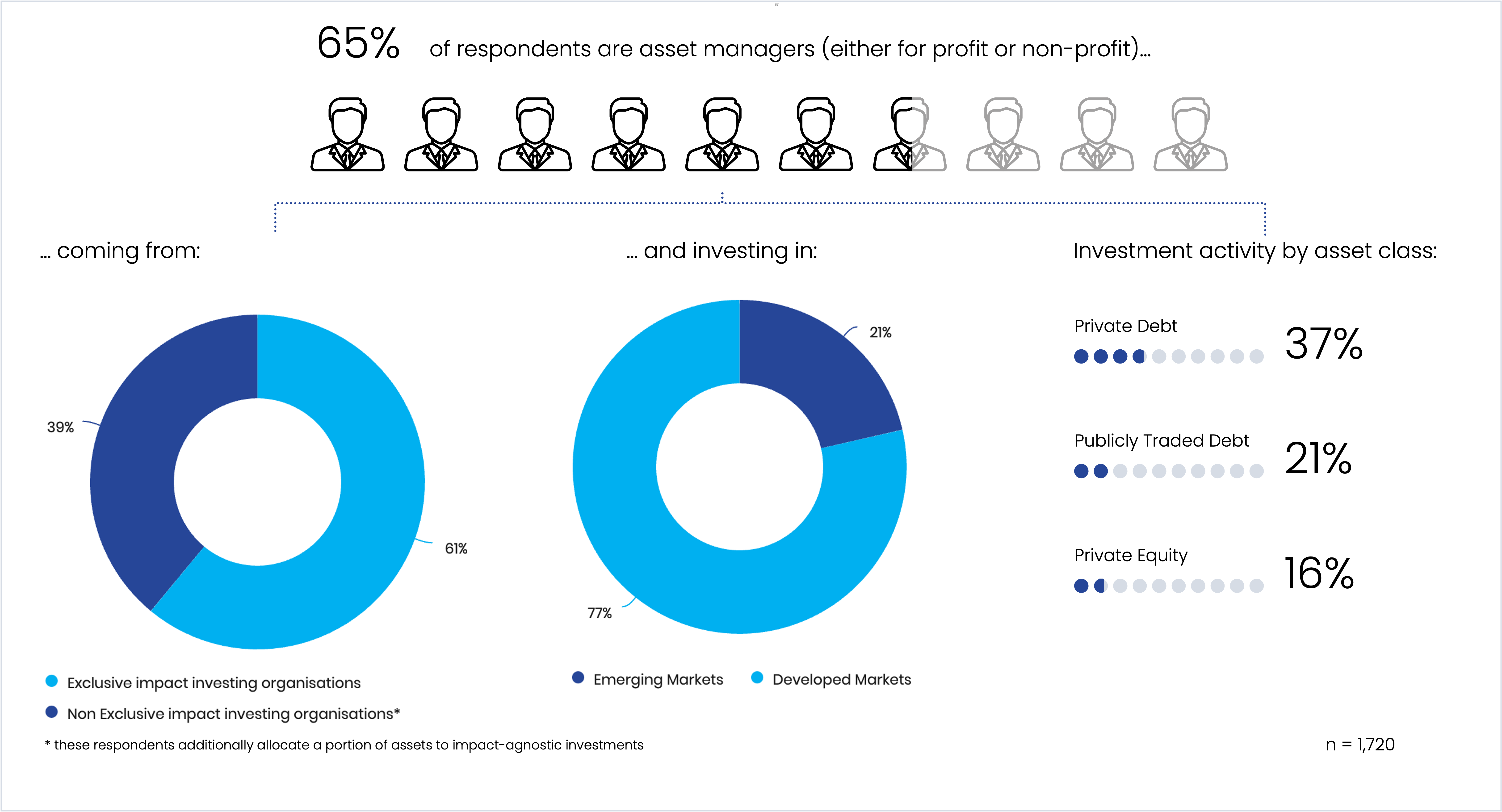
Figure 1.8 Adapted from the GIIN's Annual Impact Investor Survey 2020 (10)
Moving towards the mainstream
The growth of impact investing globally has been catalysed by policy developments in many countries, the emergence of pioneering market builders, and a growing investment appetite worldwide. Millennials and female investors are increasingly looking to make their asset wealth for impact and are also a driving force behind this investment momentum (14).
Studies by Morgan Stanley’s Institute for Sustainable Investing have found that 18 to 34-year-olds are twice as likely to invest in a portfolio or individual companies if they seek positive environmental or social impact (15). Furthermore, Fidelity Charitable’s 2022 survey found that of the 1,200 investors surveyed, 60% of millennials are involved in impact investing, compared with 34% of all investors. In addition to alignment of values and personal fulfilment, millennials believed that impact investing has greater potential than traditional forms of philanthropy to create long-term positive change (16):
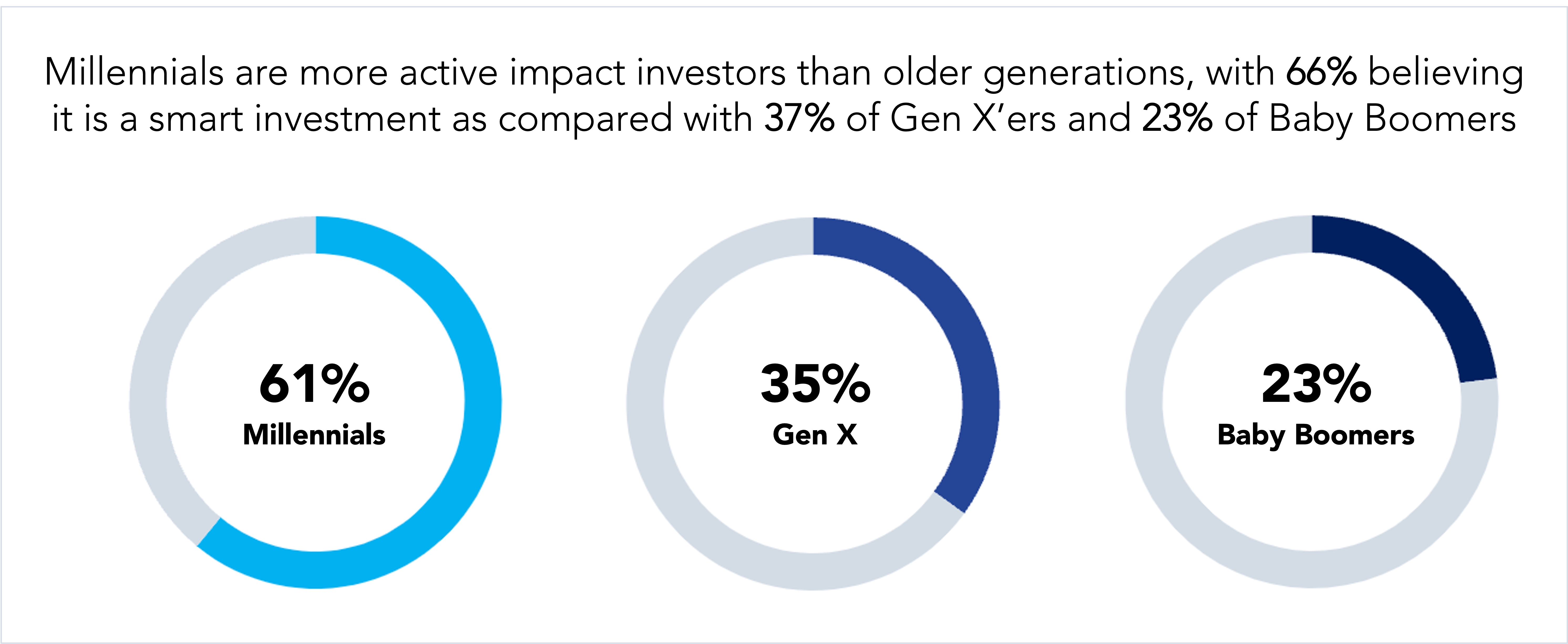
Figure 1.9 Adapted from Fidelity Charitable 'Insights into impact investing Report, 2022 (16)
Millennials aside, there is also growing interest in impact investing among high-net worth Gen X (aged 35-51) and those with at least $10 million in investable assets. (17). Fidelity Charitable found this is due to the fact that the majority of impact investors are satisfied with participating in these investments:

Figure 1.10 Adapted from Fidelity Charitable 'Insights into impact investing Report, 2022 (16)
In response to the growing interest and appeal of impact investing, mainstream market investment managers like Bain Capital, BlackRock, Credit Suisse, Goldman Sachs, and JPMorgan Chase are examples of institutions that have added impact products to their portfolios. (18)
These institutional players typically use an array of benchmarks for ‘impact’. As such, there is a growing need for a common language and shared fundamentals around how the social/environmental value created by impact investments is measured. While this common language is emerging, at present there are still many approaches to managing and measuring impact. As such, Impact investors need to be able to navigate the landscape, consider the impact they are seeking, how they will effectively measure this and how the investment aligns with their portfolio and risk/return considerations. See Part 7: Managing & Measuring Impact for more details on this topic.
The UN's SDGs and impact investing
The United Nations’ Sustainable Development Goals (SDGs), launched in 2015, provide a global agenda to end poverty and protect the planet by 2030. Each of the 17 goals, shown in Figure 1.11 below, has targets that require financial investment. The UN estimates that funding initiatives to achieve the SDGs will require an additional USD 5–7 trillion per year, and it has emphasised the critical need for collaboration of the private, public, and philanthropic sectors to resource the initiatives needed to achieve the goals to end poverty and ensure environmental sustainability by 2030.
Impact investing will play a pivotal role in unlocking private capital to achieve the goals.

Figure 1.11 The United Nation's Sustainable Development Goals
The SDGs provide an unprecedented and convenient framework with which to structure and modify portfolios to define the impact they aim to make. Investors have been encouraged to consider how their investments might contribute to achieving the goals and some of the largest pension funds, asset managers, and increasingly charitable trusts and foundations are taking up this challenge and are aligning their strategies with the SDGs.
Dutch pension fund PGGM, for example, identified six SDG focal goals in which to invest and, more locally, QBE are mapping their portfolios to the SDGs at a higher level. Importantly, often investments cross multiple goals (for example, a water waste management project involving wetlands development could promote clean water and sanitation, and life on land through biodiversity).

Figure 1.12 Adapted from the GIIN's Annual Impact Investor Survey 2020(10)
The GIIN has created profiles on a variety of impact investors to understand their motivations for tracking performance to the SDGs, and to demonstrate how aligning to the SDGs is helping them develop impact strategies and goals, communicate with stakeholders, and attract new capital. (19).

Figure 1.13 Adapted from the GIIN's Annual Impact Investor Survey 2018 (9)
1.4 Australia's impact investing landscape
A commercial laundry changing lives one wash at a time. An artisan bakery baking into its business model employment pathways for refugees and asylum seekers. A website empowering people with disabilities to choose their own caregivers. An ecotourism venture using animal attractions to create jobs and conserve precious bushland. A funeral business supporting dignified bereavement through affordable, meaningful and personalised undertaking services. These are all examples of Australian impact investment deals.
In line with global trends, Australia’s impact investing market has also grown in recent years. RIIA's Responsible Investment Benchmark Report 2023 highlights the growth of the Australian impact investing landscape (31):
- Impact investing is gaining traction in Australia, nearly doubling since 2021 to $59 billion in 2022.
- 38 green, social, impact and climate bonds were issued in 2022, contributing more than $13 billion to a record impact investment figure this year. The majority of bonds are issued by international issuers worth a total of $9.4 billion.
- In 2022, more than 450 homes were financed via impact investment funds, with $18 million allocated to Specialist Disability Accommodation, and more than 450 new tenants were provided with housing.
- Top themes include conservation, environment and agriculture, housing and local amenities and income and financial inclusion.
Despite this growth, it is important to note that in comparison to other responsible investment approaches, impact investing in Australia is still a relatively small market:
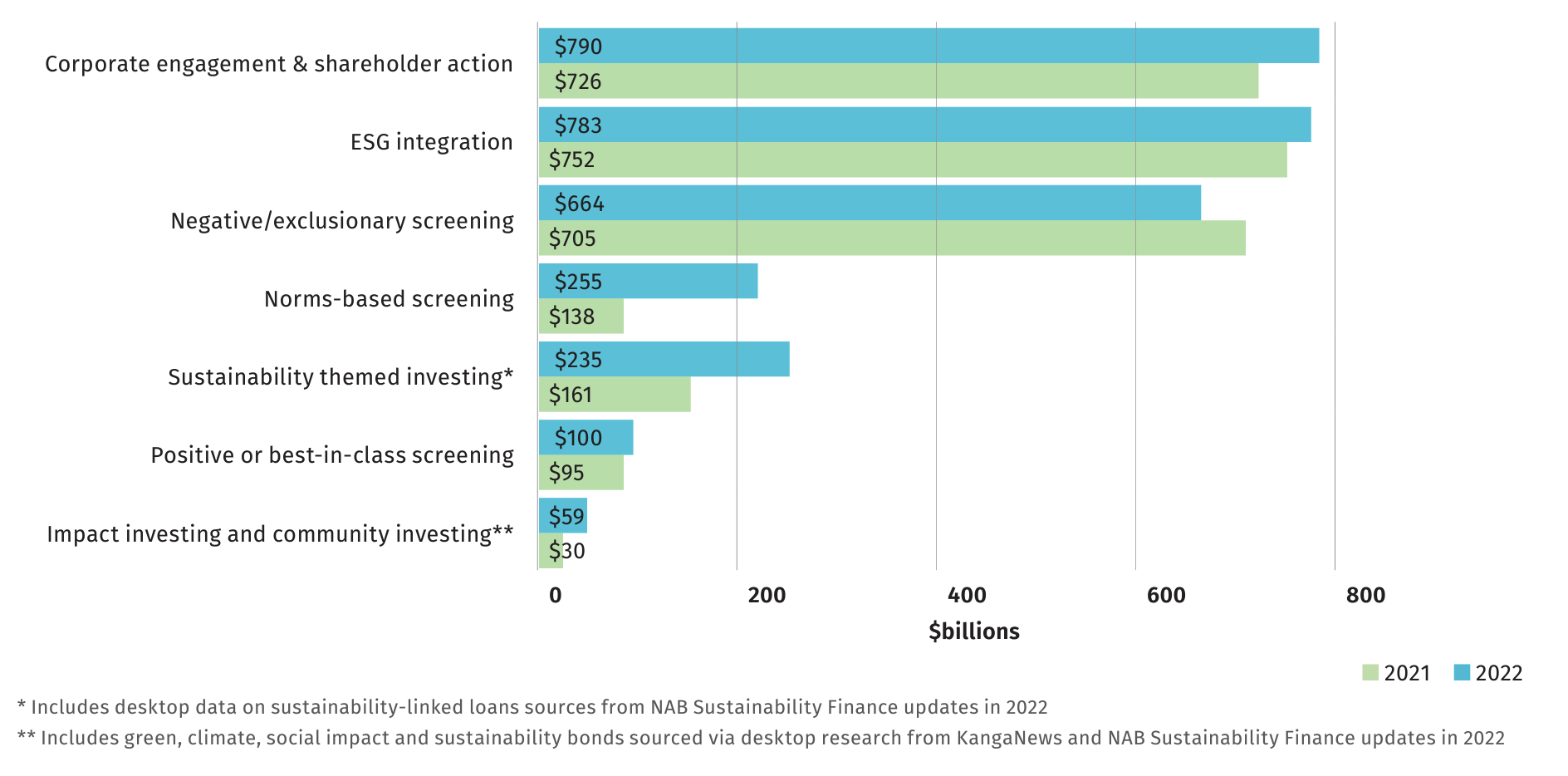
Figure 1.14 Where impact investing sits in the total AUM covered by responsible investment approaches of survey respondents, adapted from RIAA's Responsible Investment Benchmark Report 2023 Australia (31)
In terms of asset allocations and investor commitments, RIAA have shown that investor commitments are mainly committed to green bonds, across a range of products:
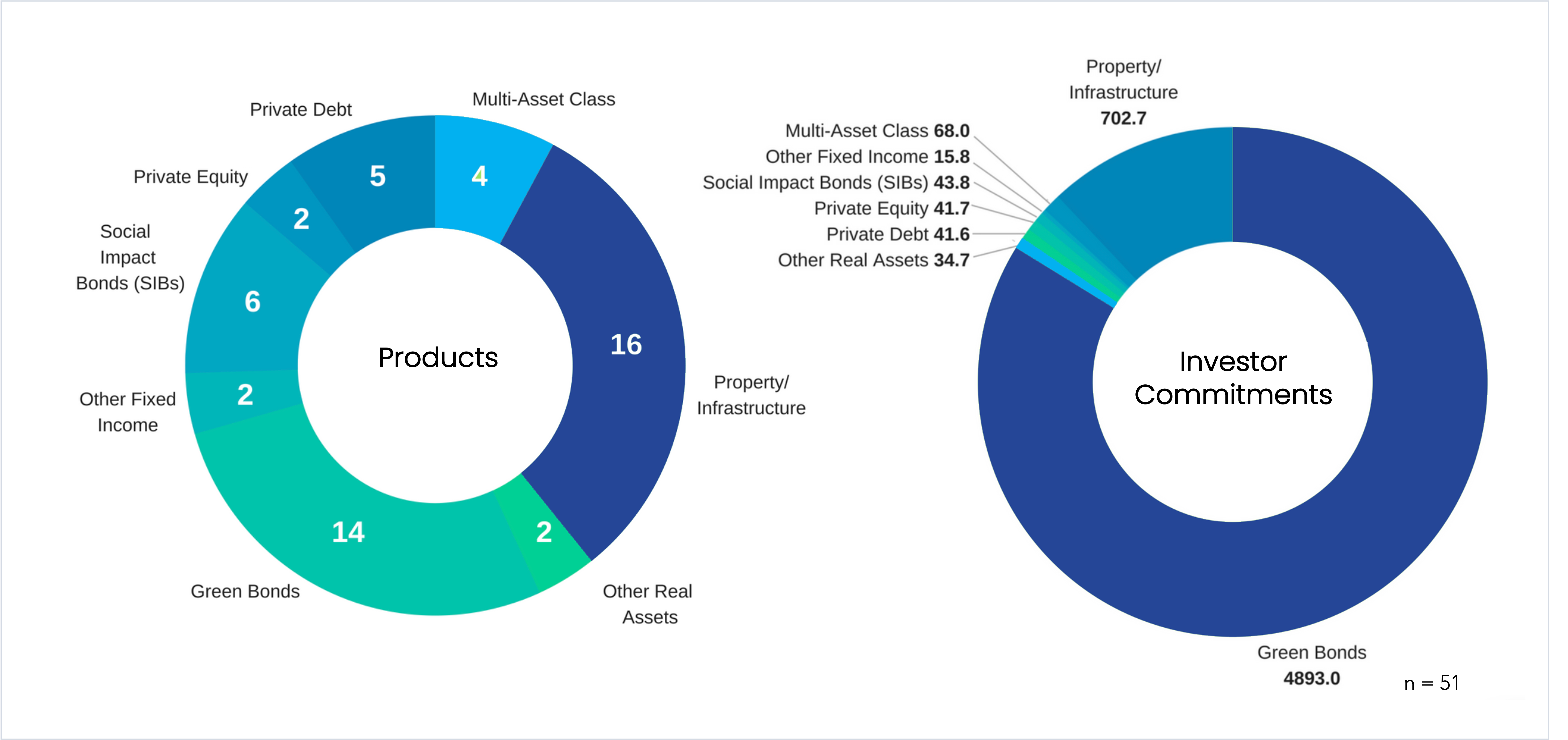
Figure 1.15 adapted from RIAA's Responsible Investment Benchmark Report 2018, the growth of impact investing in Australia. (21)
The diagrams below present data extracted from IIA’S 2016 Investor Report, showing where impact investors are located, their motives for impact investing, and their preferred areas for investment.
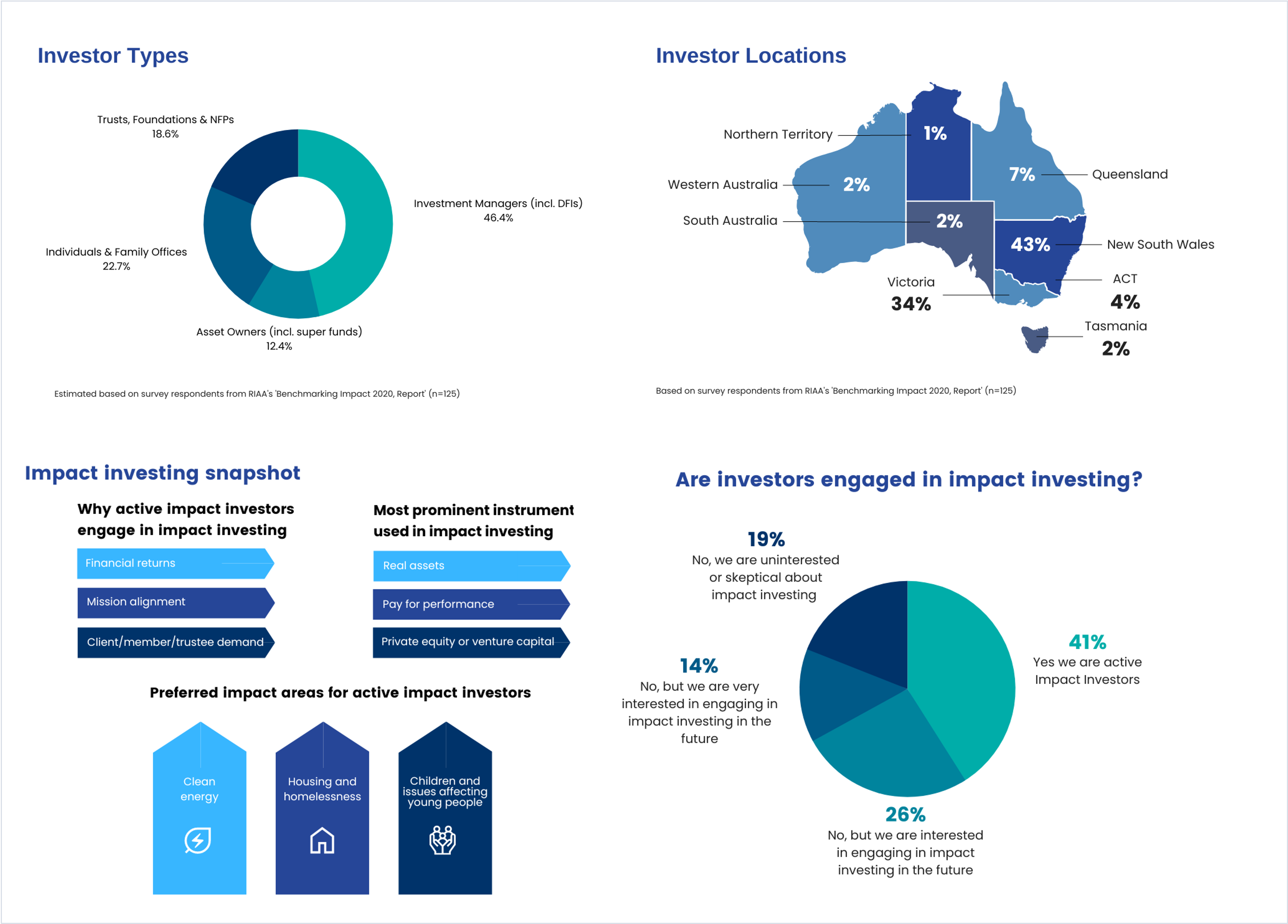
Figure 1.16 Snapshot of Australian impact investors; who they are; why they impact invest; the instruments they use; and the impact areas in which they prefer to invest. Adapted from IIA's Investor Report and RIAA's Benchmarking Impact 2020 Report.
The Responsible Investment Association Australasia found that 92% of investors’ experience in Australia has largely been in line or exceeded their expectation for market returns (20).
Realising the potential of impact investing in Australia
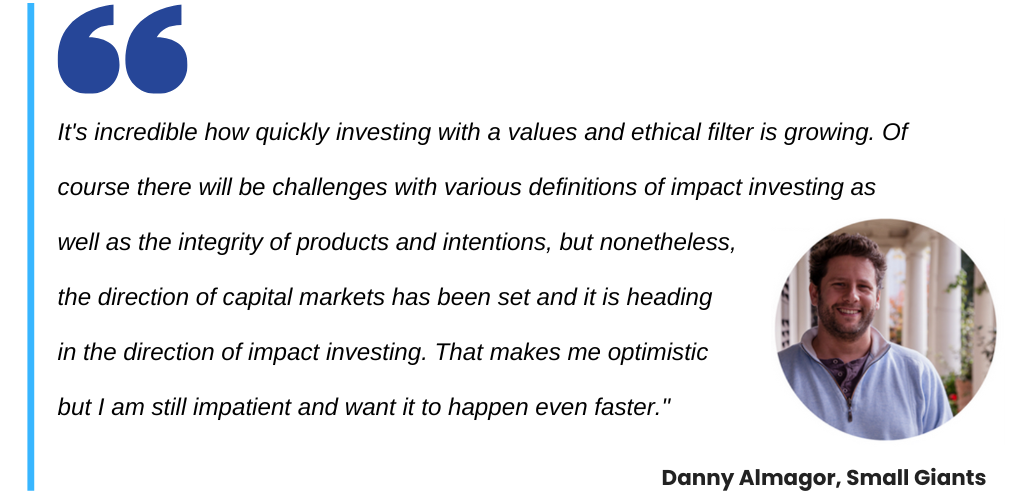
This is an exciting time for impact investing in Australia. As more players enter the market, and new collaborations result in diverse impact investment opportunities, Australians are set to realise the many benefits of a growing and maturing impact investment market. However, Impact Investing Australia (IIA) indicates that the market is still challenged in areas of scale, availability of data, flow of information and market infrastructure. (22)
The Australian Advisory Board on Impact Investing (AABII) maintains that scaling will require a concerted effort from all key stakeholders, with efforts directed to:
- increasing mainstream awareness of what impact investing is;
- educating investors about opportunities in the space; and
- learning how to design for scale and replicate good ideas. (23)
IIA adds the Australian Government must continue to be actively involved to assist the market in reaching its potential scale by identifying new solutions to issues, and investing to reduce risks for new entrants and enhance investor confidence. (24)
Developments in the space do show that some concerted effort from key players, coupled with government support, is paving the way for stronger growth. For example:
- Government support:
- Since 2017, the Department of Social Services has committed more than $50 million to growing the social impact investing market in Australia and creating innovative solutions to entrenched social issues (25).
- In 2018, as a market capability building initiative, the Federal Government committed $8 million to establish the Social Impact Investment Readiness Fund with the aim of building capacity of for-purpose organisations to be investment ready (26).
- In 2020, The Federal Government also announced a $40 million Emerging Markets Impact Investment Fund (EMIIF) that aims to address the financing gap for small to medium enterprises (SMEs) in the region (27).
- Business support:
- In 2017-18, Indigenous Business Australia injected $50 million into impact funds supporting Indigenous communities. (28)
- In 2018, First State Super (now Aware Super), partnered with the NSW Government to stimulate job creation. The super fund committed $100 million, while the Jobs for NSW unit will invest $50 million into the “GO NSW Equity Fund”. The funds aims were to create up to 2,500 new jobs and a further 2,400 by 2025 using recycled funds.
Other market building initiatives include the launch of the Impact Investing Hub in late 2017. The Impact Investing Hub supports the growth of the Australian impact investment sector by improving access to information about Australian impact investing deals and the market, and by helping to connect investors with investment opportunities.
PART 2
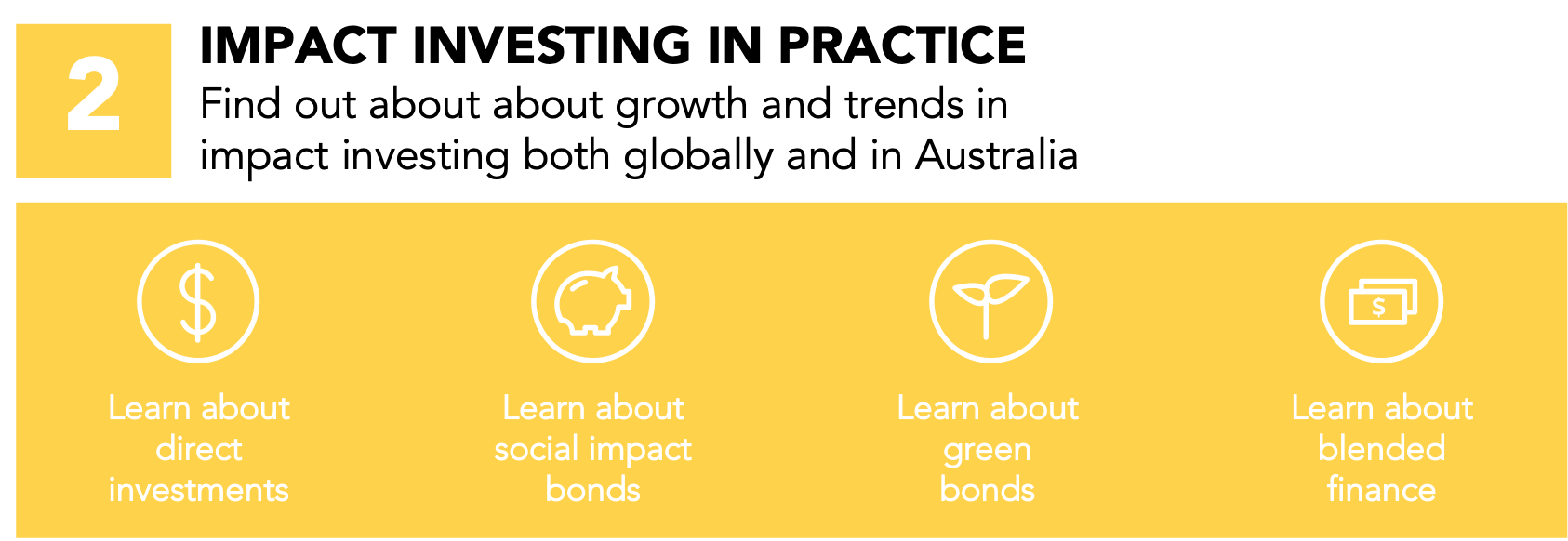
2.1 Overview
The three main areas where impact investments are used are:
- 1.to scale a business or social enterprise;
- 2.to access real assets (eg. property or infrastructure); and
- 3.to finance program delivery. (1)
Asset classes and instruments
Impact investing is an investment philosophy that can be applied across a broad range of existing asset classes:
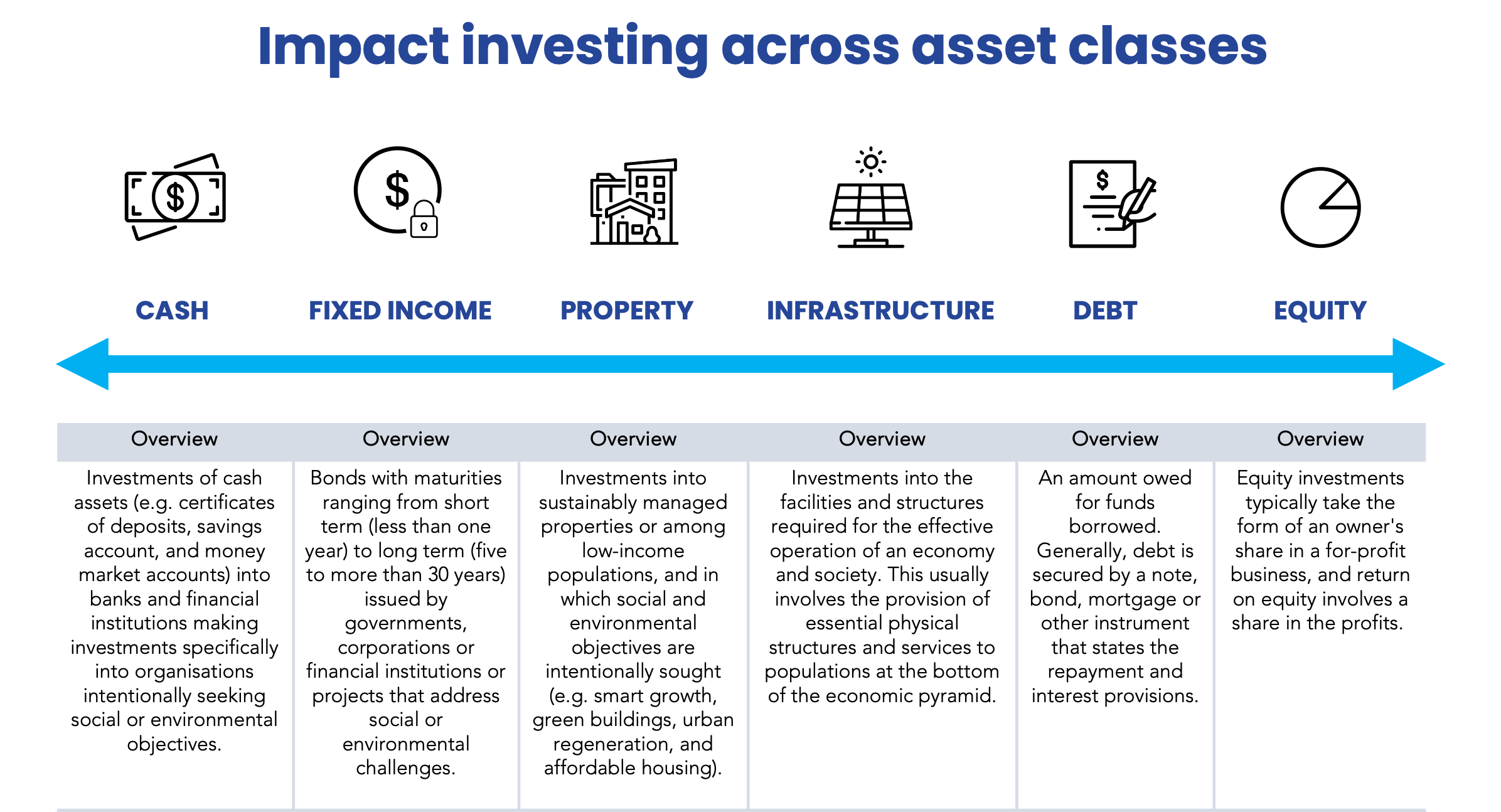
Figure 2.1 adapted from World Economic Forum, An introduction to mainstreaming impact investing initiative, 2013 (2)
Alongside the asset class, impact investments can be thought of in terms of the target financial returns. These range from below market (sometimes called concessionary) to risk-adjusted market rate, and can be made across asset classes, including but not limited to cash equivalents, fixed income, venture capital, and private equity:

Figure 2.2 adapted from the GIIN classification
In practice, impact investors fund many asset classes using a range of instruments, and blend various types of capital in innovative hybrid funding instruments and structured deals to drive impact across the sector (3).
2.2 Direct investments
Depending on your impact investment strategy, you may have a preference to make direct or indirect investments. A direct investment is when you directly invest in an entity creating impact, while an indirect investment is when you make investments into a fund or another investment vehicle that will invest in entities that create impact.
Explore different examples of impact investment deals in Australia and internationally below:
Equity Investments
Impact focus: Disability services, Employment
Description: Online platform linking support workers and people with disability looking for support, allows people with disability and their families to manage relationships with support workers whose tax and super payments, insurance, payroll and workplace health and safety requirements are taken care of by Hire up.
Structure: $2.4m Equity Raising
Financial Return: Undisclosed
Impact created: Made 8,500+ support connections, provided 600,000+ hours of support and saved $5.3m by Hire up users from their packages to be used for extra hours of support.
Impact focus: Recycling, Environment, Food Wastage
Description: 9.5 million tonnes of food is discarded each year of which 400,000 and 600,000 tonnes are accessible, edible and quality food.
Yume is a revolutionary food rescue platform designed to reduce the amount of commercial food waste heading to landfills each year. Yume is Australia's first surplus food online marketplace where wholesale and retail suppliers and primary producers can post surplus edible and quality food for sale. Yume also facilitates the donation of unsold products to food charities.
Structure: $2.6m Equity Raising
Financial Return: Undisclosed
Impact created: Diverted 176,241kg from landfill and donated 23,209kg to food rescue organisations.
Impact focus: Children, disability
Description: : AbilityMade is an innovative technology company engaged in the customisation and digital manufacture of custom-made orthoses for children with disability. AbilityMade partners with orthotists to leverage advances in 3D scanning and 3D printing to dramatically increase the supply of orthoses.
Structure: $1.0m Equity Raising
Financial Return: Undisclosed
Impact created: Undisclosed
Debt Investments
Impact focus: Mental Health, Employment
Description: Vanguard Laundry Services (VLS) is a social enterprise commercial laundry creating employment opportunities for people previously excluded from the workforce, predominantly due to mental health conditions
Structure: A loan of over $2.1 million. Grants worth $3.2 million and over $770,000 in pro bono assistance
Financial Return: Undisclosed
Impact created: In the first year of operations, Vanguard Laundry Services reduced the number of participants reliant on Centrelink payments from 90.5% to 76.2%, and increased the median fortnightly income of participants by $392. This represented a 38.9% reduction in housing affordability stress.
Impact focus: Employment, Disability services
Description: Jigsaw is a job-focused social enterprise that provides holistic training and employment for people with a disability Structure: $3m capital raise consisting of $2.1 debt investment and $0.9m grant funding
Financial Return: Undisclosed
Impact created: Opened new hubs in Melbourne and Adelaide with plans in place for Canberra and Perth. Further developed Jigsaw Connect, which transitions job ready candidates with disability to open employment
Impact focus: Employment, Disability services
Description: Start-up dedicated to empowering and placing autistic talent into specialised IT roles. Structure: Beneficial Outcomes Linked Debt (BOLD), a $600,000 impact-linked loan scheme, whereby the loan balance decreases when the borrower’s impact increases. More details.
Financial Return: Internal Rate of Return (IRR) expected to be between 5–15%, depending on the level of impact achieved
Impact created: Placement of 60 people in IT jobs
Social Impact Bonds & Payment by Outcomes
Note: Social Impact Bonds & Payment by Outcomes (PBO) are discussed in more detail in the subsequent sections below.
Impact focus: Homelessness, Employment
Description: The Aspire Social Impact Bond (Aspire SIB), Australia’s first homelessness focused SIB, raised private capital to fund the innovative Aspire Program, which is designed to make a difference to the lives of people experiencing homelessness in Adelaide. Hutt St Centre, a homeless services specialist, delivers the program. The program is also supported by housing partners including Common Ground Adelaide and Unity Housing. The $9 million Aspire SIB funds the program to work with up to 600 homeless individuals over 4 years. Structure: $9m bond
Financial Return: 8.5% target return over 7.75 years
Impact created: Funds the Aspire program for ~600 homeless persons in Adelaide for 4 years.
Impact focus: Mental Health, Community Services
Description: The Resolve Program is a recovery-orientated community support program in the Western NSW and Nepean Blue Mountains Local Health Districts. The Program offers a combination of a residential service for periodic crisis care, integrated psychosocial, medical and mental health support, and a warm line for after-hours peer support. Social Ventures Australia raised and manages the $7m Social Benefit Bond which supports the Resolve Program.
The Resolve SBB aims to improve the mental health and wellbeing of participants, while generating significant savings for the State through a reduction in participants’ utilisation of health and other services, by reducing the number of days spent in hospital. These savings will be shared with the mental health service provider, Flourish, to fund the delivery of the Resolve Program, and with investors to provide a financial return on their investment. Approximately 530 adults will be enrolled in the Resolve Program over five years.
Structure: $7m bond
Financial Return: Internal Rate of Return (IRR) of 7.5% p.a. forecast over the 7.75 year note term
Impact created: Approximately 530 people enrolled in the Program can benefit from the service in the Western NSW and Nepean Blue Mountains LHDs over a five-year enrolment period:
-Program participants will collectively spend an estimated 13,300 days at Resolve centres over a seven-year service delivery period, diverting them from hospitalisation
-Target 25% reduction in the use of the health services compared to the Control Group
-$30 million in savings to the State through reduced consumption of health and other services
Impact focus: Employment services
Description: White Box Enterprises is a social enterprise intermediary focused on supporting and scaling job-focused social enterprises.
Structure: $3.8 million payment by outcomes trial in partnership with the Department of Social Services. Over 9 months, up to 170 people living with a disability will be employed by one of nine jobs-focused social enterprises selected to participate in the trial. The social enterprises will receive outcomes-based payments when participating employees maintain employment after 6, 12 and 18 months, with additional payments where a participant chooses to move on to work elsewhere.
Financial Return: Undisclosed
Impact created: Trial commenced September 2022 and is ongoing
Property
Impact focus: Sustainability
Description: IIG acquired the TAC building in Geelong in December 2014 for $95.8 million on a net passing yield of 7.5% per annum. It is an eight level A-Grade office building, built new for the TAC in 2008, who were the anchor tenant on a long lease. IIG sold the property in March 2018 for $115.25m on a passing yield of 6.83%.
Structure: Unlisted unit trust with $41.175 million equity from unit holders and $62.27 million loan facility from NAB.
Financial Return: 10% average cash yield. Overall IRR to unit holders of 14.9% (post fees).
Impact created:
Climate: IIG installed 39.9 kW of additional rooftop solar generation capacity abating over 47.8 tCO2e to June 2017. NABERS energy rating improved to 5.5 Stars from 5.0 Stars at acquisition.
Water: Connected toilet flushing to an existing 20,000 litre rainwater harvesting tank and installed an additional 5,000 litre tank, avoiding over 257,000 litres of municipal water from being wasted..
Place & Vitality: IIG created the ‘Impact Workshop’ in April 2017, a 40 desk co-working and innovation space for social purpose projects and organisations in the Geelong area. 20 desks were leased to TAC and Sprout Ventures manages the other 20 desks.
Impact focus: Environmental
Description: The IIG K1 Property Trust owns Kingsgate, a new Lendlease-developed office building, awarded the highest available NABERS energy rating: 6 stars. It is a 10 level commercial building at the gateway to the Kingsgate commercial precinct within the Brisbane Showgrounds urban regeneration precinct. It is tenanted to Lendlease, Medtronic and SMEC. IIG acquired the building for $141.2m in July 2015.
Structure: $63m of equity from unitholders, $78m of senior secured debt from NAB
Financial Return: 9.95% at end of FY17
Impact created: An Environmental Steering Group was established, with representatives from all major tenants. IIG works closely with tenants to monitor environmental performance and implement tuning and upgrade measures as identified, achieving a NABERS Energy Rating of 6 Stars. IIG allocates a portion of the management fees to the IIG Catalyst Fund, with the aim of directing funds into high impact opportunities.
Infrastructure
Impact focus: Renewable Energy
Description: Sydney Renewable Power Company (SRPC) provided funding for Australia's largest CBD Solar Array, on the roofs of the Sydney International Convention Centre Sydney (ICC Sydney).
The installation is 520kW, and all of the energy generated by the solar array is purchased and used by the ICC Sydney based on a 25-year power purchase agreement. A secondary revenue source is through marketing renewable energy offsets or certificates.
Structure: $1.55m loan in 2016 as initial bridge, $1.43m follow-up equity raising in 2017 to repay loan & fund working capital
Financial Return: ~4% (expected)
Impact created: Financed a 520kW solar photovoltaic installation on the rooftop of ICC Sydney, which will generate enough energy to power more than 100 houses. Following installation in mid-2016, first power was generated in December 2016, which enabled the first invoice to be issued in January 2017.
Impact focus: Renewable Energy, Indigenous community
Description: The 36-kilowatt solar power system was installed on the roof of a workshop and machinery shed in the Kurrawang Aboriginal Christian Community near Kalgoorlie as a joint initiative of the Not for Profit Alternative Technology Association (ATA) and the Kurrawang Community Board in 2016. Believed to be an Australian first, a $52,500 impact investment loan was provided by the McKinnon Family Foundation and the CAGES Foundation. The loan will be paid off by the community in 5 years, with savings on electricity bill exceeding monthly loan repayments.
Structure: $52,500 impact investment loan
Financial Return: ~8% over 6 years
Impact created: Expected to displace 20% of the community’s electricity use and to offset about 60 tonnes of carbon dioxide each year, equivalent to removing about 17 cars from the roads.
Fixed income
Impact focus: Climate Change, Renewable Energy
Description: CBA issued a 5-year Climate Bond in 2017. The proceeds fund eligible projects in renewable generation, energy efficient buildings and low carbon transport. Eligible projects which comply with the Climate Bond Standards and eligible for certification have been nominated for this climate bond. Eligible projects that meet the eligibility criteria of the Climate Bond Standards could be Nominated Projects including (but not limited to) solar, wind, hydro power, transport and energy efficient buildings.
Structure: $650m bond: $450m through a fixed income issue, $200m through a floating rate note. More details.
Financial Return: 92 basis points above relevant reference rate, 5 years
Impact created: Through supporting low carbon and climate resilient projects and assets, transition to a low carbon economy is enhanced
Impact focus: Sustainability, Environment
Description: Australian Catholic University (ACU) issued a $200 million sustainability bond in July 2017. The bond raised funds for a combination of social projects and green buildings that deliver positive social and environmental outcomes in line with the International Capital Markets Association's sustainability bond guidelines. ACU is the first university in the world to issue a Sustainability Bond. The debt is rated Aa2 (Stable) by Moody’s Investors Service and was arranged by National Australia Bank.
Structure: $200m Fixed Rate medium term note (MTN)
Financial Return: ~3.7%, paid semi-annually over 10 years
Impact created: Supporting the construction of green buildings as well as research and development programs with social impact.
Cash
Impact focus: Community
Description: Bank Australia is a customer owned responsible bank. Without shareholders, the bank’s profits are returned to its customers through better rates and fees. The funds are invested to create positive social and environmental change. It currently has 140,000 people and community sector organisations as customers.
Impact created: Profits are reinvested back into the bank to provide all customers with fairer feeds and better interest rates. They also invest 4% of the bank's after tax profit in a community investment program.
Fund managers and funds
In Australia, most products offered by intermediaries have been private equity, bonds, and property or loan funds. The table below highlights examples of Australian impact investment fund managers and some of the funds they have established.
Fund Manager | Example Funds | Description | |
| Impact Investment Group sources and develops investments that generate social and environmental value throughout the investment’s life, as well as delivering excellent financial returns for investors. | ||
| Impact Investment Fund is a specialised Impact Advisory and Fund Manager that aims to empower social innovators through connecting them to investors and offering a range of investments. | ||
| Indigenous Business Australia is a progressive, commercially focused organisation that promotes and encourages self-management, and sufficiency, as well as economic independence for Aboriginal and Torres Strait Islander peoples. | ||
| SEFA connects investor funding with social enterprises and mission led organisations. SEFA offers loan finance and capacity building support to enable community, environmental and indigenous enterprises to thrive and grow sustainably. It offers investors both social impacts and financial returns. | ||
| The Social Impact Investment Trust and the Diversified Impact Fund invest capital to help solve entrenched social problems. Investments include debt and equity into social enterprises, housing solutions and social impact bonds. |
Figure 2.3. Examples of Australian impact investment fund managers and associated funds.
2.3 Social Impact Bonds & Payment by Outcomes
Social Benefit Bonds or Social Impact Bonds (SIBs) are a type of financial instrument, and a form of social impact investment that have become increasingly popular - particularly in OECD countries - in recent years (5).
Combining in a single tool three core elements - entrepreneurship, innovation and investment - SIBs enable private investors to provide up-front funding to service providers to deliver improved social outcomes and address public concerns. If these outcomes are delivered, resulting government savings pay back the original investment plus a return (6).
As pressures on public budgets increase, a financing mechanism for social initiatives that promises to mitigate public sector risk, increase effectiveness, and pay for services now while requiring public contributions later, is likely to attract support (7). Since the first SIB was launched in 2010, there have been over 230 impact bonds globally in ~40 countries representing an investment of over $460 million in capital (8). Globally, SIBs are mobilising investments towards programs that are tackling complex social issues such as refugee employment support, loneliness among the elderly, rehousing and re-skilling homeless youth, and diabetes prevention.
Social Benefit Bonds provide a mechanism to share risk across investors, service providers and government. They offer their investors a blended return combining both financial and social outcomes (9).
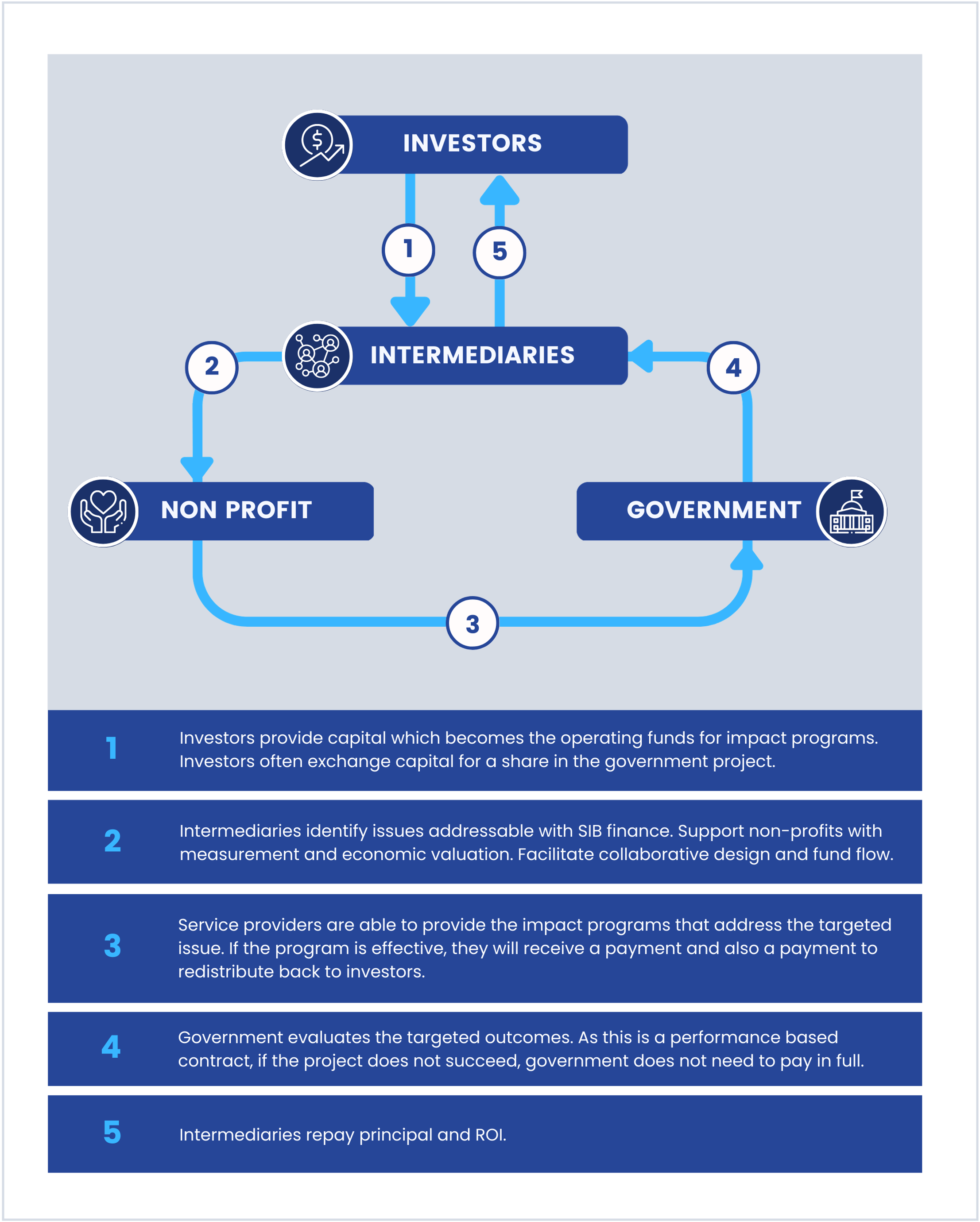
Figure 2.4 Overview of how a Social Impact Bond works.
There are a number of Social Impact Bonds in the market in Australia, with New South Wales, Queensland, South Australia, and Victoria all active in market (10):
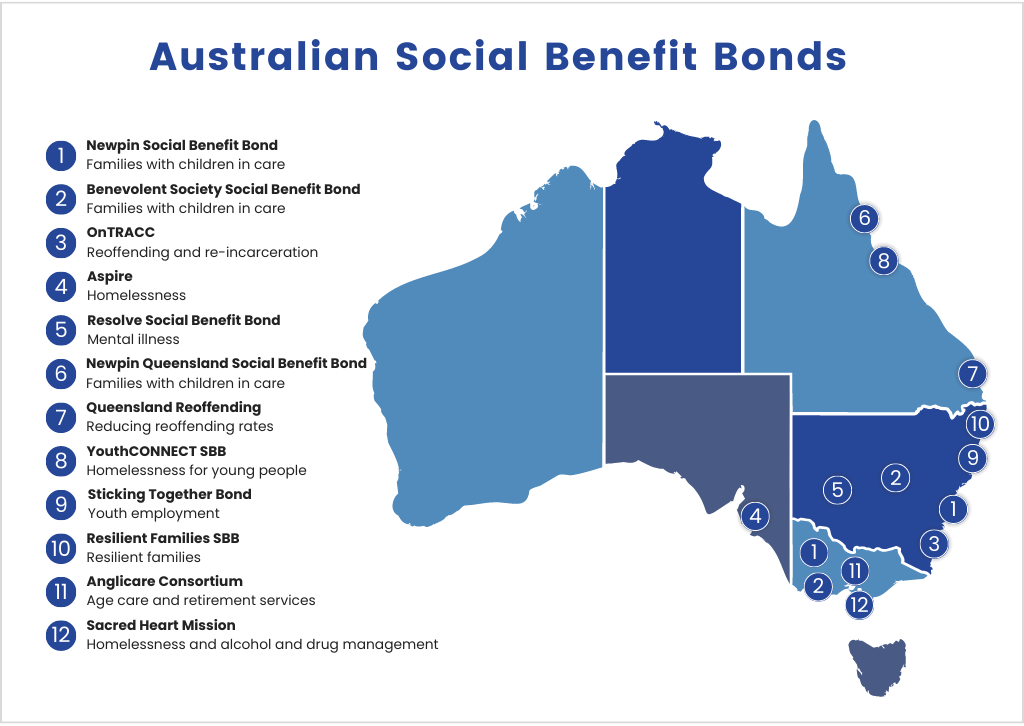
Figure 2.5 Examples of Social Impact Bonds in Australia, based on Emma Tomkinson's SIBs in Australia (10)
Payment by Outcomes (PBO)
Social Ventures Australia (SVA) explain that Payment by Outcomes (PBO) are an outcomes-based contracting approach that governments use to commission a program for a clearly defined target cohort, with clearly defined outcomes. Typically, the performance of the program is measured relative to a baseline or counterfactual and payments are linked to the program’s performance as measured by the agreed outcome metrics.
This type of arrangement generates a financial risk for a service provider relative to traditional government grant funding – if performance targets are not achieved, then the service provider won’t be paid to cover its cost of delivering the program.
Spotlight on..
Aspire: a SIB focused on homelessness

Aspire Program
The Aspire Program is based on a housing first intervention model, and founded on the principle that people benefit more through first being given suitable housing followed by support in areas like health, education and employment. Participants will be provided stable accommodation, job readiness training, pathways to employment and life skills development. They will also have the long term support of a dedicated Case Manager to connect them with wider support services. (11)
The SIB
Aspire SIB is Australia’s first social impact bond focusing on homelessness and offers investors the opportunity to obtain a competitive financial return while making a lasting difference to the lives of people in Adelaide experiencing homelessness. The bond, underwritten by the South Australian Government, funds the Aspire Program, run by the Adelaide based homelessness services specialist Hutt St. Centre, in collaboration with community housing providers Common Ground Adelaide and Unity Housing Company.
The bond was oversubscribed and raised $9 million from private and philanthropic investors.
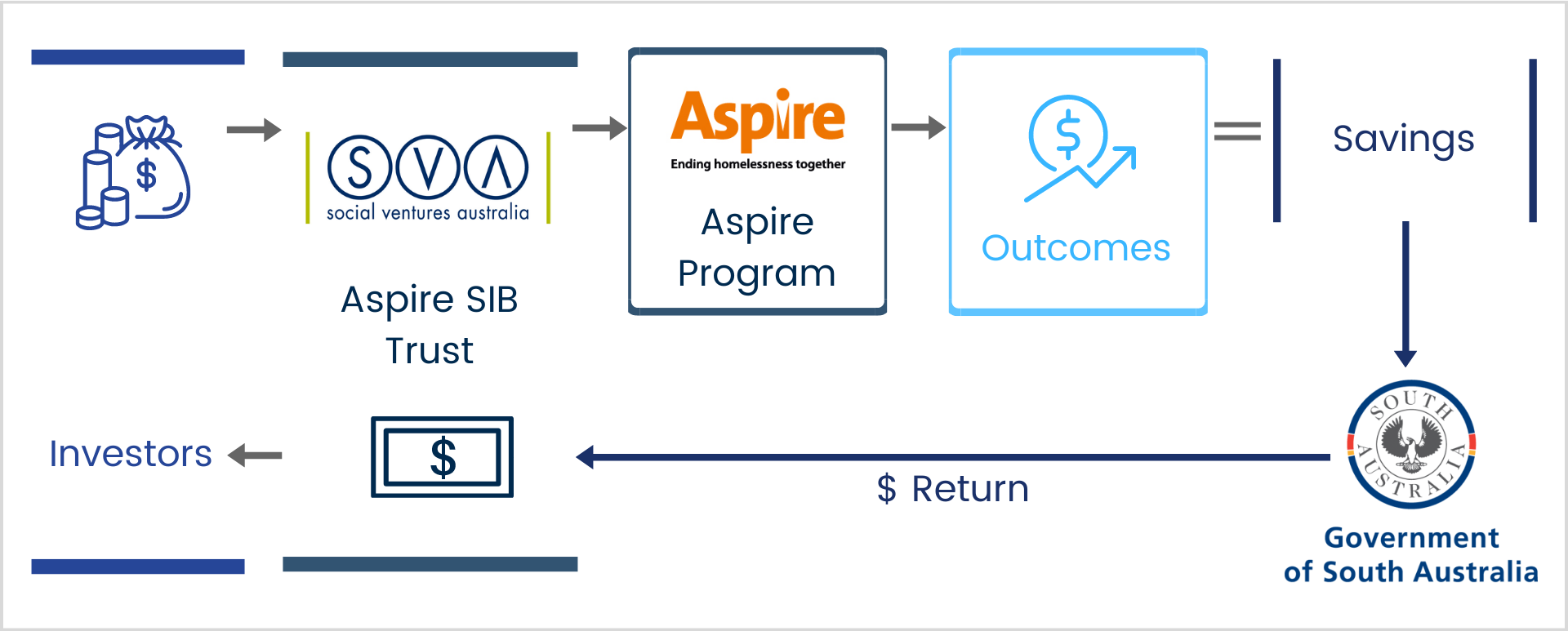
Key Features
- Investor returns are determined by Government payments to the Aspire SIB Trust, which are based on savings generated.
- Outcomes are determined by measuring health, justice and homelessness service utilisation relative to a historical baseline.
- A bond term of 7.75 years with a 2% p.a. fixed coupon over 4.75 years, then performance coupon based on the level of the Trust’s assets.
- In the event targets are met, investors can yield an estimated 8.5% per annum.
- Termination rights for poor performance to limit downside loss to approximately 50% of principal.
- Target scenario estimated return 8.5% p.a. (objective only).
Anticipated Impact
Approximately 600 adults who are experiencing homelessness are expected to be referred to the program over a four-year period, where each person will be provided support for up to three years.
An investor
The Aspire Bond presented a unique opportunity for the WC Rigby Trust, established to provide 'low cost housing for the poor'. Ben Clark of Australian Executor Trustees, which was appointed trustees of WC Rigby Trust in 1913, realised that Aspire presented an opportunity for the trust to invest capital to achieve a mission-aligned outcome. As Ben notes, before deciding to invest:
Our investment committee determined that critical to calculating the investment risk, was an understanding of the 'social' or program risk. In order to provide a qualified opinion, we needed to conduct additional due diligence on the capacity and capability of the charity partner delivering the Aspire program and it was not until we'd met with the CEO of Hutt St Centre and toured their premises, were we able to complete our due diligence and make a decision to invest.'
2.4. Green bonds
“Green bonds are innovative financial instruments where the proceeds are invested exclusively (either by specifying the use of the proceeds, direct project exposure, or securitisation) in green projects that generate climate or other environmental benefits...Their structure, risk and returns are otherwise identical to those of traditional bonds." UNDP, Financing Solutions for Sustainable Development (12)

The market for green bonds (also known as climate bonds) is one of the fastest growing in the world, estimated to be over USD 500 billion as of 2021 (13). The Australian green bond market is still relatively small, but current trends indicate it is growing rapidly as a diverse range of funds from institutional to ‘mum and dad’ investors subscribe for its bonds. Australia’s impact investing market is driven largely by the increase in green bonds. According to RIIA's Responsible Investment Benchmarking 2022 Report, green and social impact bonds represent 82% of the total impact investment market in Australia. Green, climate and social impact bonds were valued at $24.6 billion with the total impact investing market in Australia valued at approximately $30 billion (14).
In 2020 there were 10 major green bonds involving more than 100 Australian institutions (15). In 2018 the NSW Government raised $1.8 billion in green bonds, issued under the newly established Sustainability Bond Programme which will directed into projects that will deliver environmental and social benefits for NSW. The bonds have been issued by NSW Treasury Corporation (TCorp), the State’s financial markets provider and complement existing general purpose bonds already issued by TCorp. Other Australian organisations that are issuing green bonds include CBA, NAB, Westpac, Stockland, and Queensland Treasury Corporation. (16)
2.5 Blended finance and catalytic capital
The wide variety of types of capital available in social finance - and the complex set of risk and return calculations attendant on each type - offers opportunities for innovative structured deals and funds that do not exist outside of this [social impact] sector. It is suggested… that only such blends of capital may offer the critical support needed by socially entrepreneurial organisations if they are to tackle the ‘wicked problems’ currently confronting the world.” Alex Nicholls, Rob Parson and Jed Emerson, Social Finance (17)
Blended finance involves bringing together investors with different risk and return requirements to enable transactions that may struggle to attract pure commercial funding.
To leverage the significant capital needed to accomplish large-scale and sustainable impact, structures are needed that appeal to investors seeking full risk-adjusted returns. By deploying instruments such as grants, guarantees and impact-first capital to de-risk investments and lower the cost of capital, blended finance helps attract investors with a lower risk tolerance. Indeed, blended financed transactions do not require that all investors must have a social impact motivation.
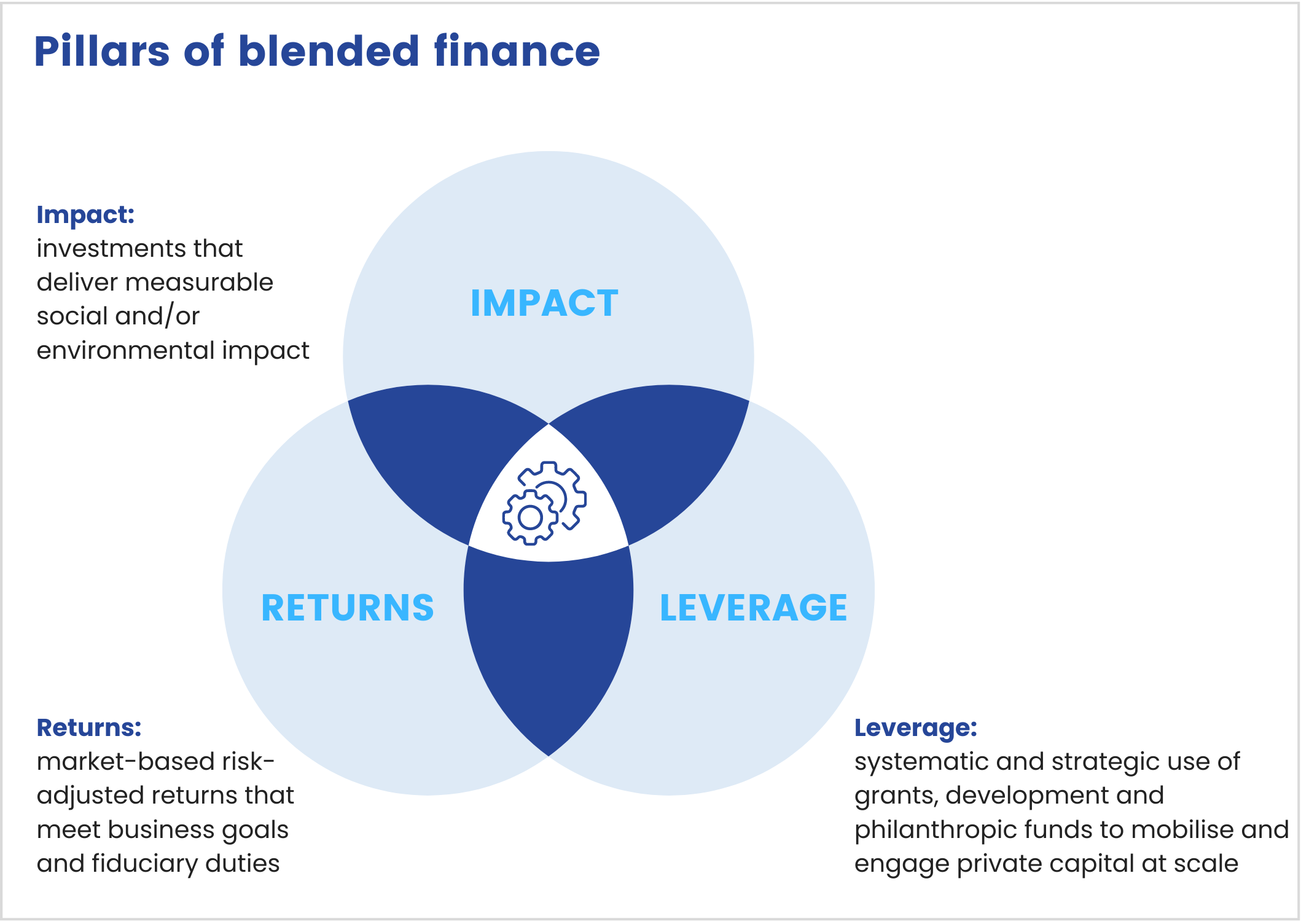
Figure 2.6 Adapted from Blended Finance Vol 1: A primer for development finance and philanthropic funders, OECD & World Economic Forum, September 2015. (18)
Blended finance enables each public or philanthropic dollar to go further than it would on its own. For example, for every $1 received as a grant (eg. from a foundation), a deal may attract $5 from the private sector, given the improved risk-return profile attributed to the donor taking a first-loss position in a deal, or by providing a risk-sharing instrument like a guarantee. (19)
Globally, there is increasing interest in using blended finance to achieve the Sustainable Development Goals (SDGs). Blended finance transactions have effectively mobilised over USD 51.2 billion towards the 17 SDGs. These ambitious targets require a new level of global cooperation to fund the required projects. As Lord Malloch-Brown, a former UK diplomat who chairs the Business and Sustainable Development Commission said (20):
“Action is needed end-to-end across the whole investment system to scale up the use of blended finance, if we are serious about closing the funding gap for the sustainable development goals.”
In blended finance arrangements, the philanthropic or impact-first capital may be considered as firs-loss capital. First loss capital refers to capital provided by an investor or grant-maker who agrees to bear first losses in an investment in order to catalyse the participation of co-investors that otherwise would not have entered the deal. There are a number of instruments that are commonly used to provide first-loss capital:
Instrument | Description |
Grants | A grant provided for the express purpose of covering a set amount of first-loss |
Guarantee | A guarantee to cover a set amount of first-loss* |
Subordinated Debt | The most junior debt position in a distribution waterfall with various levels of debt seniority (with no equity in the structure) |
Junior Equity | By taking the most junior equity position in the overall capital structure, the provider takes first losses (but perhaps also seeks risk-adjusted returns); this includes common equity in structures that include preferred equity classes. |
Figure 2.7 Adpated from the GIIN
*Note: if a Private Ancillary Fund (PAF) guarantees a financial institution’s loan to a Deductible Gift Recipient, the PAF can claim the discount between its income and the market interest rate as part of its distribution requirements (see Part 4, example 5).

Figure 2.8 highlights the differences in structure between regular finance and blended finance.
The term 'catalytic capital' refers to grants, guarantees, letters of credit, collateralisation, subordinated loans, concessionary or cornerstone investments that trigger additional capital not otherwise available. Catalytic capital often accepts lower returns to accommodate the economics of high-impact organisations that are profitable but not profit-maximising, whether due to an early stage of business development, tough markets, or a focus on impoverished populations.
Examples of how blended finance and catalytic capital have been used to bring high impact potential opportunities to life are explored in the Spotlights on the Vanguard Laundry Services, and the Journey to Social Inclusion deals below.
Spotlight on...
VANGUARD LAUNDRY SERVICES
The most exciting part about getting this deal up from the ground is seeing the impact it’s creating and its potential for replication. We are changing people’s lives with a blended finance model that really works, showcasing its massive potential.” Alex Oppes, SVA

Vanguard Laundry Services is a custom-built commercial laundry with a social outcome purpose of creating employment opportunities for Australians with mental illness. Involving over 50 parties, the Vanguard deal financed the building of the largest industry in Toowoomba, Queensland. The lead arrangers included Social Ventures Australia (SVA) and Vanguard’s founder, Luke Terry. Minter Ellison and King & Wood Mallesons provided pro bono legal assistance with Vanguard’s contracts and legal structure. This remarkable project demonstrates the challenges of leveraging social procurement and how to overcome them. (1)
Deal structure
The Vanguard Laundry Services deal was funded and developed through a complex blend of monetary and in-kind donations, government grants and fee waivers and debt financing, including:
- 1. The land for the laundry site was donated by Hallmark Property (alongside a project management fee waiver). The total value of the land and fee waiver was over $500,000.
- 2. $850,000 in monetary donations were committed by partners, including $600,000 from the Paul Ramsay Foundation.
- 3. Over $1,200,000 of debt was obtained through Westpac for the purposes of equipment financing. This debt was secured against the land donated by Hallmark Property.
- 4. $1,000,000 in Federal Government funding as well as a waiver of $150,000 in council fees by the Toowoomba Regional Council. The Federal Government funding was secured over the course of five instalments, with certain conditions precedent to funding (e.g. funding from other partners confirmed).
Outcomes
In the first year of operations, Vanguard Laundry Services reduced the number of participants reliant on Centrelink payments from 90.5% to 76.2%, and increased the median fortnightly income of participants by $392. This represented a 38.9% reduction in housing affordability stress.
After one year, all participants were able to record some employment experience (compared to 13.6% noting ‘no employment experience’ prior to commencement). Furthermore, 56.5% of employees recorded a history of ‘significant employment experience’ after a year of operations (compared to 31.8% 6 months prior to commencing). 78% of participants in the Vanguard Laundry Services program reported an improvement in health since commencing employment, with direct hospital savings estimated at just under $200,000.
The estimated five-year welfare savings to the government as a result of the program are estimated to be over $8.7m.
(1) https://www.socialventures.com.au/sva-quarterly/social-procurement-success-toowoomba/
Spotlight on...
JOURNEY TO SOCIAL INCLUSION
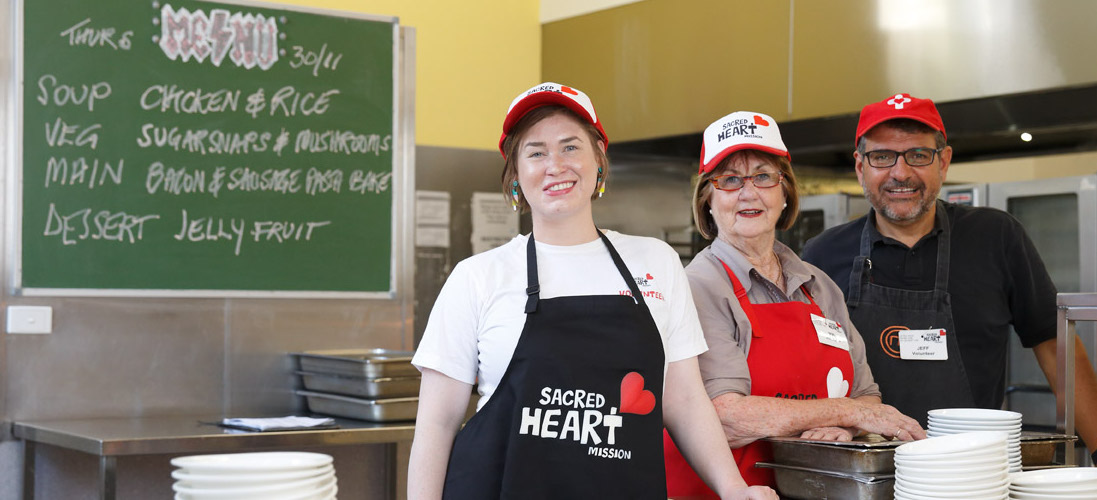
Traditional funding models for homelessness services don’t cut it for the client groups we’re targeting... J2SI's Social Impact Investment enabled us to access different types of capital, the types of capital that will allow us to provide support for sustainable change." Catherine Harris, Sacred Heart Mission
Sacred Heart Mission's (SHM) Journey to Social Inclusion (J2SI) is an innovative departure from traditional short-term, re-active homelessness interventions. It takes a housing-first approach and seeks to address homelessness and its associated challenges by providing relationship-based, long-term support for mental health and well-being issues, as well as resolving any drug and alcohol issues. J2SI also helps people to build skills and contribute to society through economic and social inclusion activity.
Structure of the deal
The J2SI Social Impact Investment (SII) is a unique partnership between government, the social services sector, investors and philanthropy, where the risk of achieving the outcomes for clients is shared between the parties, with the aim of achieving positive social change. The J2SI SII is the first social impact investment negotiated with the Victorian Government. The financing structure pays a return, based on agreed achieved social outcomes such as people staying housed and a lower use of healthcare services.
In contrast to a traditional Social Impact Bond, the SII accesses lower cost debt which is guaranteed by philanthropy if the outcomes for clients are lower than expected. In accordance with paragraphs 19 of the Private Ancillary Fund Guidelines 2009 and Public Ancillary Fund Guidelines 2009, the guarantee qualifies as a benefit and forms part of the annual distribution, as a below market rate guarantee fee is payable.
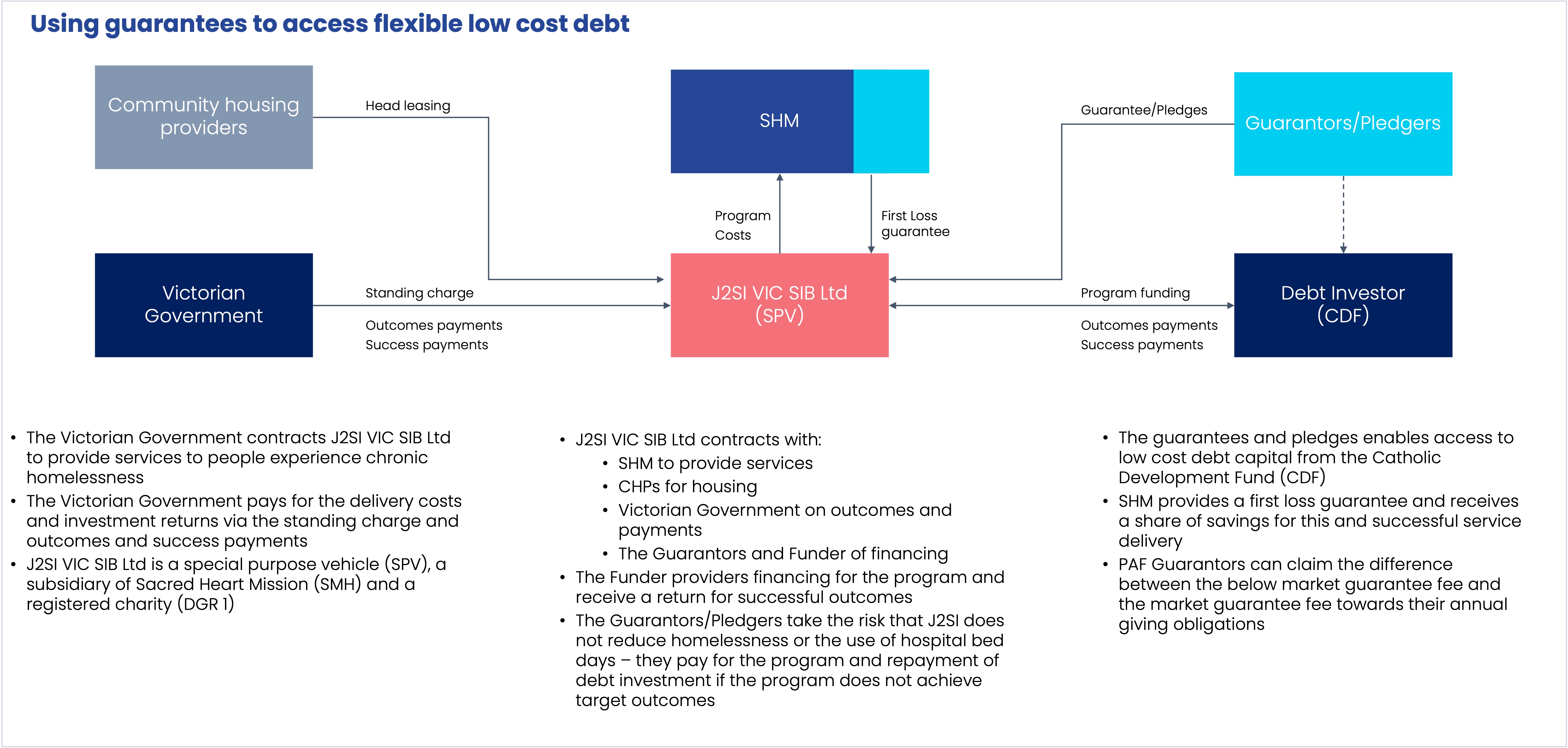
Social impact
Around 116,400 Australians are experiencing homelessness, and it is estimated between 23,400 and 38,300 of those people are adults trapped in a cycle of long-term, chronic homelessness with compounding challenges impacting their health, well-being, and employment. SHM, through J2SI, takes an evidence-based approach to homelessness, helping people with complexities put homelessness to bed and instead build a stable, independent life. J2SI SII will expand SHM’s J2SI program, to help 180 people in Melbourne break the cycle of homelessness over five years with three cohorts receiving three years of service. Service delivery commenced in August 2018. This will create lasting positive social change for communities and individuals.
Catalytic effect
In combining government financing, philanthropic guarantees, and low-cost debt, this transaction represents the first time low-cost debt with guarantees has been used to finance a SII in Australia, and demonstrates the strategic role of philanthropy in enabling social finance deals.
Catherine Harris, General Manager for Business Development at Sacred Heart Mission, says philanthropists were interested in the approach, however, a few were deterred by the concept of a “zero fee”, which was difficult for some investment committees even when the activity aligned with the foundation's mission. Harris commented:
Negotiating such a complex finance model was no easy feat. We've brought philanthropy and investors into the financial structure to share the risk. We did face challenges securing the partnerships, however. The challenge lay in getting people to understand the nature of the transaction and the benefits of long-term investing. The SII shows philanthropists can use their money, not as a handout, but also to enable programs such as J2SI to happen.”
Longer term, this transaction allows the J2SI model to be scaled and replicated under licence by social service organisations and state governments across Australia. SHM is developing a “J2SI product suite” and an Evaluation and Learning Centre to continue to refine the model so there is a real opportunity to expand J2SI around Australia to end chronic homelessness nationally using the new lower cost financing structure.
The NAB Foundation was one philanthropic party and provided a contingent pledge (similar to a guarantee) in the deal to ensure J2SI's access to low-cost debt capital. Lucy Doyle, Manager of the NAB Foundation commented that:
As a corporate foundation aligned with one of Australia’s major banks, we believe we have a responsibility to engage in financial innovation to help address complex societal challenges. Impact investing has the potential to unlock philanthropic capital, giving us an opportunity to move beyond traditional grant making to support the scaling and sustainability of proven impactful projects like J2SI.
PART 3

“If philanthropy’s last half-century was about optimising the five percent, its next half-century will be about beginning to harness the 95% as well, carefully and creatively.” Darren Walker, President, Ford Foundation
3.1 How to increase impact with impact investing

Where consistent with their Deeds, through deploying part or all of their corpus into impact investments, charitable trusts and foundations can engage with a greater set of solutions to address social and environmental challenges. They can amplify the positive impact they wish to have on on society, domestically and globally.
Charitable trusts and foundations are uniquely positioned to explore the opportunities presented by impact investing and to take the lead in shaping and developing the impact investing movement.
Firstly, they are experienced. Charitable trusts and foundations have engaged in mission or social investing long before the term ‘impact investing’ was first coined, and they have a deep understanding and fundamental commitment to social impact.
Secondly, charitable trusts and foundations can often provide more flexible, risk-tolerant, and patient capital than other types of investors.
Thirdly, impact investing can help charitable trusts and foundations to pursue their philanthropic mission more effectively by providing opportunities to direct more, and different, types of capital into delivering social and/or environmental good. Using the power of markets to address social and environmental challenges opens up new ways to complement and enhance the impact of grants. In particular, charitable trusts and foundations can deploy their capital in ways that catalyse and leverage capital from mainstream investors towards addressing social challenges; much larger amounts than they could mobilise on their own. (1)
And finally, impact investing can deliver social impact alongside financial returns—which can enable reinvestment of those funds in pursuit of even more social good. (2)

Figure 3.1 Experienced, adaptable, and mission driven
Funds under management represent the vast majority of a charitable trust or foundation’s assets but most commonly, these are applied primarily to achieve a financial return. Indeed, when invested in more traditional investments, these funds can even drive negative impacts, which undermine the purpose of the trust or foundation itself.
Impact investments allow for investment in opportunities from which all stakeholders can feel comfortable generating financial returns. They help ensure that your investments aren't working against the world you want to create.

To be clear, impact investing is not a replacement for philanthropy; some challenges simply cannot be tackled through market-based initiatives, and trustees are still required by law to abide by their distribution obligations. Instead, impact investing should be considered an additional tool in the toolkit of charitable trusts and foundations in maximising impact.
An impact investing strategy allows charitable trusts to align the values of their investment strategy with their grant making strategy. If they choose, foundations can intentionally seek out impact investments that directly advance the mission of the organisation. In this way, foundations have the opportunity to maximise their impact.
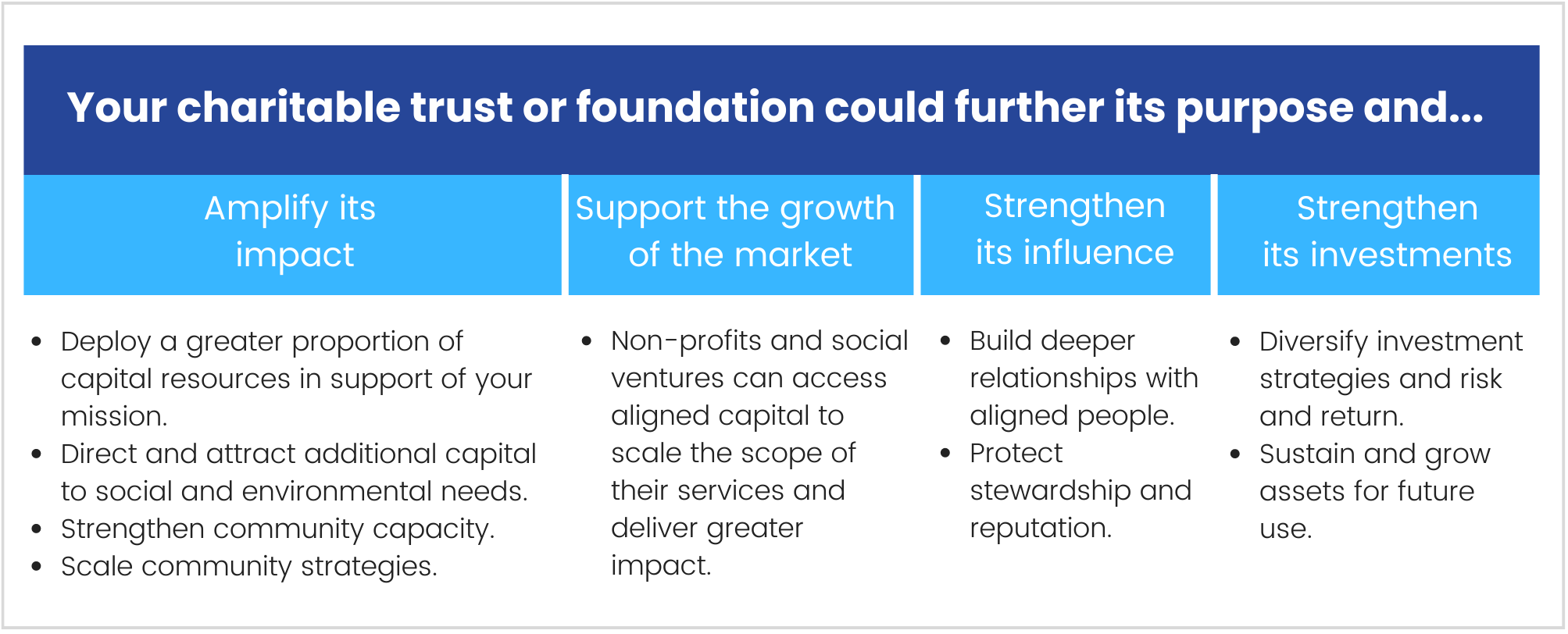
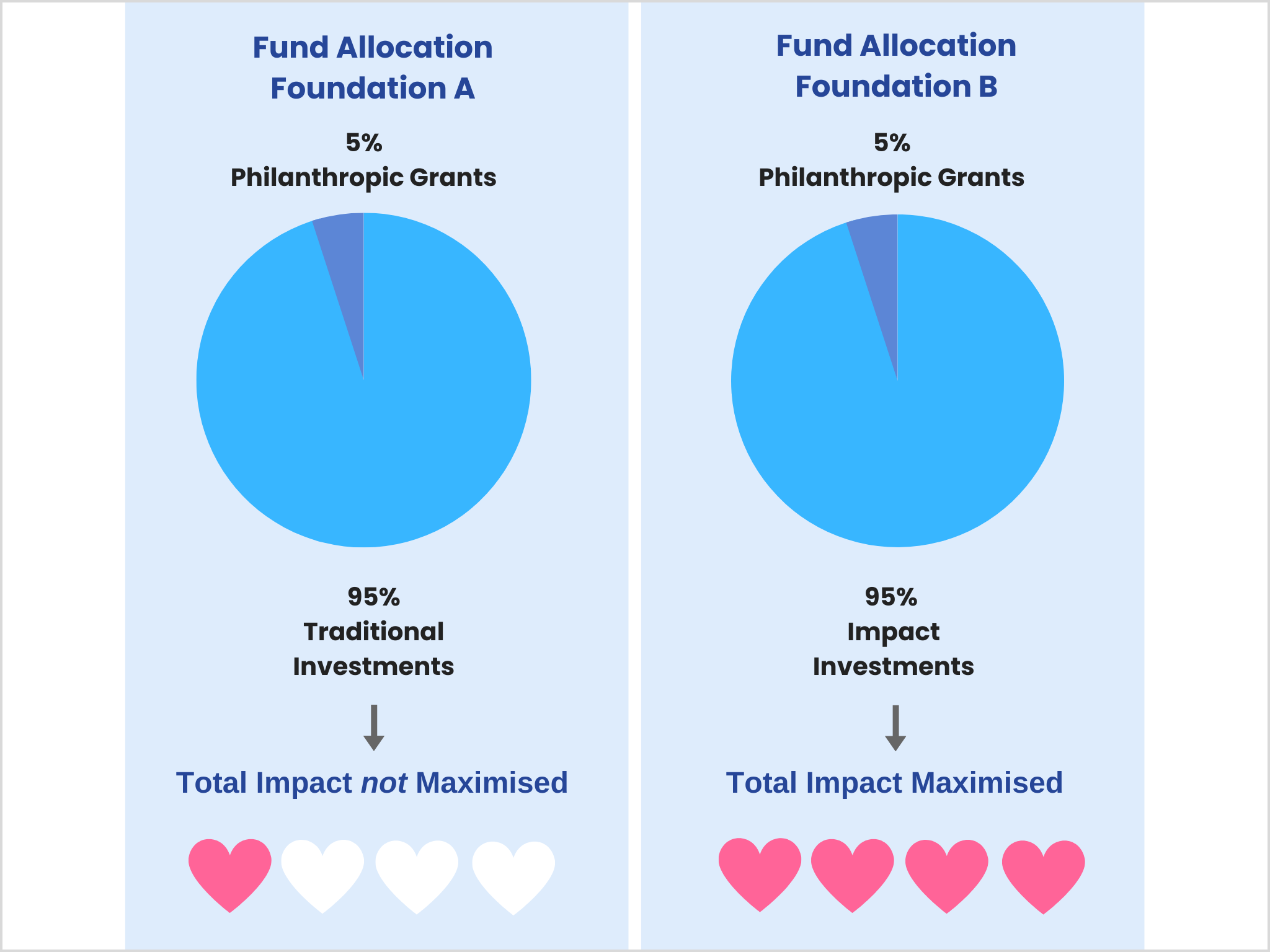
Figure 3.2 adapted from Charlton et al in the First Edition of the Field Guide (3)
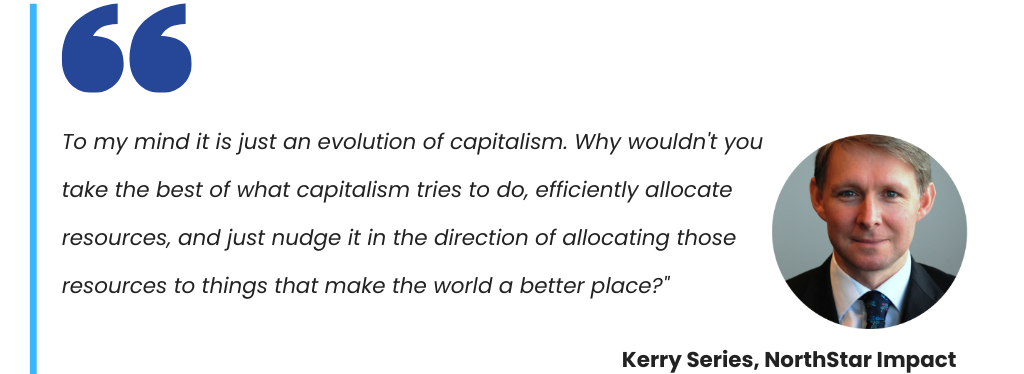
3.2 What are Australian charitable trusts and foundations currently doing?
Impact Investing Australia’s (IIA) survey of Australian investors found that the majority of Australian charitable trusts and foundations are interested in making impact investments, with more than 40% actively investing. Whilst the survey is from 2016, the sentiment still holds that these organisations see opportunity to align more investment activities with their mission in the future, subject to suitable impact investments being available (4).
Similar to other markets around the world, Australian foundations are increasingly stepping into the impact investing space, exploring how to use more of their corpus for impact. Initiatives such as the UK's Social Impact Investors Group (SIIG) have inspired Australian foundations to come together and explore how they can collaborate, share experiences and work together to create better outcomes for the causes they support. Foundations such as Snow Foundation, McKinnon Family Foundation and Alberts Foundation are sharing their experience and expertise openly with others to encourage the sector to grow, with some of these organisations being recognised at the national Impact Investment Awards.
The role that Australian charitable trusts and foundations play is expected to further evolve as the sector develops and looks to other markets, such as the UK and the USA for inspiration. In the UK, the creation of Big Society Capital and Access Foundation, for example, have been instrumental in catalysing the growth of impact investing to support the UK's social enterprise sector. As Australia considers similar initiatives, Australian charitable trusts and foundations will have the opportunity to examine how they can best deploy their capital to create impact.
Spotlight on...
CAGES FOUNDATION: ALIGNING CAPITAL WITH PURPOSE

Since our inception in 2009, there has been a shift in the Australian impact investment sector. The market has grown extensively, there are more players in the field and more people making investments. Instead of just talking about it, investors are putting their money where their mouths are and deploying capital into the market. To get involved, you just have to be prepared to jump in somewhere and not get too caught up in the definition of what an impact investment is and how to define what you are doing.” Gemma Salteri, Executive Director, CAGES
Foundation
CAGES Foundation is a family-run foundation inspired by Paul and Sandra Salteri’s beliefs in giving back. Paul and Sandra established CAGES Foundation as a Private Ancillary Fund (PAF) in 2009. CAGES Foundation funds organisations working to improve the lives of Aboriginal and Torres Strait Islander children aged pre-natal to five years old. They direct their funding towards organisations that are locally owned and they have partnered with The Australian Literacy and Numeracy Foundation, Indi Kindi and several others.
Contributing to improving outcomes for Aboriginal and Torres Strait Islander People, CAGES Foundation’s Executive Director, Gemma Salteri notes that 'not all social issues that we are trying to solve can be solved by a loan. Apart from government, charitable trusts and foundations are one of the only entities that can effectively straddle both grants and investments. It is about balance and working with all of the assets that you have available to you.'
CAGES made its first impact investment in 2014 and currently has 40% of its portfolio in impact investing. They have investments across a variety of asset classes and consistently apply a strong ESG screen. CAGES actively pursues impact investment opportunities and as Salteri notes 'Hopefully the sector grows so that we will one day be able to achieve 100%.'
Their portfolio consists of both investments that generate a strong financial return as well as some higher risk capital deployed to principally create social impact, especially in the aligned area of stimulating Indigenous businesses. In the past, CAGES classified their impact investments as either Impact A or Impact B investments, where although both types of investments aimed to have a measurable social or environmental impact, the main intention of Impact A investments was to drive financial return, while Impact B investments had a bigger focus on social impact and did not have a market risk return profile. Rather than distinguishing between the two classifications, CAGES is now more focused on directing all their higher risk impact investments to supporting Indigenous businesses and impact investments that are more aligned to their mission.
CAGES aims to generate a financial return of 8% with its portfolio and being able to meet that target is important to them in being able to continue providing grants. Impact investing is very powerful but not all social issues can be resolved through investments alone. Having a balance between the two is very important and as Gemma says ‘There is no silver bullet, it has to be a mix.'
3.3 Identifying barriers & break down misconceptions & myths
Despite the intuitive rationale of impact investing and the fact that the approach has been well received internationally, Australian charitable trusts and foundations have been slow to adopt it. A relatively conservative culture around trustees’ duties and a lack of precedent have amplified trustees’ reluctance to experiment beyond the tried and true execution of their fiduciary responsibilities.
There are also a number of common myths and perceived challenges that have precluded charitable trusts and foundations from active participation in the impact investment market. Some of these common myths and challenges are addressed in the report Impact Investments: Perspectives for Australian Charitable Trusts and Foundations (6) and are explained in the table below.
Myth or Perceived Barrier | Response |
Uncertainty around investment duties of charitable trustees. Trustees of Australian charitable trusts and foundations may be uncertain about how to navigate their legal and investment duties and be wary that engaging in impact investments may be a breach of their fiduciary responsibilities (Cowan v Scargill [1985] Ch 270). | Whilst such caution is appropriate, the requirements imposed on trustees may be navigated in a way that permits the trustees to provide capital to enterprises and funds that pursue a social impact agenda. There is no difficulty with finance first impact investments, as they deliver a risk adjusted commercial return with the bonus of social impact. There may be challenges with impact first investments where there are discounted returns, depending on the structure. To pursue these, there needs to be explicit alignment with the Trust purpose as set out in the Deed. See also below information about discounted returns counting towards distribution requirements. |
Size of trust or foundation and resources needed is a barrier to entry. There may be a perception that only large foundations with significant staff resources can make impact investments. | Trusts and foundations large and small can and do make impact investments. Impact investments, like all investments, must suit your investment strategy. Larger foundations may be more able to dedicate resources to oversee impact investments, access different opportunities and do due diligence or more easily diversify their impact investments. But it is not the size of an organisation that inspires it to begin impact investing. Many of the leaders in impact investing are small to mid-sized and this hasn't stopped them from investing significant portions of their portfolios in impact investments. There are also a growing number of options available for foundations that want to invest through fund managers. |
Ambiguities about discounted returns counting towards minimum distribution requirements. Understanding when the difference between what the recipient pays and what would have otherwise been paid (i.e. the quantum of benefit) can be counted towards the minimum distribution. | Amendments introduced in 2016 to the PAF and PuAFs legislation addressed many of the ambiguities about what can be counted towards the minimum distribution requirements. The amendments added further examples to assist PAFs with calculating distributions where they have made social impact investments with eligible entities. See Part 4 for more details. |
Term confusion and understanding where impact investing sits in the portfolio. Differing definitions and philosophical approaches to impact investment have created confusion and uncertainty about where impact investing sits in the modern portfolio and how much to allocate to impact investments. | Whilst some argue that impact investment is an emerging asset class, the increasingly recognised view, endorsed by the Global Impact Investment Network (GIIN) and World Economic Forum (WEF) is that impact investment is a ‘lens’ that can be applied across mainstream asset classes. This is the definition that is adopted throughout this guide. Taking the integrated approach, Australian charitable trusts and foundations can apply an impact investment strategy to part or all of their investment portfolio, across all or selected asset classes. |
Uncertainty around achieving competitive financial returns as impact investments are higher risk. There is currently a perception in the market that impact investing necessitates both a high risk appetite as well as a financial trade-off. Despite sound financial returns in impact investments, there is a limited amount of public information that is published, hence creating scepticism. | Although there a relatively short track record of impact investing in Australia, most of the investments to date have achieved competitive financial returns. See Part 2 for investment examples. There is little evidence to support claims that impact investments have a higher financial risk than mainstream investments – it is evenly spread across the risk spectrum. However, there is an additional type of risk – impact risk. There is risk that the forecast impact may not materialise, or the investment may have unintended impacts. |
Limited access to expertise and lack of efficient investment infrastructure. Due to the relative immaturity of the Australian market, there are a limited number of impact investment experts and few resources that can help charitable trusts and foundations design and implement an impact investment strategy. The nature of impact investing requires market knowledge and expertise both on the financial side and on the social and environmental side. | As the market for impact investment in Australia matures, the pool of specialist consultants and intermediaries will grow, as will the impact investment infrastructure. This Guide seeks to consolidate the existing resources available in Australia as a step to improving the intermediation and infrastructure (see Part 6 for details of advisors in Australia).Further development of an investment infrastructure encompassing advisors, fund managers and product developers is required to accelerate participation in the market and drive down high transaction costs caused by fragmented supply and demand, complex deals and limited understanding of risk. |
Sourcing deals, limited absorptive capacity for capital and lack of track record. Lack of deal flow is often cited by Australian charitable trusts and foundations as a barrier to impact investing. There is a perception that most deals in Australia have been bespoke individual investment opportunities that present limited scale, liquidity, and diversification. | The number of deals and products available in the impact investing market in Australia is growing rapidly, as the infrastructure to support and develop that market. The Impact Investing Hub, launched in 2017, is a platform that connects investors with investees and impact investment opportunities. It also provides access to deals and key players in the impact investment market in Australia. Charitable trusts and foundations may also have the ability to partner with previous grantees to develop their own impact investment opportunities. |
Trust deed requires capital to be held in perpetuity and income to be distributed to one or more charitable purposes. Where the deed (or in wills that are the founding documents of the charitable trust) require the capital to be held in perpetuity, there is a constraint on all but finance first impact investments. | This barrier generally only applies to will trusts. |
Perceived barriers around managing risk and adapting mainstream investment decision frameworks. Investment decision frameworks for impact investments not only need to assess financial risk and return, but also the social risk (intended and unintended consequences) and return (the impact). | Adopting an integrated approach enables established investment decision-making frameworks, due diligence processes and portfolio construction models to be applied to an investment portfolio that includes impact investments. There are frameworks that provide a basis for developing and implementing an impact investment strategy across all or part of the portfolio. The GIIN and Rockfeller Philanthropy Advisors are examples to explore. Frameworks such as these help guide investors to establish portfolio parameters, define an investment strategy, asset allocation targets, determine an impact thesis, assess investment opportunities for risk, return and impact and manage financial and impact risk. |
Perceived barriers around classification of PAFs as sophisticated or professional investors. Currently, some PAFs are unclear whether they meet sophisticated or professional investor tests under the exemptions from the prospectus regime, despite very high net worth individuals or organisations (who themselves meet these tests) having established them. Many impact investing funds or social benefit bond offerings can only accept investors if they are sophisticated investors. | Under the current Corporations Act and accompanying regulations, a PAF would satisfy the sophisticated investor test if the PAF itself had net assets of at least $2.5 million, gross income of at least $500,000 for each of the last two financial years or paid at least $500,000 to accept an offer of securities. Alternatively, if the PAF itself did not meet the sophisticated investor test because of an insufficient level of assets or income, the PAF could satisfy the test if it was controlled by a sophisticated investor. The principal responsibility for ensuring this rests with the issuer, but there would be benefit in some regulatory guidance directed at PAFs which clarifies the operation of relevant provisions of the Corporations Act 2001 (Cth). |
Many impact investments require patient capital and have limited liquidity. Investors have a perceived notion that their capital is ‘locked up’ for a long period of time when they are taking part of impact investing and that this this limited liquidity is problematic. | Just like mainstream investments, there are impact investments that have both short and long time horizons. Most charitable trusts and foundations are set up to exist in perpetuity. As long as the investment is generating sufficient income each year to distribute in grants (5% for PAFs and 4% for PuAFs), arguably a charitable foundation should be prepared to wait for the return of their capital. Charitable trusts and foundations are often most able to be patient compared to other legal structures, and the case for doing so is greater when the investment pursues impact in addition to financial return. In fact, because the enhanced returns often available from illiquid investments, having a proportion of a portfolio in illiquid investments is actually an opportunity to increase the financial return. |
(7) (8) (9) (10)
3.4 Blended finance to leverage additional capital for impact

Philanthropic capital has and will continue to play an important role in the impact investing ecosystem. Indeed, philanthropic capital is increasingly being used in innovative and catalytic ways to de-risk individual investments or markets, and attract other types of investors—including those from the private sector and government— and so mobilise greater resources.
This leverage of philanthropic capital is accelerating the impact investing’s potential to drive change. Today, the more innovative foundations in Australia proactively use philanthropic capital to support organisations to become truly investment ready, to de-risk deals to attract additional capital from more risk-averse investors, and to support the growth of the impact investment sector.
Catalytic impact investment is explored in more detail in Part 2. For charitable trusts and foundations, it represents a powerful opportunity to mobilise additional capital from mainstream investors to social and environmental solutions.
Some of the examples explored in the SPOTLIGHT ON sections here demonstrate how guarantees or similar instruments have been used in Australian impact investment deals.
Guarantees can have several attractive features for charitable foundations. They:
- may have greater impact than a direct one-time loan or investment, as they can open up new sources of financing and build the credit-worthiness of grantees;
- may not necessarily require an upfront outlay of funds, meaning those resources can do 'double duty' by also being invested elsewhere and earning a financial return.
Part 2 of this Guide provides further examples of deals deploying blended and catalytic finance to mobilise capital and maximise impact.
Part 8 of this Guide explores these ideas more fully.
Spotlight on...
INNOVATIVE USE OF LOANS TO TACKLE DISEASE
Medicines Development for Global Health (MDGH) is a Melbourne based not-for-profit global health organisation founded in 2005. MDGH’s vision is to eliminate neglected diseases by developing, seeking regulatory approval and delivering affordable medicines and vaccines for people who need them most. To achieve this, MDGH operates a social enterprise and reinvests all profits back into the company for its purposes.
MDGH completed the development of moxidectin, the first new treatment for river blindness in 30 years. River blindness is a neglected tropical disease affecting 16 million people in sub-Saharan Africa, and it causes severe skin reactions and, in some cases, leaves the victim blind. Moxidectin is a broadly used veterinary product for parasitic worms and mite infections but this is the first registration for human use worldwide.
The funds received last year from the 7 ancillary funds were pivotal to maintain the work MDGH conducts around scabies, while we were waiting the FDA approval on moxidectin for river blindness and it was great to see such interest in the finance structure used.” Ronan Lehane, Capital Collaboration
MDGH’s development of moxidectin has been funded by various investment structures. The Global Health Investment Fund (GHIF) invested US$13 million to finance MDGH’s development activities. The GHIF is a social impact investment fund designed to provide financing to advance the development of drugs, vaccines, diagnostics and other interventions against diseases that disproportionally burden low-income countries. In particular, the GHIF seeks to invest in opportunities that have a clear impact on public health in developing countries, while still providing value in high-income countries. GHIF’s funding enabled MDGH to submit a New Drug Application (NDA) to the United States Food and Drug Administration (US FDA) to register moxidectin to treat river blindness in humans.
MDGH has also recently received AU$450,000 funding from seven Ancillary Funds to help them in the development of further human uses for moxidectin, particularly as a treatment for scabies. Scabies is caused by microscopic mites embedding themselves into the human skin and causes debilitating itching and more serious secondary infections. MDGH sought the funding, in the form of impact investment loans, to bridge the gap between current cash flow constraints to continue the development of moxidectin for scabies, without diverting funds away from the development of moxidectin for river blindness, which was still awaiting US FDA approval at the time.
In 2018, the US FDA approved moxidectin for the treatment of river blindness in patients aged 12 years and older. Accordingly, MDGH were awarded a priority review voucher (PRV) under the FDA’s reward initiative for registration of new treatments designated for neglected tropical diseases. MDGH will trade their PRV on the market to repay the loans that were provided by the seven PAFs.
APS Foundation was pleased to invest in MDGH to enable the research into use of moxidectin for the treatment of scabies, which afflicts indigenous Australians and other communities around the world.” David Ward, Australian Philanthropic Services.
Spotlight on...
WILDLIFE WONDERS: BLENDING CAPITAL FOR CONSERVATION
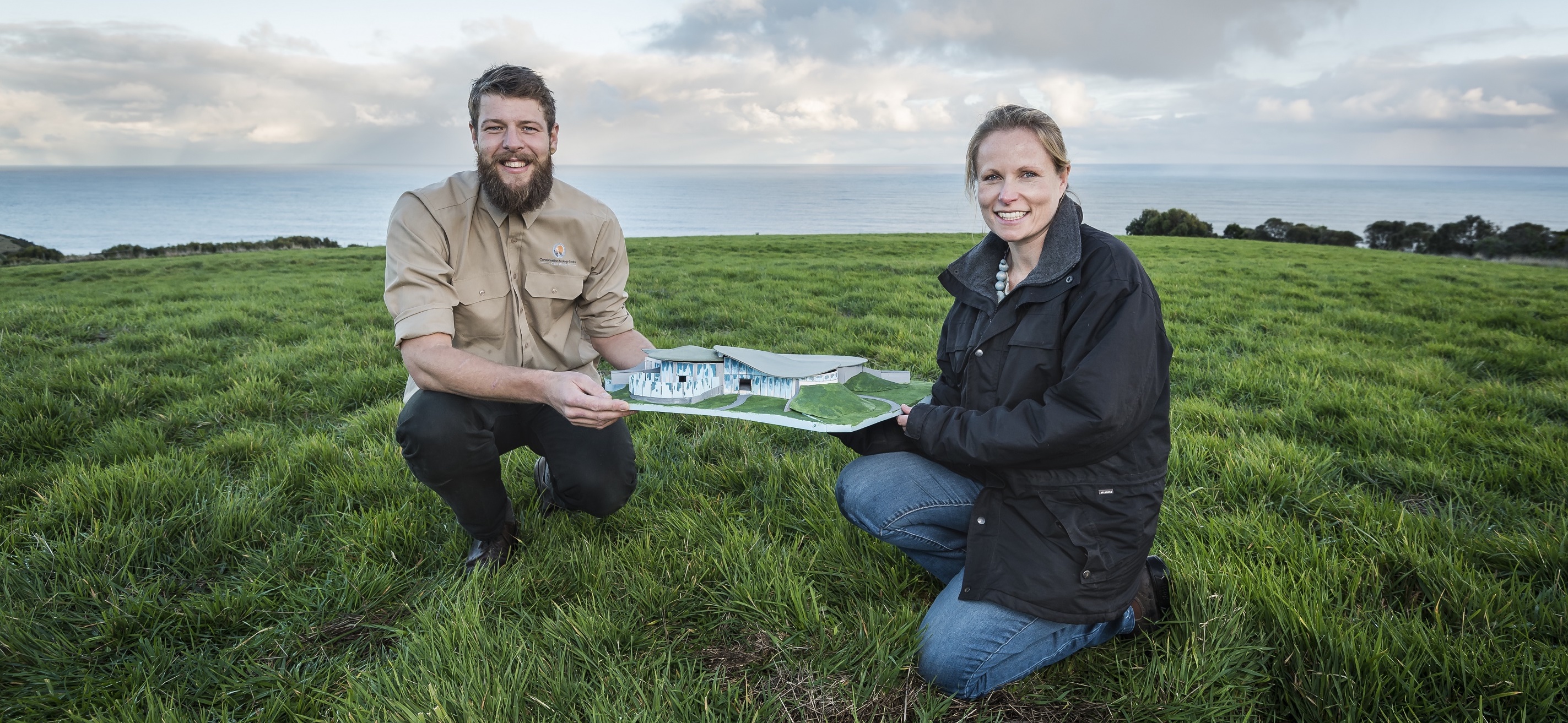
Wildlife Wonders, Photo credit Doug Gimesy
When finance and funding come together to support a project’s purpose the results can be incredible.” Lizzie Corke, CEO Conservation Ecology Centre
Wildlife Wonders is an ecotourism project of the Conservation Ecology Centre (CEC). Situated on the Great Ocean Road, the attraction will enable visitors to experience the unique environment of the Otways, observing and photographing iconic animals in a natural, predator-free setting. Visitors will be guided by qualified conservationists, and the overall experience will be heightened with design and creative input from Brian Massey, Art Director of ‘The Hobbit’ films and landscape designer of NZ attraction, ‘Hobbiton’.
Wildlife Wonders is set to become a significant employer in the region, providing jobs in tourism and conservation. As a social enterprise, the profits will be reinvested back into the activities of the CEC to ensure that the wildlife and natural habitats of the Otways are protected through ecosystem restoration, ecological research, species recovery programs, community education program, and community skills development.
Other key long term benefits of Wildlife Wonders include:
- Creation of local jobs: at least 44 jobs during construction and 35 new full-time positions in both ecotourism and conservation once operational;
- Enhanced visitor experience: amplified experience of the Great Ocean Road, directly increasing stay and spend;
- Providing a leading example of social enterprise: an economically sustainable approach to environmental conservation.
The project has been spearheaded by CEC’s CEO, Lizzie Corke, who said the challenge for CEC had been securing reliable funding for its conservation work.
We needed a funding stream that was reliable and secure for furthering the conservation effort.”
Behind this project is an innovative multi-party, layered finance structure which blends government venture funding, philanthropy and private grants, patient loans and debt capital.
To date, the Wildlife Wonders project has received a $557K Tourism Demand Driver Infrastructure Grant from the Commonwealth Government to initiate preliminary work, planning and the financial model. An additional $2 million was secured from the Regional Jobs and Investment Packages program through the Commonwealth Government and $1.5 million has been announced from the Regional Tourism Infrastructure Fund by the Victorian Government, to total a combined $4 million in venture funding from the Federal and State Government. The investment is expected to deliver ongoing and sustainable economic and environmental benefits. The RE Ross Trust, SEFA and a private investor have provided debt capital for the purpose of purchasing the project site and commencing on ground works.
As a result of these grants and investments, Wildlife Wonders has raised $6.5 million, which marks the halfway point in reaching its goal of raising a total of $12.5 million.
PART 4

4.1 Considerations for taking the first steps

There is no single right way to get started with impact investing. It takes time, commitment and a willingness to just ‘give it a go’. Some trusts and foundations in Australia started by executing a deal, then reflecting on their impact investment strategy later; others spent considerable time drafting policies and procedures to actively engage in the market in accordance with their strategy. Regardless, designing and activating an impact investment strategy is more likely to be an iterative rather than a linear process. This is discussed more in Part 5.
Before developing an impact investment strategy, it is best to start by checking the Deed of your Trust to see what it allows, and checking the obligations and restrictions that may arise from your legal structure. For example, all Australian charitable trusts and foundations require valid internal buy-in from the trustees.
The steps below provide a preliminary guide for how trusts and foundations might consider getting started with impact investing. The steps are presented linearly, but your trust or foundation's roadmap may not follow a linear path. It’s best to think of these steps as 'stepping stones' towards getting started:
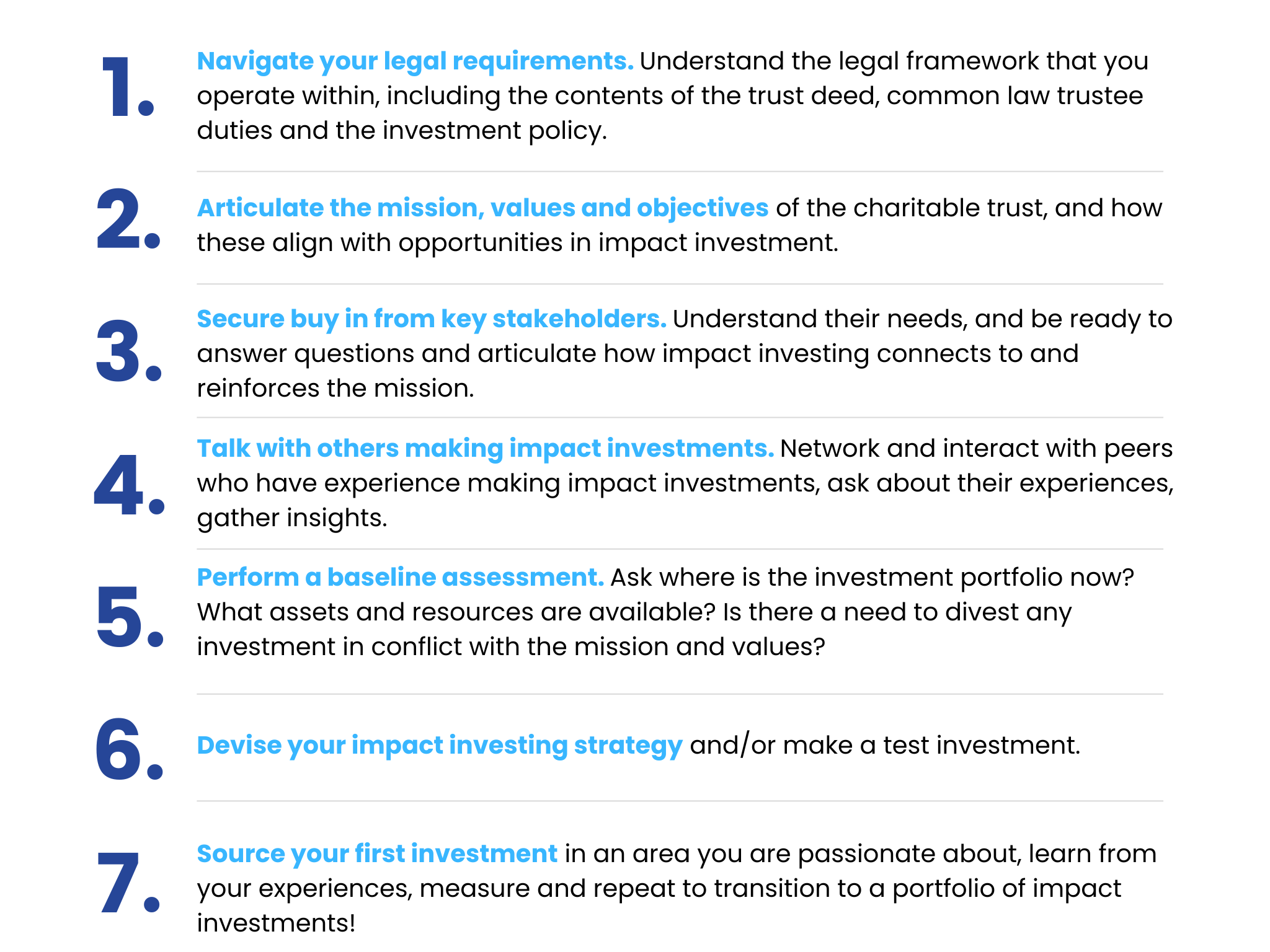
Considerations for trustees
The foremost duty of any trustee is to give effect to the terms of the trust (1). Below are five key questions for trustees relating to their trust’s current obligations and legal structure to consider before getting started in impact investing. Individuals looking to set up a new charitable trust may want to consider these questions in advance, so that their trust deed allows for impact investments to be made.
1. What does the trust deed say?
The trust deed is the crucial starting point for understanding the rules governing the investment of the assets of a charitable trust (2). Most trust deeds set out the power of investment broadly. The trust deed should be examined to determine if there are any positive powers or restrictions limiting impact investing. If there are restrictions, a trustee may consider making changes to the deed if allowed.
2. What are my legal duties to administer the trust in accordance with the trust deed?
It is critical that all trustees be mindful of their legal duties. If a trustee is unclear or uncertain about any of their duties, they should seek legal advice from a qualified trust lawyer before executing an investment decision.
3. Is the trust or trustee classified as a ‘sophisticated investor’ under corporations law?
This consideration is important because many impact investment funds or social benefit bond offerings can only accept investment from sophisticated investors.
4. Is there an Investment Strategy to consider?
There is a legal requirement that all PAFs and PuAFs formulate and adhere to an investment strategy. In the case of a typical charitable trust, there is no legal requirement for an investment strategy but there is a requirement for prudent investing and annual reviews, which makes having an investment strategy best practice.
5. What role, if any, is there for Fund Managers?
Trustees should consider the role their current fund manager or an alternative potential manager could play in facilitating impact investing. The capability of fund managers to source and impact invest may differ and as such the Trust should ensure they pick the right person(s).
4.2 Review trust deed & understand legal structures
It is important to understand the legal structure of your particular trust or foundation, as this will determine whether there are constraints (which may be addressed by a change in the trust deed if that is allowed) or if it is necessary to implement a formal investment policy.
The table at Figure 4.1 summarises the three most commonly used legal structures:
Private & Testamentary Charitable Trust | Private Ancillary Fund (PAF) | Public Ancillary Fund (PuAF) | |
Description |
|
|
|
Relevant Legislation |
|
|
|
Nature of Trustees | Individual or corporate trustee |
|
|
Responsible Persons as Trustees | N/A | Trustees/Directors must include at least one ‘responsible person’ (someone with a degree of responsibility to the community), and includes individuals before whom a statutory declaration may be made. He/she must not be a founder or donor of over $10,000, or an associate of a founder or such a donor. | Trustees/Directors must include a majority ‘responsible persons’ (someone with a degree of responsibility to the community), and includes individuals before whom a statutory declaration may be made. |
Investment Strategy Required? | Recommended | Yes | Yes |
Figure 4.1 relevant legal structures and their requirements
If you are unsure of your legal structure, you can check ABN Lookup, the public view of the Australian Business Register: abr.business.gov.au.
For further detail, please refer to the Philanthropy Australia Trustee Handbook on the role and duties of trustees of charitable trust and foundations in Australia by David Ward(3).

Distribution requirements for PAFS and PuAFS
PAFs and PuAFs have particular distribution requirements that must be fulfilled in order to maintain their status as ancillary funds. Specifically both entities are required to distribute a proportion of the market value of their net assets – at least 4% in the case of PuAFs and 5% in the case of PAFs.
The trustees of PAFs and PuAFs are able to include in that calculation any discount to the return received that is attributable to the delivery of a social benefit (eg. through subsidised rental) to an eligible recipient. This is an important concession, but it does not actually empower the trustees of PAFs and PuAFs to invest in non-financial-first investments where such power does not exist (eg. under the trust deed). However, the trustees who have such powers may have a preparedness to invest in arrangements where at least some of the return is delivered directly to the charitable objects, as long as those arrangements can satisfy their other obligations under the trust deed.
This points to the important first step: examine the trust deed.
When it comes to impact investing, it is important to know that a benefit to an eligible entity on concessional terms can count towards the minimum distribution requirements of both PAFs and PuAFs. Section 15 of the Taxation Administration (Public Ancillary Fund) Guidelines 2022 provides that (4):
"..A distribution is the provision of money, property or benefits. Where a fund distributes property or benefits, the *market value of the property or benefit provided is to be used in determining whether the fund has complied with subsection (1)."
It should be noted that most of the changes from the Public Ancillary Fund Guidelines 2011 (‘2011 Guidelines’) to the latest Taxation Administration (Public Ancillary Fund) Guidelines 2022 (‘2022 Guidelines’) are minor amendments to drafting which to not change the overall effect of the provisions. For PuAFs, the 2022 Guidelines reaffirm the existing requirement for minimum distributions each financial year (being the greater of: $8,800 or an amount equal to 4% of the market value of the Fund’s net assets). There is a still a 30 penalty point penalty for a distribution shortfall greater than $1,000.
The key change under the PuAF 2022 Guidelines is that there is now a process for applying to the Commissioner to reduce the minimum annual distribution rate for a Public Ancillary Fund.
Section 15 of the Taxation Administration (Private Ancillary Fund) Guidelines 2019 is very similar to the corresponding section in the Public Ancillary Fund Guidelines 2022, aside from the fact that there is an increase in the market value of the net assets that need to be distributed to 5%. The difference between what the recipient pays and what would have otherwise been paid is the quantum of the benefit provided and can be recorded as a contribution towards the 5% minimum distribution. The 2019 Guidelines in Section 15.4 contains additional examples of how PAFs can provide such benefit to eligible DGRs, and how these activities can contribute to meeting the PAF’s minimum granting obligation.
The table below outlines the ATO's guidance on how PAF investments or contributions can be counted towards minimum grant obligations:
Example 1 | Where a private ancillary fund makes a gift of land to a public benevolent institution, it would include the market value of the land in calculating how much it has distributed. |
Example 2 | Where a private ancillary fund grants a lease of office space to an eligible deductible gift recipient at a discount to the market price, the fund is providing a benefit the market value of which is used in calculating how much it has distributed. The fund may determine the market value as an amount equal to the discount. |
Example 3 | Where a private ancillary fund invests in a social impact bond that is issued by an eligible deductible gift recipient and has a return that is less than the market rate of return on a similar corporate bond issue, the fund is providing a benefit the market value of which is used in calculating how much it has distributed. The fund may determine the market value as an amount equal to the interest saved in the financial year by the deductible gift recipient from issuing the bond at a discounted rate of return. |
Example 4 | Where a private ancillary fund lends money to an eligible deductible gift recipient at a discount to the interest rate which would be charged on a comparable loan sourced from a financial institution at arm’s length, the fund is providing the borrower with a benefit equal to the market value of the interest forgone in the financial year by the lender because the borrower was not charged an arm’s length rate of interest. |
Example 5 | Where a private ancillary fund guarantees a loan provided by a financial institution to an eligible deductible gift recipient, the fund is providing a benefit the market value of which is used in calculating how much it has distributed. The fund may determine market value as an amount equal to the discount to the interest rate which would otherwise be charged on a comparable arm’s length unsecured loan sourced from that financial institution. |
Example 6 | Continuing example 5, if the deductible gift recipient defaults on the loan and the fund is called on under the guarantee to make a payment to the financial institution on behalf of the deductible gift recipient, the payment is also a distribution (being the provision of money, property or benefits). |
Note: The Commissioner may approve safe harbour valuation methodologies to assist trustees in calculating the market value of a benefit provided to a deductible gift recipient – see Subdivision 960-M of the Income Tax Assessment Act 1997.
While this area of providing non-monetary benefit will continue to develop, it must be emphasised that for PAFs, only eligible DGR entities can be the counter-party for rent subsidies, guarantees or below market loans.
4.3 Understanding legal & tax implications of impact investing
Investment strategy
There is a legal requirement for all PAFs and PuAFs to formulate and adhere to an investment strategy. These requirements are set out further in Part 5, along with a more detailed guide to constructing an impact investment strategy. In the case of other charitable trusts, there is no legal requirement for an investment strategy but there is a requirement for prudent investing and annual reviews (which is best done by having an investment strategy - see also Part 5).
Grant making vs investments
There is an important distinction at the heart of charity laws between the investment of the assets of a charitable trust or foundation and the distribution of monies in the form of grants. While a trustee may take into account its beneficiaries’ desire to prioritise social, ethical, and environmental issues, this in itself cannot justify reducing the financial well-being of the trust. (5)
In recent changes to PAF and PuAF guidelines, the Australian Taxation Office demonstrated its willingness to look at more creative approaches for PAFs to engage in impact investing. These changes have been viewed in the sector as enablers for impact investment. Similarly, the ATO’s AUSiMED Tax ruling, provided for a PAF to make a loan on commercial terms to facilitate commercialisation of breakthrough research and to treat the loss as a grant in certain circumstances if the venture is unsuccessful. (6)
A number of constraints remain, however, including limitations on the capacity of PAFs to make grants to organisations other than not-for-profits with DGR status. This limits their capacity to provide grant-style development or venture funding for many social enterprises (which may not have DGR status) or other impact ventures, or to non-DGR incubators and accelerators.
Fiduciary duties
Despite advances in ESG disclosure requirements for asset owners and investment managers and growing awareness amongst fiduciaries of a need to pay attention to ESG issues in their investment practices and processes, and be aware of relevant legal requirements.
While there have been developments to ensure that investment products are accurately disclosed to investors (for example, ASIC's guidance on green-washing, aligned to the Corporations Act 2001 prohibiting against misleading and deceptive statements and conduct), the Australian government has an opportunity to assist trustees to make well-informed considered decisions about ESG factors and impact investing by developing guidance on the interplay and priorities between impact considerations and fiduciary duties. RIAA's Benchmark reports, provide a snaphot of the key developments in responsible investment, including current government legislation, both in Australia and internationally.
In the meantime, while caution is appropriate, the requirements imposed on trustees can be navigated in ways that permit trustees to provide capital to enterprises and funds that pursue impact. There is no difficulty with finance-first impact investments, as they deliver a risk adjusted commercial return with the bonus of social impact. There may be challenges with impact first investments where there are discounted returns, depending on the structure. For impact-first investments, there needs to be explicit alignment with the Trust purpose as set out in the Deed. See also below information about discounted returns counting towards distribution requirements.
Tax considerations
Different types of charitable trusts and foundations are eligible for certain tax concessions as they are not-for-profits and sometimes DGRs. The amount contributed to a PuAF or a PAF is tax deductible in the year of contribution, as opposed to when the philanthropic gifts are donated to the ultimate beneficiaries. As a result tax and charitable gifts can be strategically managed. For instance, in a year of significant tax liability, a lump sum may be placed into a PAF and then gifted to a charity in the following years (7).
4.4 Assessing whether external support is required
Designing and implementing an impact investment strategy (which we look at in Part 5) requires an honest assessment of existing internal infrastructure and staff capacity to determine if external support is required. A trustee or foundation that has no demonstrable expertise in impact investing, or perhaps inadequate resources, would probably be expected to seek advice as a consequence of the duty of care it owes at law.
Approaches taken by charitable trusts and foundations can vary from informal ‘ad hoc’ investments to highly structured and formal processes spanning part of, or the entire portfolio. Some larger organisations may establish a separate portfolio within the investment team, while others have elected to bring the entire organisation in line with their impact mission by creating a single team to manage both their grant making and investment activities using a 'whole institution' approach (8). This has the advantage of ensuring both financial and social and environmental returns are considered and can be highly valuable for attaining trustee approval on the initial impact investing strategy and subsequent investment opportunities. For example, the FB Heron Foundation use a 'whole institution' approach in which they have created a single team to manage both the grant making and investment activities of the foundation.
Sometimes charitable trusts and foundations already have a team of financial advisors and asset managers to help manage their investments and the foundation and advisor enter the impact investment journey together. Some trusts and foundations have encountered resistance to impact investment from their traditional or existing advisors and have made the decision to source new advisors who are experienced with impact investing or at least values-aligned. Depending on the level of understanding of impact investing concepts, external support from experienced financial consultants and investment advisors positioned to help develop and execute the strategy can help to ensure the success of an impact investing strategy. (9)
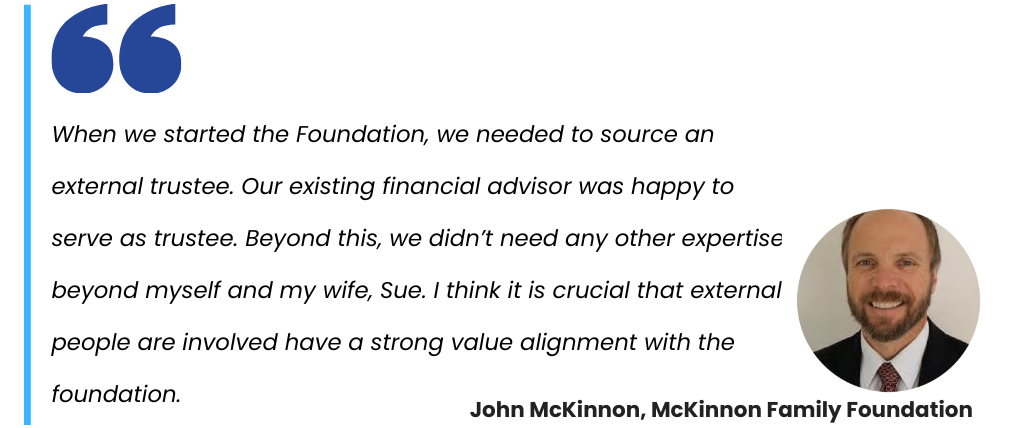
The size and objectives of the program, level of expertise and desired engagement will help to determine whether external support is needed. Below are some key questions that can help guide the decision to ‘go it alone’, build a team internally or work with external advisors.
In assessing internal structures, processes and staff competencies, ask:
- What is the objective of the impact investing program? To ‘test the waters’ or to ‘implement a full strategy’?
- What is the size of the impact investment program?
- What is the timeframe and level of commitment required from trustees and staff to implement an impact investment strategy?
- Is my existing team of advisors experienced with impact investment? Values aligned with impact investing? Willing to engage in this form of investment?
- Is a single person or a team required? Will it be an advisor or a fund manager?
- Who should be driving the strategy?
- How will the organisation staff, partner or outsource the following: Internal education, deal sourcing, financial due diligence, legal structuring and documentation, deal negotiating and closing, portfolio monitoring and reporting human resources and systems for financial performance, social impact, evaluation, reporting and communication?
- Will you outsource the liquid part of the investments to an external manager/advisor or outsource the entire strategy implementation and maintenance to an external specialist?
Source: Adapted from JB Jacquier, Guide to Impact Investing for Family Offices and High Net Worth Individuals (10)
PART 5

5.1 Overview
An impact investment strategy is a clearly defined plan which investors use to achieve their impact and financial objectives, trustees follow in the execution of their investment decisions and their duties, and executives implement in the operation of the trust or foundation.
An impact investment strategy contains answers to questions such as does the organisation prioritise financial return or impact? What is the desired impact?, and How will it be achieved? (1)
An impact investment strategy does not need to be created from a ‘blank slate’, and can generally be incorporated into an existing investment strategy. PAFs and PuAFs are required to prepare and maintain a current investment strategy (2), and this investment strategy is a good starting point for an impact investment strategy. An impact investment strategy can simply entail additional considerations in relation to impact. In fact, many of the investment management practices discussed in this section are used in mainstream financial investments, they have just been modified to include an impact lens.
An impact investment strategy can be developed internally among trustees and/or executives or with the help of external advisors. This decision requires a careful examination of existing capabilities and desires in relation to the level of participation in the process. See Part 4 for a discussion of internal and external advisors.
5.2 Designing an impact investment strategy
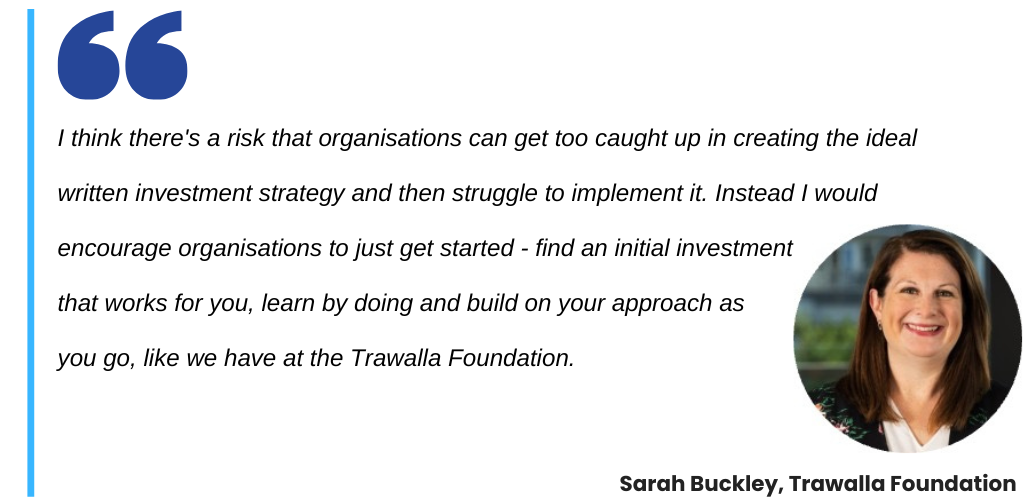
The following questions are a good starting point if you are working from an existing investment strategy:
Question | Recommendation |
Does the investment strategy explicitly make reference to impact investing and measuring the impact? | Explicitly refer to impact criteria as this may direct trustees to actively consider investments that create social impact. |
Does the investment strategy prohibit investment in certain classes of assets? | Investigate whether a potential investment in a class of assets is prohibited by your trust deed. For example, a trust's portfolio may focus on public equities for their tax benefits (as most trusts and foundations can claim the franking credits), whilst investments in bonds may create the optimal social or environmental outcome. |
Is there an excessively strong focus on financial return that may place an onerous financial benchmark for a trust to meet? | Re-examine the financial benchmarks so that investments with higher social impacts will not be disregarded merely because they have moderate financial returns or a higher risk of not outperforming the market. |
What is the liquidity risk involved in making, holding and realising the likely return from the fund’s investments? | Carefully consider the fund’s objects and expected cash flow requirements (including distribution requirements). |
If you are setting out to create an impact investing strategy for the first time, we recommend considering the following approach:
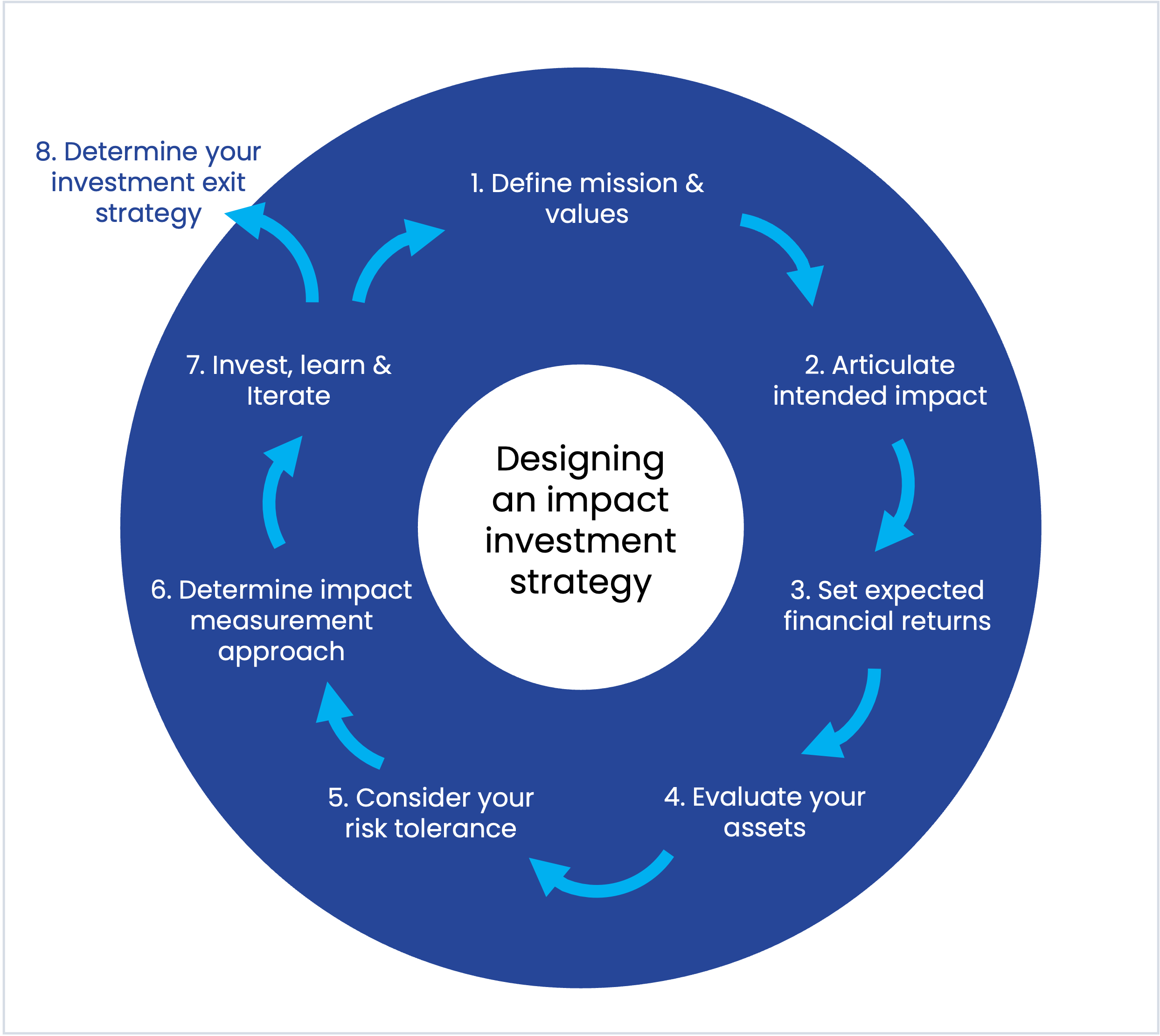
Figure 5.1 The steps to consider in designing your impact investing strategy
We'll now take a look at these steps in more detail in the remainder of this section.
Step 1: Defining your mission and values
A clear understanding of your charitable trust’s or foundation’s mission and values provides the most useful start for articulating intended impact and the investment strategy thereafter.
Most trusts and foundations have existing mission and vision statements- a formal summary of the aims and values of the organisation. A few key considerations in articulating or changing the mission and value statement include:
- 1.Why do we exist?
- 2.What are our underlying reasons for investing?
- 3.What is important to us?
- 4.Is there a particular area where we want to create an impact?
- 5.What do we hope to accomplish as an organisation?

Below are some examples showcasing the varying extent to which investment strategies can relate to the specific mission of the foundation.
The McKinnon Family Foundation | The KL Felicitas Foundation | Trawalla Foundation | Snow Foundation | |
Foundation Mission | The McKinnon Family Foundation has a relatively broad mission focusing on three main areas:
| The KL Felicitas Foundation’s mission is to support social entrepreneurs and enterprises worldwide to grow sustainably and to deploy their capital to create positive change and address major world problems. | The Trawalla Foundation works with exceptional individuals and orgaisations that have a vision ofr the future of Australia. They focus on investment values of strengthening gender equality, creativity, sustainability and social justice within our society | The Snow Foundation aims to improve the lives of those experiencing disadvantage in the Canberra region and beyond. |
Investment Strategy | The McKinnon Family Foundation is a Private Ancillary Fund and they are able to make investments in a range of different areas that would all fall within the broad scope of the foundation’s mission. | The KL Felicitas Foundation’s overall investment strategy is guided by their mission and core values of transparency and accountability but they make both finance first and impact first investments. | The investment strategy is guided by the Foundation's investment values and approach. All of the Foundation corpus investments are managed with a responsbile investing lens, and they invest a growing proportion of our corpus in social and environmental impact investments, including funds, social impact bonds and venture capital | The investment strategy is to ensure a strong rate of return to fund the foundation’s grant-making programs over the long term, investing responsibly in corporations who reflect their mission. The foundation continues to aim for 10% invested in pure social impact investments. |
Step 2: Articulating your intended impact
Once you have articulated your mission and values, it is time to articulate your intended impact. This can be approached a number of ways in varying levels of detail.
The Impact Management Project (IMP) began in 2016 as a time-bound forum for building global consensus on how to measure, assess and report impacts on people and the natural environment. 5 years after launching, the IMP’s facilitation role concluded as planned, after supporting the development of key initiatives to mainstream impact management. One of the outcomes from the IMP was a five dimension approach to managing impact, which has become widely used by practitioners today (see Part 7 for more details on impact management):


Considerations for impact:
Do you have any impact goals? If so, what are they and where are they focused?
Your goals may be broad such as ‘doing good’ in whatever ways are possible, or you may have specific social or environmental goals. They may be place-based or focus on a specific issue. Questions to consider include:
- Do you want to focus on your local community? Australia? Developing countries?
- Do you want to focus on a particular industry?
- Do you want to focus on a specific issue?

How large do you want your impact to be?
It is important to consider if you wish to primarily invest in impact-first, finance-first or blended value impact investment (see Part 1 for additional information). For finance-first investments it is important to set an impact ‘floor’ – a minimum amount of impact that the investment must generate in order to meet your criteria.
Do you want your investment strategy to relate to your grant strategy?
This may appear logical, however, there may be a lack of impact investment deals that directly align with your grant strategy. At the same time, some trusts and foundations do centre their impact investing approach around key program areas (program-related investing).

Do you want your investment strategy to align with your specific mission?
Some trusts and foundations may choose to align their impact investment strategy with the mission of the foundation (mission-related investing). If your investments directly align with your mission, consider including your mission in the investment objective. However, it is not imperative that the investment strategy be directly related to the organisation’s mission or programs, and if there is a financial return trade off due to the social impact, it must be aligned with the charitable purpose of the foundation.
Making a firm commitment to a strict alignment with a specific mission in the current Australian climate can be a barrier due to lack of deal flow. Currently, many charitable trusts and foundations in Australia have decided to ‘dip their toe in the water’ and make impact investments not strictly aligned with their mission, simply to start gaining experience in the impact investment market. Notably, some Australian charitable trusts and foundations have invested abroad, in part due to the more extensive deal flow, which allows increased opportunities for alignment between investments and mission.
Impact time horizon
You may wish to consider when you want to see the intended impact of the investment. Do you have a specified time frame when you want the impact to occur? Immediate impact? Short term impact? Long term impact?
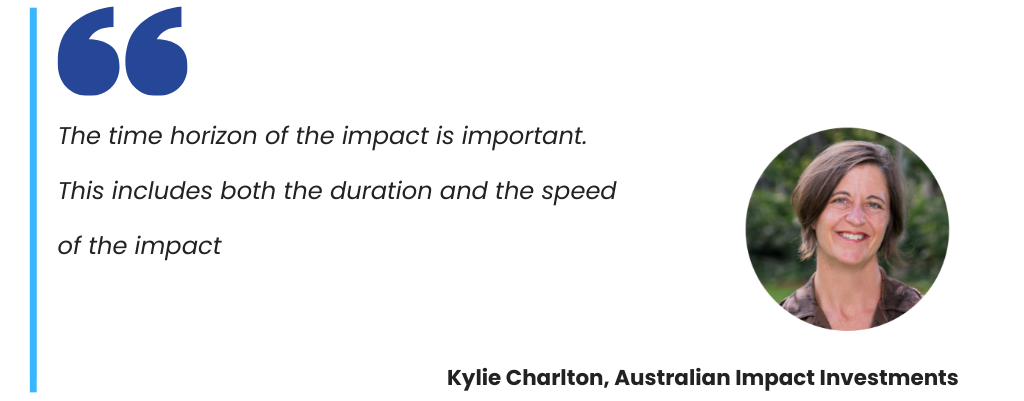
Step 3: Setting targets for desired financial return
The next step is to explicitly set out the broad financial investment objectives. Indeed, a common characteristic of successful investment organisations is that they are able to clearly define their investment objectives and articulate the principles that they will follow in seeking to achieve their objectives.
The investment objectives will depend on an individual trust’s aims, operating model, timescales and resources. A charitable trust must be clear on what it wants to do and the investment objective will articulate how the trust can go about doing so.
For example, a trustee may consider different investment objectives for different needs:
- Immediate distribution needs may induce a charitable trust to aim to maximise immediate income
- A charitable trust with large future commitments may induce a trust to preserve the real value of capital and source investment opportunities for potential growth
- A charitable trust with a long-term purpose may need ongoing, stable income
Setting targets for financial returns
The financial returns can vary from concessionary to highly competitive, so deciding where you want to sit on the spectrum of finance or impact first is an important part of creating your impact investing strategy.
If you are incorporating impact investing into your strategy, you may be willing to prioritise social impact over financial returns. In such situations, impact first investors should consider the floor on their financial returns. If there is a financial return trade off due to the social impact, it must be aligned with the deed and the charitable purpose of the Foundation. Further, onerous financial targets and benchmarks may discourage impact investing with lower financial return.
The structure of your trust or foundation may also influence the target for financial return. As PAFs need to distribute 5% of their net assets each year, the target for financial return needs to be at least 5% if the size of the fund is to be maintained. The target may need to be 5% plus CPI capital growth if the fund is to maintained in real terms. On the other hand, a will trust or private charitable trust is only obligated to give away the income it receives each year, so the trustees have more flexibility in balancing income compared to capital growth.
Setting a benchmark
Trustees may want to adopt a financial benchmark against which the trust can compare its returns. A benchmark can be any financial metric that can be appropriately aligned to the investment objective of the charitable trust. For example, Australia’s Future Fund adopted an average return of at least the Consumer Price Index plus 4.5% to 5.5% p.a. over the long term as the benchmark return on the Fund (3).
Financial time horizon
A trustee may want to include in this section the expected time horizon of the charitable trust’s investments. The time horizon should align with the objectives of the trust. As charitable trusts often exist into perpetuity, investments should be managed to meet this long term objective. Hence, setting an investment policy that allows for long-term investments may be appropriate.
Investing in earlier stage impact investment may be associated with a longer investment period of seven to ten years. This concept is known as patient capital and should be a consideration when investing, especially in direct investments. However, there is merit as it provides the capital required to nurture an enterprise to fruition and to thus create a greater impact.
We think of most impact investments being of a private equity nature in terms of timeframe (and probably valuation as well). Part of a portfolio would be available for very long term capital. This also suggests there is a place for short term, more capital stable impact investments, probably in the shape of debt rather than equity.” John McLeod, PAF
Liquidity
It is important to understand the type of liquidity you need and whether you are able to invest in illiquid assets.
Given the lack of any formal exchange on which the impact investments can be traded or brokers that can facilitate deals, impact investments will be relatively more illiquid when compared to traditional financial investments. However, the investments can still be privately traded among the increasing base of impact investors, and with the increasing maturity of the industry, more opportunities can arise to improve liquidity.

As capital calls are rare, foundations may wish to invest in illiquid investments as they often generate higher returns.

Step 4: Evaluate your assets
Investors should evaluate the types of and relative weightings of investment asset classes (e.g. cash and property), so as to determine their risk/reward appetite consistent with their impact goals. This will involve an examination of monetary assets, focusing on the dollar value of the portfolio, as well as non-monetary assets, such as the knowledge, skills and resources that could be deployed in impact investments. Careful consideration of the value and appropriateness of joint ventures and co-investing partnerships is also recommended. (4)
Step 5: Consider your risk tolerance
One method of distributing your risk, is to diversify your assets. Impact investing presents a unique opportunity to diversify the risks of your portfolio as impact assets by nature tend to be less correlated to the public debt and equity markets. Impact investors may find that they experience lower levels of market risk but conversely may experience greater liquidity risk. It is important for impact investors to consider this balance when incorporating an impact investment into their portfolio.
In order to diversify your portfolio and reduce the risk associated with early-stage or start-up investments, it may be optimal to invest less significant amounts of money in a number of social impact deals. For investors with a low risk tolerance, it may be ideal to invest in funds or other special purpose vehicles, which in turn invest in social impact deals. (5) See Part 5.3 for a detailed discussion on indirect investments.
It is also beneficial to assess your impact risk, that is the likelihood that the investment will have the intended impact. Investors should obtain information concerning the metrics that will be used to assess if an investment is successful in meeting or exceeding its expected social impact. (6) See Part 6 for a detailed discussion on impact measurement.
Identifying risk
Trustees should recognise, within their investment policy, the categories of risk that the portfolio faces and the proposed mitigators of these risks. The following are examples of risks that trustees, fund managers and other individuals or organisations face with their investment portfolios. These risks are known as investment risks.
With impact investments, some of these risks may be greater or lower. Some impact investments, such as social impact bonds, are often not correlated to other investments, and this can provide diversification benefits which may lower the risk.
Risk | Description | Mitigation |
Market Risk | Market risk, also known as systematic risk, refers to the possibility for an investor to experience loss of portfolio value due to factors that affect the overall performance of the financial markets. This risk includes factors such as recessions, such as the recent Global Financial Crisis and political turmoil. | Market risk cannot be mitigated through diversification. Market risk can generally be managed by:
|
Inflation Risk | Inflation risk refers to the possibility that inflation occurs at a higher rate than the growth of the capital of the portfolio. This means that over time, the value of the portfolio is not maintained. | Inflation risk can be mitigated by
|
Income Risk | For PAFs and PuAFs who have an obligation to distribute 5% and 4% of net assets respectively, this risk refers to the possibility that the portfolio does not generate sufficient income to meet this obligation, and therefore trustees have to draw on the capital to make their distributions. | Income risk can be mitigated by:
|
Liquidity & Exit Risk | Liquidity risk refers to the inability for investments to be sold when required or the price realised is significantly different from quoted price. Trustees require liquidity in the investment portfolio to meet immediate obligations to disburse funds, per legal requirements, or to rebalance the portfolio to meet asset allocation requirements. For a charitable trust, liquidity is of particular concern because liquidity in impact investing is extremely poor. Impact investing movement trends to focus on venture investing, private equity and direct lending because of the unmatched power of these investments to generate social impact, but these investments are inherently illiquid. | To manage a portfolio’s liquidity risk, trustees can carry out the following:
|
Impact Risk | Impact risk is an additional risk that should be considered with impact investments. For an impact-first impact investment, an investment may fail to achieve the social or environmental impact that you anticipated when you agreed to trade off financial return. There is also a reputational risk if an impact investment is financially successful at the expense of underprivileged people. | This risk can be mitigated by:
|
Manager Risk | Trustees may engage external fund managers to invest the corpus of the charitable trust. Fund managers are engaged to deliver superior returns that are above the market return. However, there is the possibility that this does not eventuate. | Manager risk can be mitigated by careful selection and monitoring of fund managers’ performance and the composition of portfolios to ensure there are no diversions from the intended investment objective |
Credit Risk | For charitable trusts, investing in credit or providing loans presents attractive opportunities to invest in social enterprises. These investments present counterparty risk, referring to a risk of the counterparty defaulting on its contractual obligations to repay either the interest on the loan and/or the principal amount. | Credit risk can be managed by:
|
(7)
Reviewing the investment policy
Under State Trust Law a charitable trust’s investment policy and performance against the objectives must be reviewed annually and investments rebalanced if required. With changing circumstances in the financial market and with the ever-changing impact investing landscape, trustees should be able to develop and subsequently add new policies, in order to promote the best way to maximise a trust’s corpus.
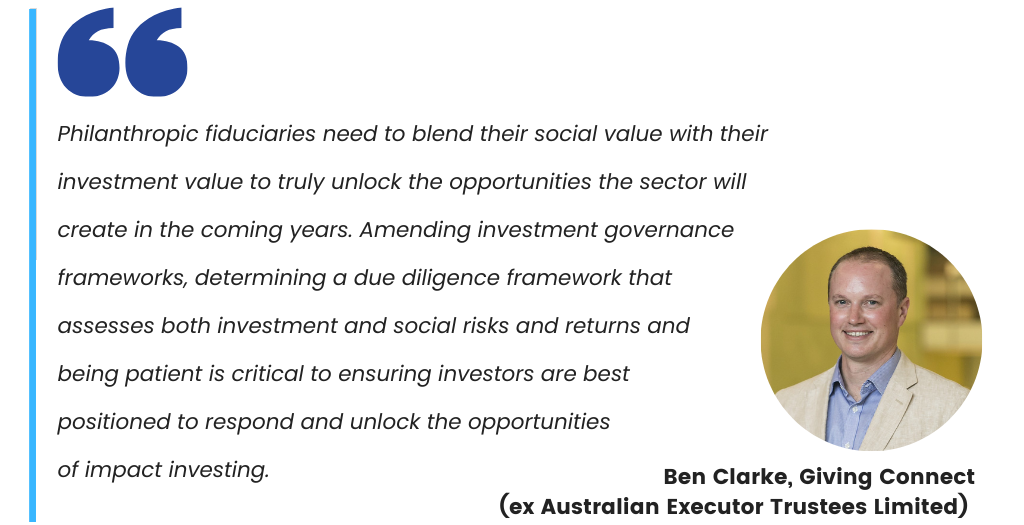
Note: More risk considerations are covered in Part 4 and in Part 6.
Step 6: Determine your impact measurement approach
Impact investments are expected to produce a desired social or environmental outcome so in designing your strategy, bear in mind how you will monitor your impact investments for financial and impact performance. Developing an impact measurement approach will help you determine if you are producing the outcomes you intended, and whether an investment has performed in line with your expectations. For more about this step see Parts 6 and 7.
Step 7: Invest, learn and iterate
Implement your strategy, start impact investing, and learn. Strategy is always an iterative process - based on your experiences, you may decide to stay your course and invest more deeply, or perhaps make some changes to your strategy and approach, seek help from advisors or consult with peers, and try again. Taking a learning and iterative lens will also provide you insights on how to best approach exiting investments.
Step 8: Determine your investment exit strategy
Careful consideration should be given when exiting impact investments to ensure impact continuity and minimisation of lost value. The GINN recommends considering the timing of investment, the continuity of management and alignment of new buyers when exiting an investment (8).
Exit timing: Exit timing is an important factor is any investor’s success. The 3 main considerations to determine an investee’s exit readiness are social impact achieved, financial sustainability and organisational resilience. The goal is to leave the organisation with a stronger business model and organisational structure that is capable of attracting and managing the resources necessary to purse its social goal(s) in the long term.
Continuity of management: It is important to maintain management as management continuity will play a central role in preserving mission and the company’s impact. On the other side of the spectrum, an exit through management buyout will provide best assurance over continuity, however, might not offer the benefits of added capital, connections or resources that an outside investor or strategic buyer might offer.
Selecting aligned buyers: Exiting an investment requires investors to select aligned buyers who can ensure the organisation’s mission and impact remains once they leave. Finding an aligned buyer who is consistent with the organisation’s mission and values is important in preventing future trade-offs and goal misalignment. Some factors to consider a new buyer include:
• Positive track record of regulatory compliance and ESG standards
• Experience in the industry
• Rationale for purchase
Bringing it together: Impact investing strategy check list
Once you have completed the steps outlined above, you should be well on your way to having a well articulated impact investing strategy. Use the questions below to check whether you have considered all the fundamental components in your strategy:
Have you thought through and outlined in your strategy...
- Why do you want to impact invest? Does profit, impact or a mix of both drive you?
- What impact do you want to achieve? Is there a particular cause, issue, or issues you want to address? Does it need to relate to your grant strategy?
- What are your financial return expectations?
- What are your strengths and limitations?
- How engaged do you want to be?
- How much of your portfolio do you plan to allocate to impact investing?
- Do you have any liquidity constraints/considerations?
- What is your time horizon?
- Do you want to focus on a particular asset class or invest across asset classes?
- Do you plan to do direct investments or invest through a fund?
- How do you intend to measure impact?
Source: Adapted from JB Jaquier, Guide to Impact Investing for Family Offices and High Net Worth Individuals.
PART 6

Once you have identified your broad objectives for impact investing, it is time to think about the specifics of your investments. This section outlines important considerations in sourcing and assessing impact investments. As this section does not provide in-depth assistance that is tailored to your circumstances, seeking professional advice is recommended.
6.1 Sourcing investment opportunities
Whilst impact investments exist in many forms, across asset classes, sectors and geographies, finding and executing impact investments can be challenging. The industry is maturing rapidly, however, and new initiatives are emerging in the field to connect investors with impact opportunities.
There are a number of initiatives in Australia focused at supporting impact investors and connecting them to suitable deal flow. Some of these include, the Impact Investing Hub, Australian Impact Investments, the Foundations Impact Investors Group (FIIG) and Impact Club. The Impact Investing Hub also provides access to deals, connecting impact investors to impact investment opportunities.
“The Impact Investing Hub Deals Library is a ground-breaking shift in how Australians can access the impact investment market. It facilitates access to impact deals, increasing the amount of capital for good. The number of listings on launch demonstrated the growth of the market in recent years, and this is set to accelerate especially as more superannuation funds start to impact invest.” Jessica Mendoza-Roth, Social Impact Hub
6.2 Direct and indirect investments
Depending on your impact investment strategy, you may have a preference to make direct or indirect investments. A direct investment is when you directly invest in an entity creating impact, while an indirect investment is when you make investments into a fund or another investment vehicle that will invest in entities that create impact. See Part 2 for a range of investments examples
Many foundations look to make direct investments into social enterprises - businesses, for good that trade like any other business, but exist specifically to make the world a better place. Impact intermediaries are often a good way to get access to these type of leads, usually earlier stage social enterprises seeking start-up capital or later stage social enterprises seeking growth capital. As discussed later in this section, a key component to making a direct investment into a social enterprise (like with other forms of investment) is due diligence, which is discussed later in this section. Investing directly into social enterprises can be challenging for some foundations as it requires you to have the capability and capacity to conduct the this due diligence and assess the opportunity. Some rely on the due diligence conducted by others that they trust. Others prefer to make direct investments via other means, such as social impact bonds, which are guaranteed by government to pay a minimum return for a certain period of time.
Indirect investments, such as investing with an impact investing fund manager, can provide a way to simplify the due diligence and management process as the fund manager is responsible for the bulk of the due diligence on any direct investments. As such, the investor's due diligence can be limited to examineing the fund and whether it is suitable for them.
Australian intermediaries and networks
Using a network or intermediary is a way to help with making an investment. Joining a network allows investors to share investment opportunities, or pool financial and human capital together to source investments outside the reach of an individual investor. Using an intermediary for indirect investment can simplify the process of sourcing and assessing opportunities and structuring a deal, as this can be a challenge given the early nature of many of the social enterprises.

While there is no central social or impact stock exchange in Australia, there are several organisations who are building a track record in sourcing and structuring impact investments.
Below are examples of intermediaries which can provide assistance on sourcing opportunities (listed in alphabetical order):
Investment Readiness | Organisation | |
Investment Readiness |
| |
Specialist Financial |
| |
Specialist Advisory |
| |
Mainstream Financial |
| |
Sector Focused |
|
Social impact or enterprise incubators and accelerators provide professional and financial assistance to enterprises in their early or growth stages, helping to connect them with potential investors. For investors looking for early stage social enterprise investment opportunities, something innovative for their portfolio, or opportunities to provide catalytic capital, social enterprise incubators are a great place to find new opportunities.

Networks operate at varying degrees of formality, but generally have at the heart of them an ability to share investment opportunities. For trusts and foundations, it may also help expose opportunities to become involved in earlier stages of impact investing, such as providing grants for capacity building prior to or alongside an impact investment. An example of a domestic impact investing network is Impact Club, which is a private Australian Impact Investing Network by invitation. Examples of international networks have been listed below.
Finding opportunities overseas
Although the impact investing market has been growing in Australia, it is still young compared to Europe and the United States. Investing in opportunities overseas could also be a way to diversify a portfolio and access a wider choice of deals.
The impact investment field in Asia is far less developed than Europe and the United States. Among the Asian countries, the Indian impact investing market is the most developed with many microfinance companies emerging in the early 2000s. In the last decade there has been a shift towards a broader sector-agnostic investment strategy in areas such as healthcare, communications and technologies, as well as agriculture. Within India, there are also developments in self-regulation by key players in the social impact space such as the emerging Indian Impact Investing Council (IIIC).
The wider Asian impact investing market has also experienced an influx of government support and of tools that can be used to source and stimulate impact investment opportunities.
International Funds
Examples of international impact investment funds include:
Example | Description | |
The Althelia Climate Fund is aims to enhance the environment and reduce carbon emissions through support for sustainable land use and conservation of primary forest. European based, the Fund is global, focusing on Africa and Latin America, and secondarily in Asia. | ||
Gender-lens, impact investing security listed on a stock exchange, the $8.5 million Women’s Livelihoods Bond™ 1 (WLB™ 1). Supporting the successful replication of the Women’s Livelihood Bond™ (WLB™) Series, the IIX Women’s Catalyst Fund (WCF) is a de-risking facility that is catalysing women’s access to capital markets. | ||
The purpose of the IIX Growth Fund (IGF) is to seed women empowerment through the strategic deployment of equity and debt finance to enterprises advancing the empowerment and resilience of women as business leaders, business owners, suppliers, or employees. By financing the growth of these entities, IIX promotes the development of an ecosystem of women-focused enterprises that can ultimately leverage other sustainable finance products to continue fuelling their growth and impact by accessing the global capital markets | ||
Lotus actively invests in private enterprises that help both social and environmental problems with sustainable solutions, such as employment and income generation in Southeast Asia. | ||
Impact secondaries funds that make investments in dozens of private equity funds and have exposure to hundreds of underlying portfolio companies spanning a wide range of impact sectors including clean energy, food, healthcare, healthy living, resource efficiency, transportation, waste and water. | ||
Patamar invests in early-stage technology companies building sector-defining business models that transform the lives of the emerging middle class who are underserved in their access to basic products and services. They invest in companies that help narrow the gap in the supply and demand of these basic products and services across six main investment themes, which are financial inclusion, SME digitization, agriculture, healthcare, education, and affordable housing. |
International Networks
Examples of relevant international networks include:
Network | Description |
The Asian Venture Philanthropy Network (AVPN) promotes venture philanthropy in both the broader philanthropic and social investment community. The purpose of AVPN is to provide an abundance of networking opportunities and learning services, in order to share best practice in the region. In order to support the capacity development of members in AVPN, they have established a capacity development model (CDM) that is relevant to the venture philanthropy practice, in particular the pre-engagement, capacity building, impact assessment, portfolio management and multi-sector collaboration stages. | |
CFOs Coalition for the SDGs, aims to accelerate the progress of pioneering CFOs and accelerate their progress in aligning corporate investments with the SDGs and linking corporate finance to relevant and credible SDG targets. The CFO Coalition comprises both the Leadership and the Signatories Groups working to align corporate investments and finance with the Sustainable Development Goals. It aims to leverage trillions of dollars in annual corporate investments, including in emerging markets, to help achieve the 2030 Agenda for Sustainable Development. | |
Non-profit organisation dedicated to increasing the scale and effectiveness of impact investing. It focuses on building practice to overcome systemic barriers to impact investing and attract more capital to the field. The Investors’ Council is by invitation only and prospective members should have a minimum of USD 50 million in impact investment assets. | |
Impact Investment Exchange Asia (IIX) is a Singapore-based organisation with a mission to provide Social Enterprises (SEs) in Asia greater access to investment capital, allowing them to more rapidly expand the impact of their activities. IIX now offers three investment platforms – Impact Accelerator™, Impact Partners™ and Impact Exchange™. Impact Accelerator™ provides seed-stage SEs with mentorship and private capital through a structured and customised process. Impact Partners™ connects accredited impact investors to selected growth-stage SEs who are looking to raise investment capital. Impact Exchange™, the world’s first social stock exchange operated by the Stock Exchange of Mauritius in collaboration with IIX, is a regulated stock exchange dedicated to listing and trading securities issued by mature SEs and other socially-driven organisations. To date, IIX has facilitated $11 million of investment impacting more than 8.2 million people across Asia with $19.5 million in social value created. | |
A membership-based network of philanthropic organisations who are using program-related and mission-related investing as a strategy to accomplish their philanthropic goals. Based in the US and has some international foundations as members and affiliates. | |
Toniic is an international network of impact investors promoting investment in ‘entrepreneurs, enterprises and funds seeking to change the world for the better’. |
Creating your own impact investment opportunities
Many seasoned impact investors are starting to create their own impact investment opportunities. For example, trust or foundations with longstanding relationships with a not-for-profit, and a good understanding of their operations, could, in appropriate circumstances, suggest that a particular project may be more suitable for a loan than a grant.
Outside investing in social enterprises and intermediaries, charitable trusts are encouraged to think laterally and explore how investments in traditional businesses can be used to generate social impact.
Below are some suggestions of how charitable trusts can think about harnessing traditional for-profit investment for social impact:
- Growth capital for a business that has a product or a service that is already servicing a social need such as housing, health or education.
- Ownership or control of a business and improving the accessibility of a product or service to the market through innovating the business model.
- Working with an investment opportunity in order to revitalise the business’s operations and/or culture to become more socially sustainable.
- Working with an investment opportunity to improve an asset’s operations, such as an office building, to become more environmentally sustainable.
- Turn-around of unsuccessful businesses that serve a social purpose.
- Undertaking place-based investing by focusing on a specific geographic locality and investing in-need areas in that area.

It is important to assess an investment across all three dimensions of to ensure that the risks associated with the investment, the resulting financial return, and impact are aligned with your goals. One way of considering the overall attractiveness of an impact investment opportunity is to consider how it can be reasonably forecast to be positioned when IMPACT/RETURN/RISK are triangulated as below. This approach is considered in more depth as part of impact measurement in Part 8.
6.3 Conduct Initial screening of impact investment opportunities
A clear decision-making and review structure is essential for effective execution of an impact investing strategy. Once people know your strategy is in place, you may be faced with an avalanche of requests for investment. Good governance is required to be sure that the stated goals and policies of the foundation are used in practice.
In an initial screening of an impact investment, you want to consider what the investment is:
- 1.Its proposed impact
- 2.Its financial return
- 3.Its risk profile

Figure 6.1 adapted from Australian Impact Investment's due diligence framework
Depending on the size and structure of your charitable trust or foundation, the initial review of investment opportunities may be a function for the board or staff. The initial review should include, at minimum, fit with mission, goals and strategy; potential for social return and preliminary assessment of potential for financial return. It should fit within the foundation’s impact investment portfolio parameters.
When the potential investment clears the screening and reviewing process, the investment can proceed to a due diligence process, where a more in-depth research process is conducted on the investment to determine its suitability prior to deciding whether to invest.
Some considerations for initial screening are set out here:

Figure 6.2 Adapted from McConnell Foundation Canada, Impact investing due diligence guide, 2017
6.4 Due diligence: financial performance & impact performance
Due diligence refers to an organisation’s research and investigation of impact investment opportunities. After an initial screening of impact investment opportunities, a foundation or their financial advisor should assess the opportunity in more detail before agreeing to make the investment.
Financial due diligence
Financial due diligence usually entails a full review of financial statements or offering documents and other relevant organisational materials, as well as project-specific documentation, such as projections and business plans. Reviewing the documentation in detail, especially items such as fees and redemption conditions, is also very important to properly discharge trustee duties from a legal perspective.
The financial analysis of an impact investment will usually be similar to that of a traditional investment, with the completion of a cash flow analysis and also the determined projected internal rate of return. A key factor is the return that the investor should expect in relation to the risk undertaken. Each investor will need to develop their own metrics for risk mitigation during the due diligence phase in order to determine whether the internal rate of return meets the risk-adjusted hurdle rate.
Fund managers
In conducting due diligence on fund managers, it would normally be recommended to ensure that they have a strong track record in delivering results that match your organisation’s mission, values and objectives. This consideration may have less emphasis in the Australian context at this point in time, as there are few specialist fund managers in the impact investment space with substantial track record.
Finance and impact
While standard due diligence checklists for traditional investments may be helpful in assisting the determination of whether an impact investment is suitable in relation to financial performance and risk, attention should also be paid to the qualitative factors in an investment. In the relatively undeveloped market of impact investments, it is helpful if investors remain flexible and are able to take into consideration different factors. For example, in the context of direct investments, it may be helpful to collaborate with other investors to conduct due diligence.
The quality of management is another important factor to consider, especially when supporting a direct impact investment. The team driving the enterprise will be key to ensuring that not only financial performance can be delivered but also the projected impact will be created.

Impact due diligence questions to consider asking
- How aligned is the expected impact with our core focus areas?
- How aligned is the investment with our strengths i.e. where we believe we can make the best judgements and provide the optimal support?
- How "baked in" is the expected impact into the business model? i.e. Is impact an integral part of the company's product or service offering, so that impact grows in line with revenue growth?
- How deeply does the organisation/investee and leadership team care about and understand the problem they are solving?
- What are the scenarios in which this company can lose its impact focus?
- What evidence are there of meaningful outcomes to demonstrate impact?
- How will the organisation/investee measure their impact? What processes do they have in place to demonstrate their impact?
Figure 6.3 Adapted from Impact Engine’s Impact Due Diligence: The Questions We Ask, Maggie Stohler 2017

Standard templates for performance review of impact investments can help institutionalise the evaluation process and facilitate external communication.
It is also important to be aware that investments can have unintended impacts that may be conflicting. Most investments have a positive impact and a negative impact, and it may sometimes be unclear whether the positive impact outweighs the negative impact. For example, there may be a conflict with an investment that has the potential of having a positive social impact whilst producing a negative environmental impact.
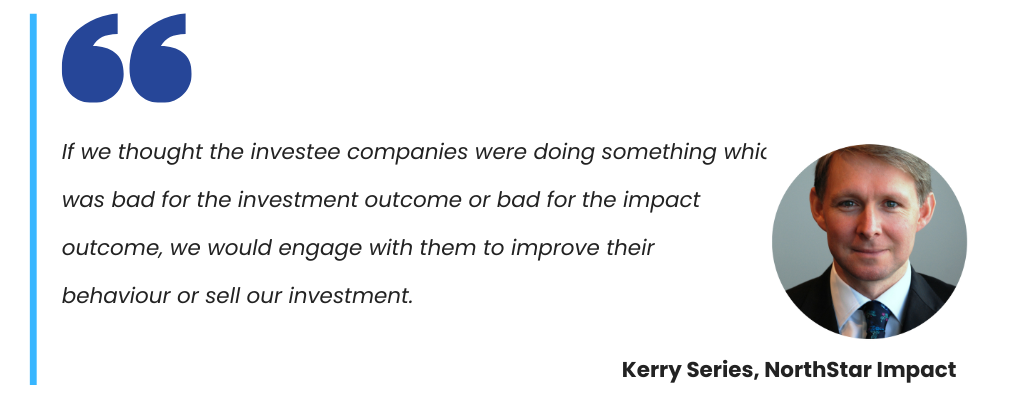
Whether or not a conflict arises will depend on the individual foundation’s impact investing strategy and policy. For some foundations the sole impact focus may be social and there will be no environmental consideration in their investments. It is important to be mindful that impacts are not mutually exclusive and unintended conflicts should be anticipated. Foundations should actively investigate and be aware of the potential for conflicts of impact that may not align with their impact investing strategy and determine whether the conflict can be resolved before a decision to invest in a particular project is made.

Spotlight on...
WC Rigby Trust
The Aspire Bond presented a unique opportunity for the WC Rigby Trust, established to provide "low cost housing for the poor”.
Ben Clark of Australian Executor Trustees, which was appointed trustees of WC Rigby Trust in 1913, realised that Aspire presented an opportunity for the trust to invest capital to achieve a mission-aligned outcome. As Ben notes, before deciding to invest,
Our investment committee determined that critical to calculating the investment risk, was an understanding of the 'social' or program risk. In order to provide a qualified opinion, we needed to conduct additional due diligence on the capacity and capability of the charity partner delivering the Aspire program and it was not until we'd met with the CEO of Hutt St Centre and toured their premises, were we able to complete our due diligence and make a decision to invest.’
Balancing your portfolio
It is definitely possible to start impact investing in only one asset class. But as your portfolio develops, a well-diversified investment portfolio will help to reduce the overall risk of the portfolio. Trustees should consider investing in assets of different classes to ensure a balanced portfolio is formed.
“As we view impact investments as a lens over asset classes, rather than a separate asset class, we don’t have an allocation to them as such.” John McLeod, PAF
Trustees may consider placing a restriction on total exposure on any one investment class. Overall, how the investments are split across each category should be aligned with the trustees’ investment objectives. As impact investing is a lens across all asset classes, it generally does not make sense to prohibit investment in certain asset classes.
The table below provides an example of key investments of Australian Impact Investments Public Ancillary Fund, offering an example of a diversified impact investment portfolio across all asset classes.
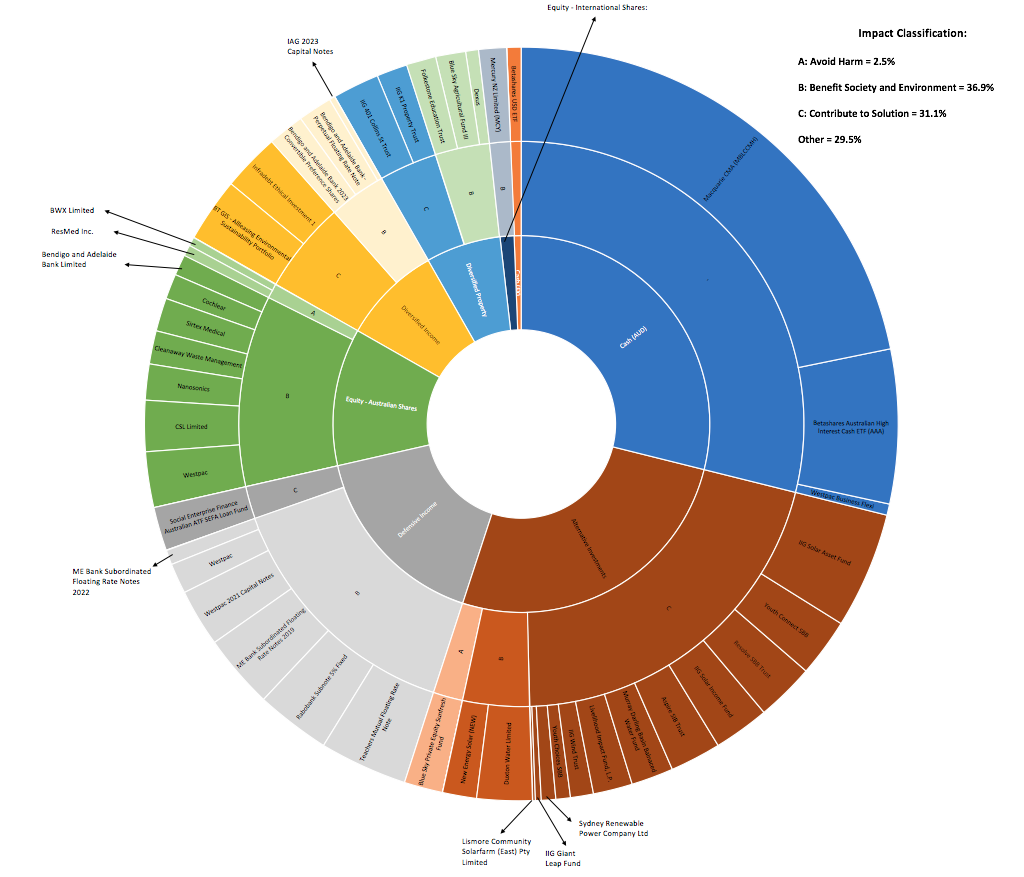
Generally, investors should attempt to keep categories broad as this minimises the risk of overlooking a potentially attractive investment opportunity because it does not fit the narrow definition of an allowable asset class.
Note that private ancillary funds and public ancillary funds are generally not permitted to give a security over, or in relation to, an asset of the fund. Exceptions are made for an agreement to guarantee the repayment of any money for the benefit of one or more eligible DGR1 entities. The current status of this restriction for eligible entities should be checked at the appropriate point in time.
“In addition to diversifying across asset classes, impact investors can increasingly diversify across impact sectors as markets deepen.” World Economic Forum
Portfolio rebalancing refers to the process of realigning the weightings of one’s portfolio of assets. Rebalancing involves periodically buying or selling assets in your portfolio to maintain a desired balance of asset classes.
As the value of any portfolio changes during a given period of time, due to factors such as market movements and varying levels of performance for different investments, trustees must rebalance a charitable trust’s investment portfolio in order to ensure that a diversified portfolio is maintained. For example, if public equities perform well during a period, this will result in equities now representing a greater proportion of the portfolio and may result in disproportionate asset weightings.
Portfolio oversight
Depending on the size of your foundation and its modus operandi, a standing impact investing committee of the board — perhaps an offshoot of the initial strategy development committee — can be a useful structure for selecting investments, reviewing performance, and suggesting course corrections where necessary.
This committee may:
- Submit potential investments for a vote by the board or have authority delegated by the board to make investment decisions.
- Set policies for approval by the board and set standards for managing the investment process.
- Monitor financial and social performance of investments.
- Make suggestions for developing strategic impact investing program areas (or collaborate with the foundation’s grant making committee to align overall strategy).
- Coordinate with the foundation’s investment and finance committees to ensure that impact investing is integrated into your foundation’s overall budgeting process.
Once your impact investing strategy is developed and approved by the appropriate governing bodies, it’s time to bring it to life with investment action!
PART 7


7.1 Understanding the importance of measuring impact
Introduction to impact management and measurement
Intentionality and measurable impact are the fundamental concepts that differentiate impact investing from traditional forms of investment. As the impact investing marketplace grows and becomes more dynamic, attention has turned to the importance of understanding and measurement impact - in understanding both the financial and social return on impact investments.
The increasing interest in impact measurement marks new and exciting opportunities for growth in the space. It is a chance to address the challenges that exist, in order to provide a more comprehensive understanding on how different tools and methodologies to measure impact can be adopted. The progress that has been made thus far, as explored in this document, is indicative of the extraordinary developments that have been made in the field. However, a strong potential still exists for development in the area - in order to further improve the consistency, effectiveness and applicability of impact measurement.
This section aims to provide an overview of the impact measurement tools and frameworks currently available. It does not, however, aim to provide a definitive answer on best practices. Rather, it aims to drive forward the impact measurement conversation and to fill in knowledge gaps experienced by charitable trusts and foundations.
It is important to recognise that the use of these tools and frameworks should be commensurate with such factors as the scale, complexity, and available resources of the investor and investee. Ultimately, an investor’s approach to impact measurement will be dependant upon, and reflect, their goals, objectives and capacities.
Defining impact measurement
Impact measurement can be defined as the activities taken to evaluate and report on the financial and social change generated by an investment. (1) Some studies have identified impact management as a separate process for data generation and analysis. For the purposes of this Document, impact measurement encompasses both concepts of measurement and management.
There is a clear sense that more work is needed to strengthen measurement systems….Some people noted that they have been seeing investments they regard as “impact light” entering the market, that is, investments delivering relatively low social or environmental returns or where accountability for outcomes is limited and little effort is being put into measuring those impacts. There was concern that if not managed appropriately, this could undermine the credibility of the developing market. Australian Advisory Board on Impact Investing (2)
Relevance to stakeholders
Impact measurement is not only integral to making effective impact investments but is a unique opportunity for all impact investing stakeholders. These stakeholders include: investors, investees, intermediaries, and the government.
For investors, impact measurement serves to facilitate understanding, accountability, and value creation. (3) Impact measurement is a powerful way for investors to assess the intended impact of prospective opportunities as well as the ongoing impact of their investment portfolios. By understanding the extent to which their investments can achieve or have achieved social and environmental goals, investors can hold themselves accountable and allocate their resources accordingly.
Similarly, investees can use metrics to determine their progress towards organisational goals and to improve their impact by continually monitoring and evaluating functions. (4) Investees also have an intrinsic motivation to measure impact particularly for forecasting and impact optimisation. For example, analytics around impact can inform investees of optimal distribution, geography, and pricing decisions to help increase real-time impact on the ground. Notably, this area is in its nascent stages and likely requires greater research and testing.
Measuring impact also benefits the broader impact investing sector, including intermediaries and government, as it can assist with institutionalising credibility and transparency. More than 90% of respondents in GIIN’s annual impact investor survey noted that a lack of sophistication in the practice of impact measurement was a challenge to the growth of the impact investing industry. (5) Therefore, greater focus in the measurement space is important to increasing deal flow and participation in the industry.
Application across the investment cycle
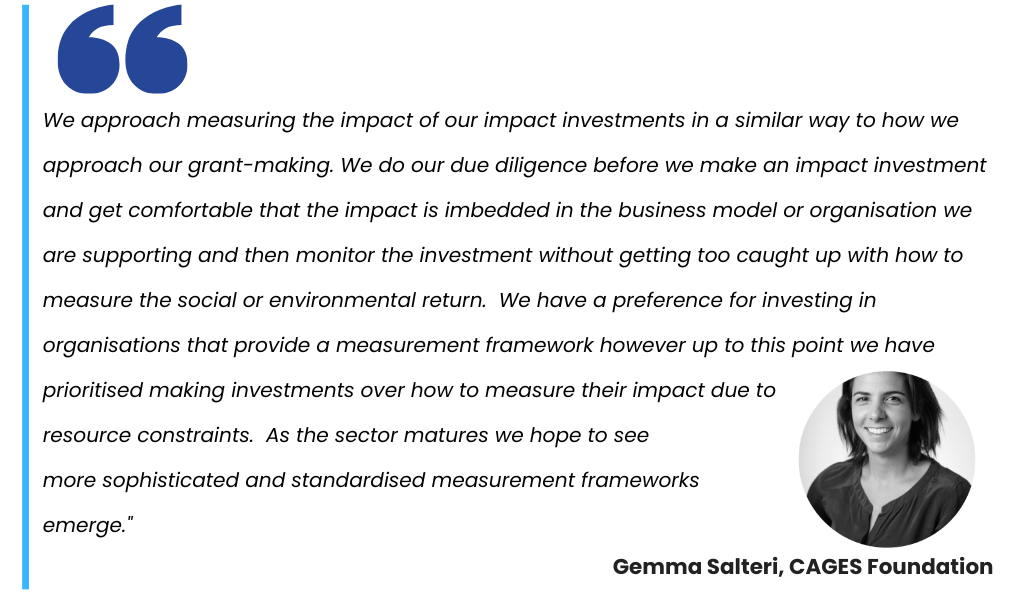
Impact measurement has been driven primarily by investors in the screening and due diligence phase of investments. As impact investors must balance the dual purposes of pursuing both social change and financial return, impact measurement tools (see for example, the Balanced Scorecard at Section 6.2) can assist investors in making informed investment decisions by balancing risk with potential return across various opportunities. Speaking to various Australian Charitable Trusts and Foundations, fund managers typically avoid implementing stringent impact measurement frameworks once due diligence is completed, instead expecting that there will be some form of social return or impact.
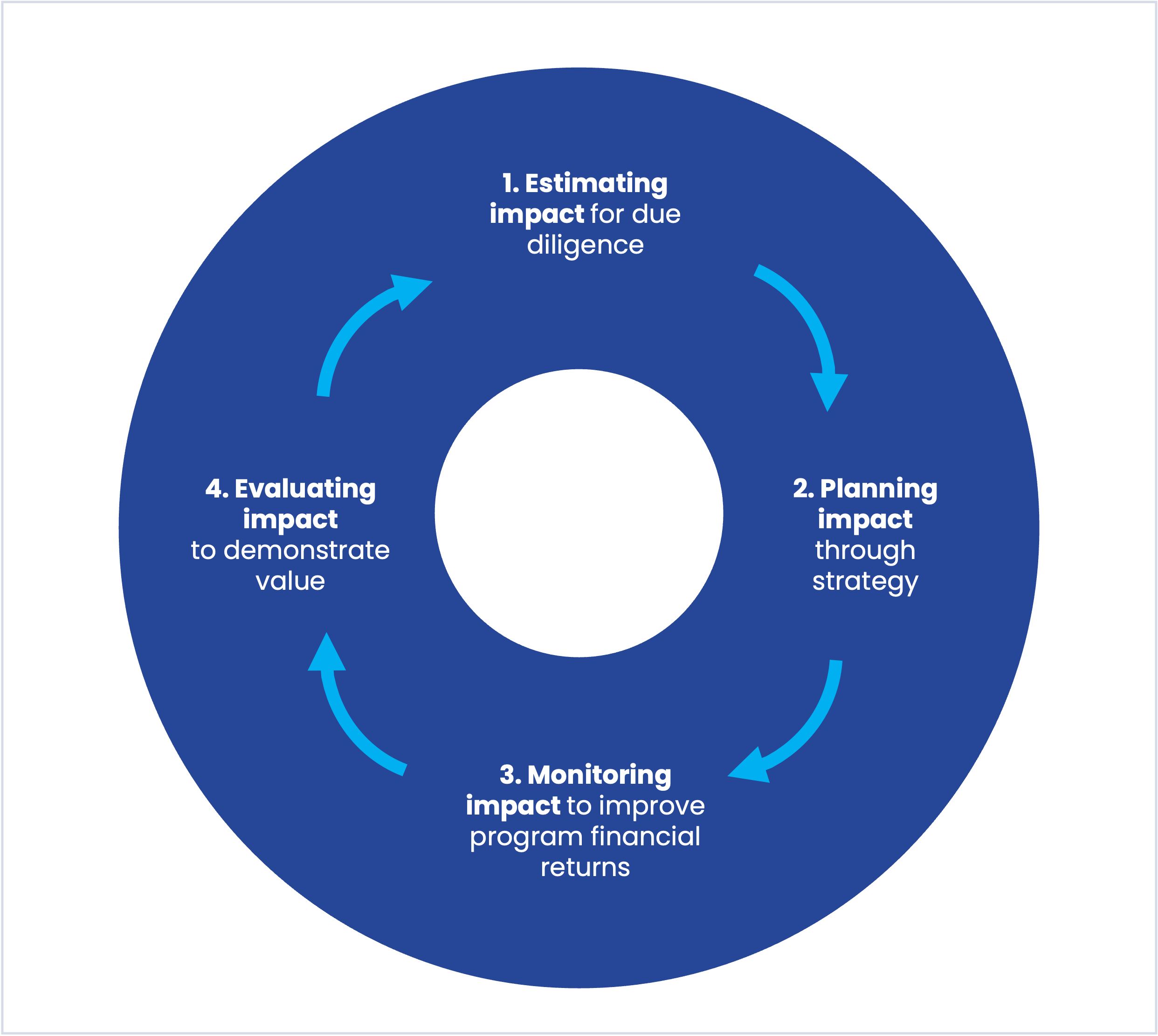
Figure 7.1 Estimating, Planning, Monitoring, and Evaluating Impact. (6)
While the focus has typically been on the due diligence phase, impact measurement has a role to play throughout the investment cycle and to various stakeholders. The cycle can be segmented across four key activities relating to impact (7):
- 1.Estimating impact: pre-investment or due diligence processes to estimate the amount of impact that can be created with an investment;
- 2.Planning impact: post-investment or during negotiation, deciding on approaches and tools to measure impact;
- 3.Monitoring impact: ongoing monitoring of progress to inform whether investee performance is on track;
- 4.Evaluating impact: evaluating the impact created by an investment at the end of the investment cycle.

Figure 7.2 Impact measurement can provide useful insights to the stakeholders involved. (8, 9, 10)
Challenges faced
It is clear that there is uncertainty surrounding measuring impact, particularly as there is no right way to do so, and the best method of impact measurement is generally investment specific. Here are some of the challenges that charitable trusts and foundations may face when measuring social outcomes:
- 1.Social problems are complex: Social problems are inherently complex, and so are their solutions. When tackling the root-cause of a social problem, impact outcomes may only be realised many years after implementation. Due to this, attribution issues also arise - this being whether the line of causality can be made between a particular intervention and impact. (11) Furthermore, it is often difficult to place an exact time-frame on the measurement of impact, particularly when accounting for the complex cultural and political factors involved in social change. (12) It is difficult to know whether the full result is ever fully captured.
- 2.Resources are hard to come by: Foundations may face constraints on investing the time and resources into adopting a formal impact measurement strategy. Measuring impact requires a level of research expertise, allocation of resources and commitment to longitudinal study, (13) which can stretch beyond the capabilities of the charitable trust or foundation.
- 3.Tools and frameworks are difficult to navigate: The complexity of tools and frameworks may make it difficult to even begin to approach measuring impact. Trusts and foundations may be faced with questions such as “what tool or framework best fits our current investment?” or “what outcomes should we measuring?”.
Despite these challenges, recent developments are creating a greater sense of clarity and feasibility in measuring the impact of investments. The remainder of this chapter focuses on these developments as well as the tools and frameworks currently available to assist with addressing and overcoming the challenges discussed.
7.2 Why and when to measure impact
Recent developments in impact measurement
The increasing interest and participation in impact measurement has given rise to notable trends and developments in the space internationally. Firstly, in response to the greater desire for consistency and benchmarking, the United Nations’ Sustainable Development Goals are increasingly emerging as a universal anchor point for investors. Secondly, the Impact Management Project, a global collaborative initiative, has marked a significant step forward in achieving a common language and shared fundamentals for impact measurement in the context of impact investing. Indeed, the next few years will be particularly exciting as the broader impact investing field grows, and hopefully with it, a consolidated way to measure and manage impact.
Mapping impact investments to the UN Sustainable Development Goals
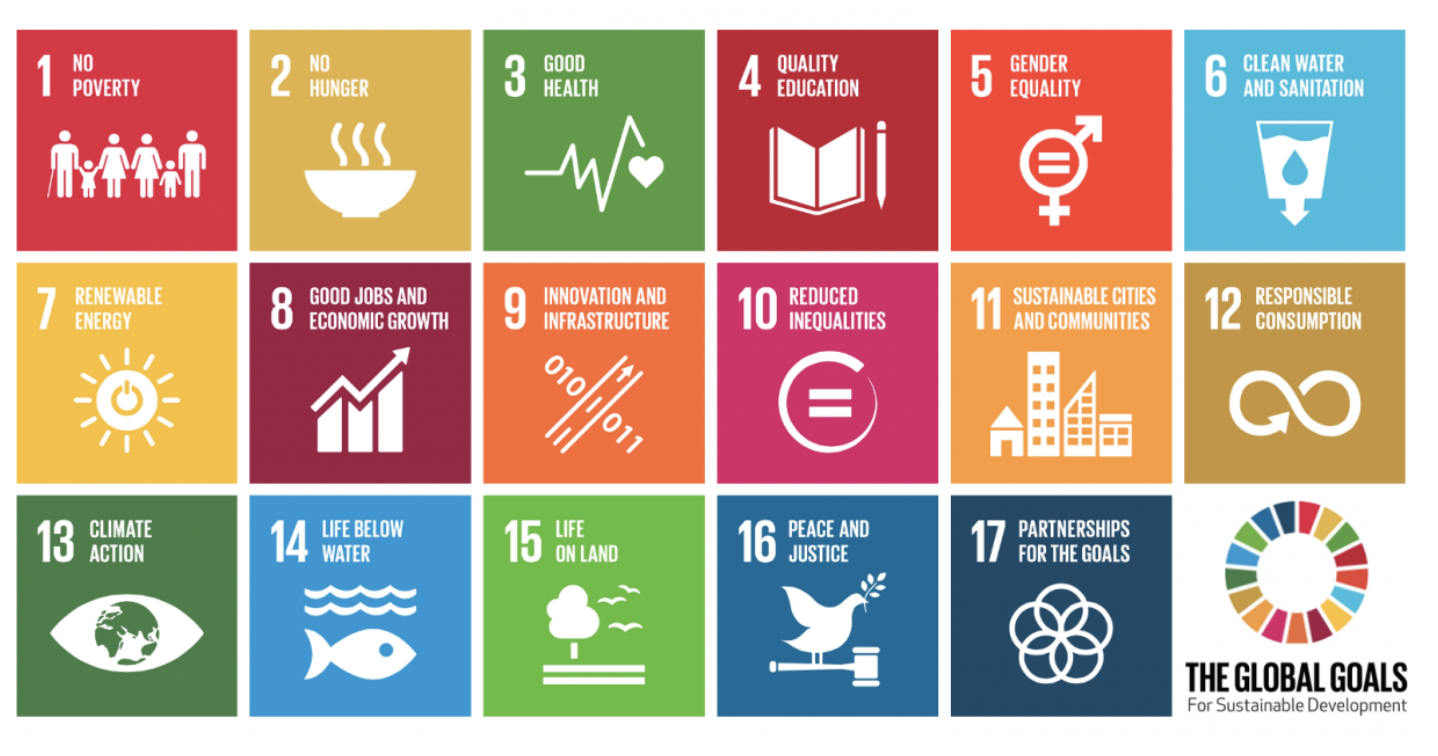
Figure 7.3 UN Sustainable Development Goals
With the launch of the United Nations’ Sustainable Development Goals (SDGs), a global agenda to end poverty and protect the planet by 2030, investors have been encouraged to consider how their investments might contribute towards achieving these goals. Each goal has targets that require financial investment yet a 2022 UN report estimates an annual gap of more than $4 trillion. The report identifies seven sources of funding that could generate up to $7 trillion annually towards achieving the Sustainable Development Goals. Impact investing will hopefully play a pivotal role in unlocking more private capital to achieve these goals. Some of the largest pension funds, asset managers, and increasingly charitable trusts and foundations have already taken up this challenge.
The 17 goals, shown in the chart above, are proving to be a convenient framework for investors to to communicate and articulate the relationship between their investments and impact goals. Although the goals are not equally investable, and not all goals are relevant to all organisations, some investors are viewing the SDG framework as a simple and effective entry-point and finding it helpful to focus on initiatives that address a few of them (14). Others have grouped together multiple goals, such as reducing poverty, increasingly gender equality, providing access to clean and affordable energy, and creating more sustainable cities and communities.
The GIIN annual impact survey has recognised the unique role that impact investing will play in achieving the SDGs, and this is reinforced by the finding that more than 60% of organisations surveyed actively track their investments against the SDGs or plan to do so soon (15).
7.3 Developments in measuring impact globally
Impact Management Project
The Impact Management Project saw the collaboration of over 700 organisations, hailing from different geographies and disciplines, to agree upon the shared fundamentals that should underpin how we talk about, measure and manage impact, including in the context of impact investing. The work emerging from this Project was driven by the recognition that in finance, shared fundamentals about performance allow financial goals and investor expectations to be managed. This common understanding is crucial in ensuring that investors are given the opportunity to achieve their intentions and goals.
The Impact Management project was an opportunity to spark conversation about the norms that would enable investors from all over the world to share reliable information about impact. The Project’s underlying philosophy, of having a shared understanding into how best address the effects experienced by the people and planet, is a step forward in exploring new and innovative ways to create and measure impact.
The initiative was wrapped into the The Impact Management Platform which is now a collaboration between leading providers of public good standards and guidance for managing sustainability impacts. Through the Platform, partnering organisations aspire to:
- clarify the meaning and practice of impact management;
- work towards interoperability and fill gaps as needed; and
- have coordinated dialogue, as appropriate, with policymakers.
One of the key innovations from the project was the Five Dimensions of Impact:

Figure 7.4 The Five Dimensions of Impact
The Five Dimensions of Impact provides a consistent tool for investors and impact investing practitioners to define and manage the intended impact. It has become widely used internationally and provides consistency to make sure everyone is talking the same language.
The five dimensions include what the intended outcome is, who experiences it, how much of the outcome is experienced, the contribution of the business to that outcome, and the risk that the impact doesn’t happen as planned.
Approaches to impact measurement
“We need to connect people to impact investing through story and experience….We see [impact investing] as a rational movement that is driven by measurement. Measurement is important but does NOT move people. In almost all cases it supports our belief system. Very occasionally people change their beliefs due to data, but mostly they change their beliefs due to emotional experiences.” Australian Advisory Board on Impact Investing (17)
There is no single approach to measuring impact. The wide range of tools and frameworks available means that approaches to impact measurement can be tailored to the specific objectives and capabilities of the particular social enterprise and investor. Approaches can span different combinations of quantitative and qualitative measurement and ideally both in impact investing context as it is often difficult to define impact with numerical figures alone. In determining your approach, you should take into account the nature and complexity of the social enterprise, and time, resources and capabilities available to you.
From the perspective of a charitable trust or foundation, there are three main approaches to impact measurement:
Approach 1: Do It Yourself - Measurement by an investor and/or investee
It is possible for charitable trusts and foundations to develop their own impact measurement plans although their level of involvement may vary. On one end of the spectrum, measurement may be a collaborative effort between the investee (e.g. a social enterprise) and the charitable trust or foundation, who may be heavily involved in decisions around metrics and benchmarks. At the other end, the investee may work independently to provide impact assessments to the trust or foundation, who in turn can audit the impact reporting when necessary. This is based on the belief that the investee is generally best positioned to report on its own impact, just as it provides financial reports to investors. Of course, impact measurement approaches in this category may fall between these two ends of the spectrum.
Approach 2: Measurement through a fund manager
Individual investors may elect to have a fund manager invest on their behalf. The fund managers will often conduct impact assessments as they see appropriate to the investment, and report to the investors. An example of this approach would be that taken by Australian Impact Investments, described later in the chapter.
Approach 3: Measurement through a third-party or intermediary
Another alternative is to leverage services offered by third party intermediaries that can help social enterprises and investors conduct impact measurement. Typically, these intermediaries will have their own proprietary approach to measuring impact. A one-off fee or subscription may be required to access these services. The table in Section 6.2 above, provides a range of organisations in Australia that provide these services.
7.4 Tools & frameworks to measure impact
Purpose
There are many impact measurement methodologies that have arisen alongside the growth of the impact investing industry.
The purpose of this section is to provide an overview of the types of impact measurement tools that are relevant to and currently being used in the impact investing industry.
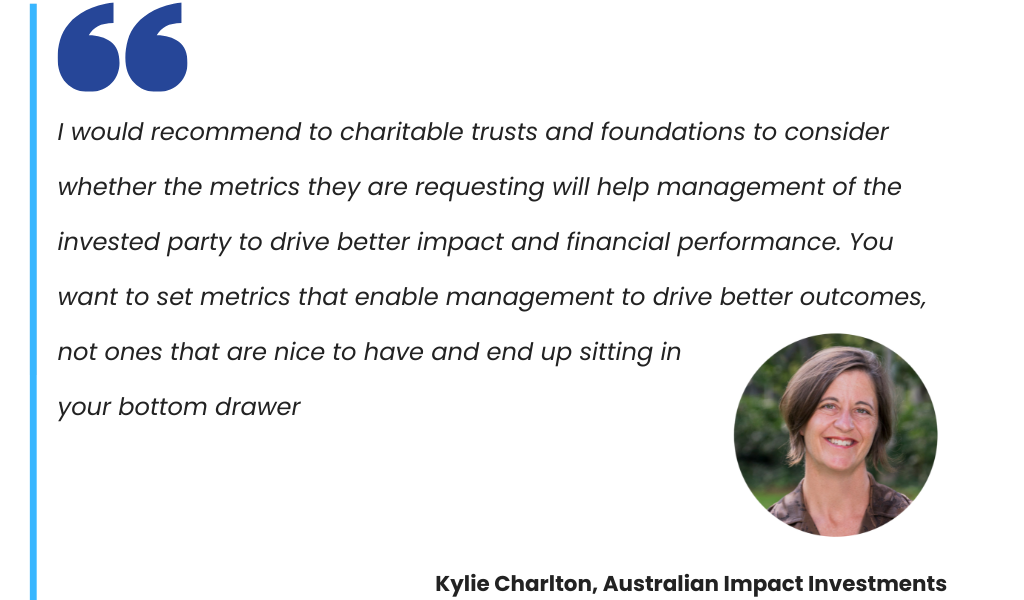
Importantly, the impact measurement framework chosen should be appropriate and scaled to the investment. The alignment of the goals of the charitable trust or foundation against those of the investees should also be considered, as output information linked to business success becomes more useful to the running of the business (18).
7.4.1 Models and frameworks
Models and frameworks are high level tools that can be leveraged to assess overall project or business success. These tools can be used to set up an overarching impact measurement framework and to which other metric-based tools can then be integrated.
In recent year, the proliferation of numerous models and frameworks has resulted in calls for harmonisation and consistency across the impact investing sector.
In the 'Impact Stack' report, John Treadgold highlights that the consolidation and harmonisation of impact measurement frameworks represents an inflection point for the impact investing sector.
The report presents the ‘Impact Stack’ – a toolkit of frameworks that can be used as a best-practice model for impact measurement and management (IMM), in service of an overall impact strategy (19):
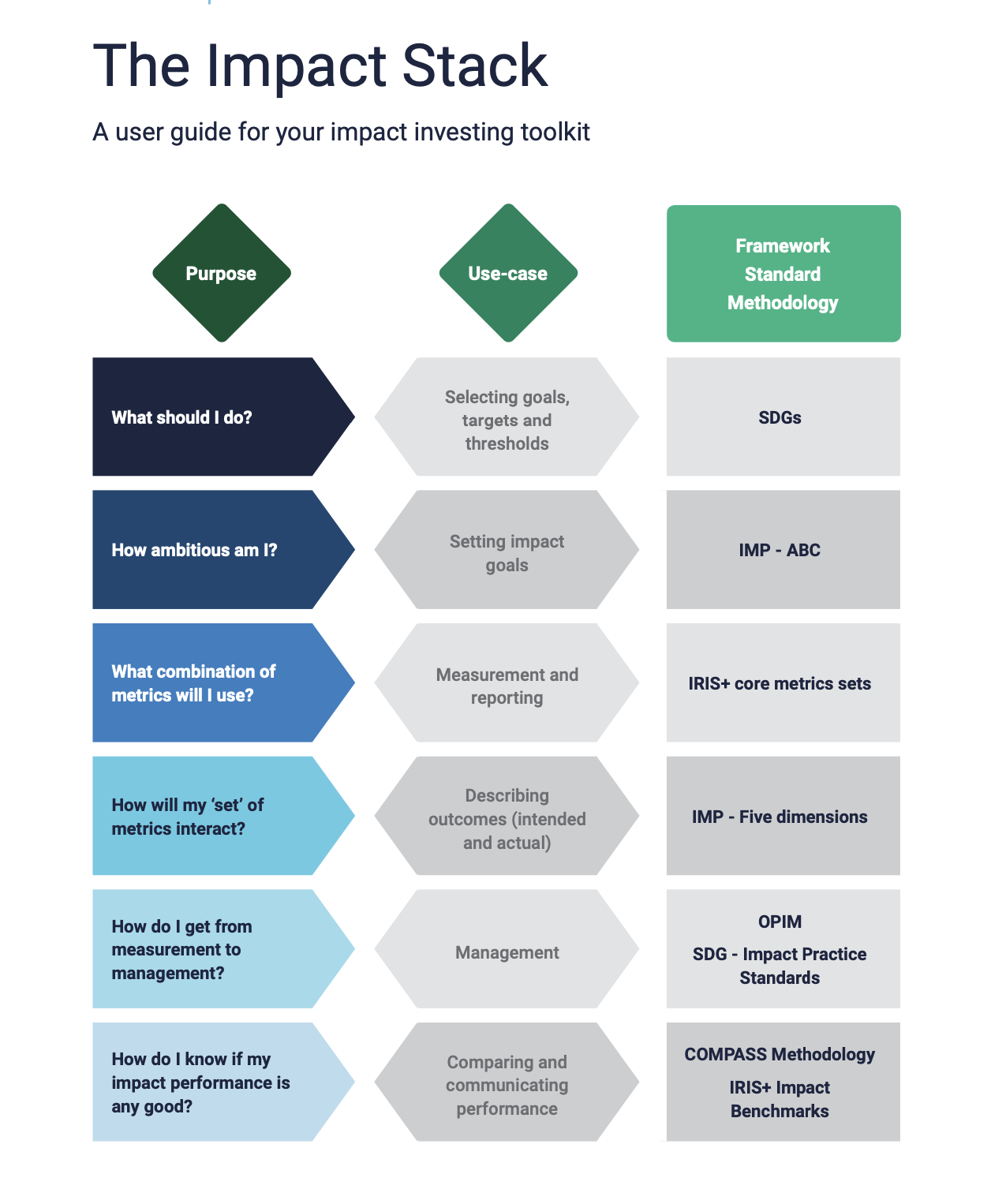
Figure 7.4 The Impact Stack Toolkit
The Global Impact Investing Network (GIIN), 2023 GIINsights: Impact Measurement & Management Practice report, found Investors most commonly use the SDGs to guide their impact strategy and use IRIS+ for measurement and management, with increasing integration of IMM into their organisational budgets (20)

Figure 7.5 Global Impact Investing Network (GIIN), 2023 GIINsights: Impact Measurement & Management Practice
Other frameworks that are helpful to be aware of, especially as the worlds of impact investing and ESG investing continue evolve, include:
Framework | Description |
The International Integrated Reporting Framework and Integrated Thinking Principles have been developed and are used around the world, in 75 countries, to advance communication about value creation, preservation and erosion. The cycle of integrated reporting and thinking result in efficient and productive capital allocation, acting as a force for financial stability and sustainable development. | |
The Navigating Impact project provides investment themes through which to explore possible impact approaches. Stakeholders consulted agreed that this approach is consistent with the way an investor thinks about their portfolio, allowing the investor to either take a deep dive into one investment theme (E.g. Affordable Housing), or to look at the probable outcomes within multiple investment themes and assemble a combination of strategies that complement their portfolio goals. Investment themes include a series of strategies that show different ways investors might frame their impact goals. For example, under the investment theme on Smallholder Agriculture, interested investors can select from strategies like “Improved Access to Training and Information,” “Improved Farm Profitability,” and “Improved Food Security,” among others. Each strategy includes an overview of the strategy, an evidence map, a core set of metrics that are shown to indicate progress toward that strategy’s objectives, and curated resources that can help measure and manage toward the strategy. | |
Based on needs and trends from the UK, the Social Outcomes Matrix represents nine outcome areas which reflect what a person needs to have a full and happy life. Each outcome area has a set of related measures to assist with assessing social impact at an individual level and for the community. These measures are intended as a helpful starting point for organisations and intermediaries. | |
Results Based Accountability (RBA) is a planning, monitoring, evaluation and continuous improvement framework that focuses on outcomes. It utilises a data-driven, decision making process to help both communities and organisations take actions and solve problems. In terms of community, the RBA is able to help identify the progress a community is making towards achieving community well-being. However, in organisations, RBA can help identify the role and impact of the organisation in the wider community by evaluating the beneficiaries of the goods or services that the organisation provides. | |
Logical and flexible framework which enables organisations to build on existing documentation and reporting processes to prove, improve and account for the social value generated by the organisation. Uses eight key principles to underpin its process. Can be used by any organisation, including public and private sector organisations of any size and scale. |
The Centre for Social Impact (CSI) 'Compass' Guide also provides a range of techniques and approaches for impact measurement (Appendix B).
7.4.2 Metrics and Ratings
Metrics and ratings refer to tools and techniques that can be used to measure and track impact performance. Typically, these metrics and ratings are measurable and quantifiable, and can be tailored to fit specific sector needs. Metrics and ratings are often the underlying building blocks for more advanced theories, models and frameworks. It's worth noting that this space is continuously evolving, so it can be helpful to either source external support, or consider how you will invest the time to make sure your approach to measurement continues to be fit-for-purpose:
Metrics and ratings | Description |
All investors and companies create positive and negative effects on society and the environment. Impact investors seek to maximise the positive and minimise the negative by using the IRIS+ system to integrate social and environmental factors into investment decisions alongside risk and return. Credible, comparable impact data are needed to inform impact investment decisions and drive greater impact results. IRIS+ solves for this by increasing data clarity and comparability, and it provides streamlined, practical, how-to guidance that impact investors need, all in one easy-to-navigate system. It is a free, publicly available resource that is managed by the Global Impact Investing Network – the global champion of impact investing. | |
Social Return on Investment is a methodology that aims to quantify social impact by attributing a monetary value to particular outcomes. The SROI Network and the SROI Toolkit are two customisable assessment and management systems utilising SROI principles. | |
Strategic planning and management system used by organisations (including for-profit organisations) to communicate what is trying to be accomplished, align day-to-day work, prioritise projects/products/services and measure and monitor progress towards strategic targets. In a social impact context, the balanced scorecard can be modified to account for impact. For example, New Profit uses a modified balanced scorecard to measure performance in terms of five outcome perspectives: social impact, financial, customer, business process, and learning/growth. | |
HIP Impact Ratings score and rank investments using material metrics from operational outcomes, products and services, and management practices. Specifically, HIP organizes data and constructs and analyzes 260+ metrics to assess the impact and risk for any investment. All ratings are on a 0-100 scale where 0 is net-negative impact (more extractive) and 100 is net-positive (more generative). |
Bush Heritage is a national non-profit organisation conserving biodiversity in Australia. The organisation achieves this by buying and managing land of outstanding conservation value, and working in partnership with other landowners, particularly aboriginal communities. Bush Heritage helps protect native habitats on millions of hectares of the most ecologically important landscapes.
Bush Heritage uses IRIS metrics to report the results of the organisation's conservation actions through its Annual Report. These organisation-wide metrics are aggregated from data collected and analysed at project and regional levels through Bush Heritage's conservation management process.
This process requires a clear theory of change for each project, including definition of a range of output, outcome and impact metrics. Bush Heritage has aligned these "bottom-up" project metrics with the standard metrics in the IRIS catalog to allow organisation-wide monitoring and reporting of the organisation's impact.
Examples of IRIS metrics used by Bush Heritage include Protected Land Area: Permanent (PI3924), Area of Adjacent Protected Land (PI5750), Threatened Species Policy (OI1618) and Ecosystem Services Provided (PD8494).
7.4.3 Third Party Assessment
Third party assessment refers to services offered by third parties that can help social enterprises, intermediaries and investors conduct impact measurement. As opposed to other impact measurement tools, these services can only be accessed through the third parties and cannot be self-conducted by stakeholders. Some examples are provided below:
Third party assessment | Description |
B Corp is a certification standard which takes into account an organisation’s social and environmental performance, accountability and transparency. It is managed by the nonprofit B Lab, which launched its Australian arm in 2014. The certification by B Lab ensures that the enterprise meets a minimum set of standards with regard to the impact that it generates, and 10% of B Corps are audited by B Lab each year to maintain the integrity of the certification. Some impact investors like Small Giants use the B Corp certification as an impact assessment tool and insist that all their investee companies become B Corporations. | |
Aeris is a portfolio management and benchmarking tool that provides standardised data on financial and impact performance of community development financial institutions (CDFIs). It assists in allowing the evaluation of opportunities to meet the impact goals and risk parameters. The tool is currently limited at the moment to CDFIs within the US, however it serves a wide range of causes in terms of promoting financing for economic equality, environmental sustainability, food access, health care, education, affordable housing, amongst a range of other causes. | |
Sinzer is a online tool for social impact measurement. It allows all types of parties including social enterprises, investors, intermediaries and public authorities to measure, monitor and manage their social impact. The Sinzer platform can be used to manage and collect data, visualise data and analyse results. It uses popular impact metrics (e.g. IRIS, SDGs), and can plug into various frameworks. |
The GIIN has also developed ‘The Impact Toolkit’. This is a digital database that consolidates many of the impact measurement resources available to investors, intermediaries and social enterprises.
7.5 Conclusion
Impact investments are inherently unique in that they deliver both a financial and social/environmental returns. As such, measurement plays an important role in allowing a range of stakeholders across the investment lifecycle to understand the true impact delivered by an investment. Although still in its nascent stages, significant progress has been made in developing and demystifying the application of measurement in impact investing.
Importantly, challenges in measuring impact such as attribution and a lack of resources, are being addressed by innovative developments in the field. Notably, the use of the UN SDGs have helped investors align their investments to broader social goals and enabled greater ease of access to the impact investment space. Industry standards and best practices are also emerging as measurement tools and frameworks continue to develop and gain traction amongst leading investors and social enterprises. One example, is an initiative called Impact Weighted Accounts, which is driven by the Harvard Business School. The mission of the Impact-Weighted Accounts Project is to drive the creation of financial accounts that reflect a company’s financial, social, and environmental performance. The ambition is to create accounting statements that transparently capture external impacts in a way that drives investor and managerial decision making.
With these developments, the next 5 years will prove to be an exciting time for impact management and measurement as it continues to evolve.
Spotlight on.
Australian Impact Investments impact framework
A great example of an impact measurement approach that has been adopted in Australia is the impact framework developed by the Australian Impact Investments team. It demonstrates a way in which many concepts and methodologies related to impact measurement can be utilised to create something unique to a specific organisation’s goals and impact outcomes.
Australian Impact Investments is a financial advisory group specialising in designing, implementing and managing impact investment portfolios for wholesale investors.
The Australian Impact Investments team has developed a three-dimensional impact framework to assess impact investments. Their framework draws upon the team’s three prior years of impact investing experience, as well as insights from the Impact Management Project and J.P. Morgan.

Sycamore School example
Sycamore School is an educational institution providing full-time primary school education for up to 70 autistic children a year in Alexandria Hills in south east Queensland. The impact goal of Sycamore School is to lay the foundations for good social interaction skills and enable their students to become positive, independent contributors to society. This fits the goal under SDG 10: Reduced Inequalities to promote the social and economic inclusion of people with disability.

The Sycamore School scores highly for ‘Impact’ on the Australian Impact Investments framework. It produces deep and sustainable impact for participating children, can manifest itself relatively quickly and has a high likelihood of achieving the impact.
However, there are some risks associated with the Sycamore School project. In particular, the investment risk of the Sycamore School is regarded as high.
In terms of financial return, the target return of the Sycamore School project to investors is around 7-10% per annum. This represents below market return relative to other investments with a similar risk profile.
PART 8


Ways to develop the market
As active participants in the market, or even as non-investors who believe in its potential, there are many opportunities for charitable trusts and foundations to support the developing impact investment market and help it to thrive. We have identified three key capacities in which Australian charitable trusts and foundations can and do provide crucial support for the impact investing ecosystem:
- 1.As investors and catalysts: investing financial capital in social enterprises and organisations in the form of impact investments for principally social return, or utilising capital to catalyse or de-risk impact investments;
- 2.As capacity builders: providing grants, technical assistance, sharing expertise, or providing investments that build capacity in social enterprises and non-profit organisations; and
- 3.As engagers: supporting the ecosystem, including intermediaries, building awareness through research and advocacy, and sharing insights and opportunities in the impact investing space with donor and investor communities.(1)
8.1 Invest or grant to catalyse additional capital for impact
Investors and catalysts
Active participation by charitable trusts and foundations as investors in the impact investment market builds track record, contributes to the growth of the ecosystem, and helps build market scale. (2)
Catalytic impact investment by charitable trusts and foundations represents one of the most powerful opportunities to maximise and leverage impact by attracting additional flow of capital from mainstream investors to social and environmental solutions. Early stage investment from charitable trusts and foundations can build credibility and de-risk investment opportunities that would have previously not have attracted mainstream investors. Further, impact investment by charitable trusts and foundations can also be used to build volume and credibility in organisations and businesses.
Blended Finance
Blended finance instruments (explored in more detail in Part 2) are an emerging mechanism through which capital can be strategically leveraged for impact investments. A blended finance instrument typically consists of a combination of grant funding, guarantees, debt and equity, providing mechanisms through which investments can be de-risked. This encourages greater participation in the impact investing ecosystem by investors with differing risk appetites, and contributes to expanding overall deal volume.
Charitable trusts and foundations are uniquely placed to provide different types of capital, including grants, in blended finance structures. The development of standardised and scalable blended finance products is a key area that would support the growth of the impact investing ecosystem. It needs investors willing to get on board to test structures and products, and in so doing, inspire others to join.
See below for a closer look at the Tender Funerals transaction, for which Social Enterprise Finance Australia (SEFA) developed an innovative social finance model, collaborating with the Vincent Fairfax Family Foundation (VFFF) to co-finance a deal that combined debt and philanthropy to enable conversion of a building into a mortuary for a start-up funeral business.
Further information about blended finance and examples of recent blended finance transactions can be found in Part 2.
Spotlight on...
TENDER FUNERALS
“Death affects us all and is an integral part of life. We will all die and we will all, at some time, face the death of beloved family members and friends.”
Tender Funerals provides a holistic, caring, and personalised approach to after death care and funeral services, with a focus on ensuring that cultural, family or community traditions are respected and met.
Established in 2014 as a not-for-profit, social enterprise initiative of the Port Kembla Community Project, Tender is a unique example of how blending different types of capital enabled truly impactful collaboration between a community organisation, a foundation, a social lender and the public.
Tender was able to use the proceeds a very successful StartSomeGood crowdfunding campaign for seed funding to get to market. Further funding from mission-aligned partners helped Tender to move beyond start-up phase. Social Enterprise Finance Australia (SEFA) which is at the forefront of developing innovative social finance models in Australia, then collaborated with the Vincent Fairfax Family Foundation (VFFF) to co-finance a deal that combined debt and philanthropy - a loan from SEFA Partnerships assisted with the purchase of the former Port Kembla first station, and a grant from VFFF enabled conversion of the building into a mortuary.
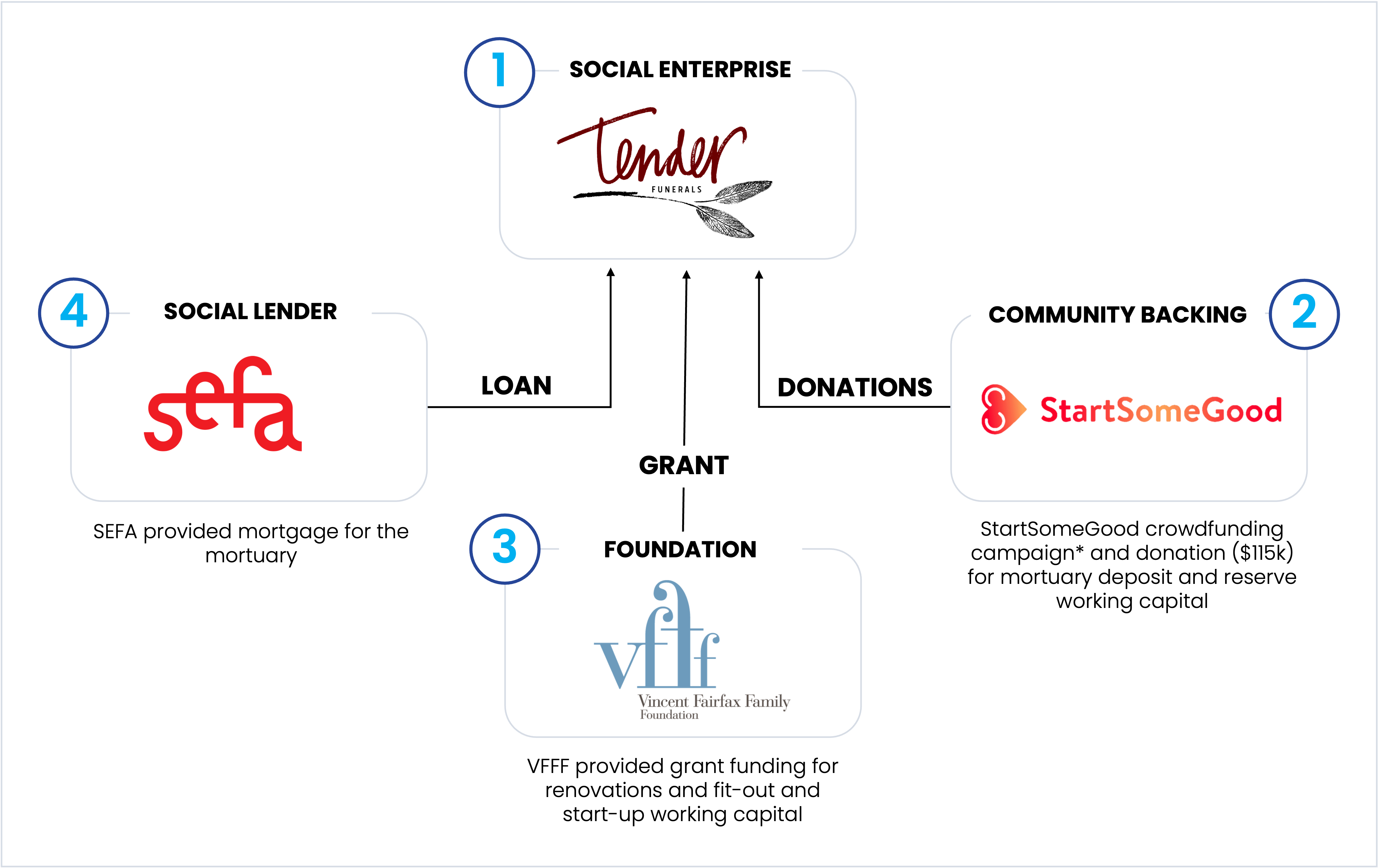
What SEFA said about the transaction:
Tender is the first partnership of its kind in Australia. It demonstrates the power of a collaboration between a community organisation, the public (via crowdfunding), a foundation and a social lender that together create a very strong base for a sustainable social enterprise start-up.’
What Vincent Fairfax Family Foundation said about the transaction:
The free flowing communication between the three organisations, and SEFA’s willingness to share its insights on financials, streamlined the Foundation’s processes and opened the door for collaboration in our newest strategic program – impact investment.’
De-risking and catalytic first-loss capital
As we explored in Part 2, charitable trusts and foundations can drive greater capital flow into the impact investing market by providing first-loss capital and other de-risking instruments, . Providing first-loss capital typically involves the use of grants, guarantees, subordinated debt or junior equity to absorb any first losses that are incurred. This reduces the risk to other investors, and catalyses investment by investors that otherwise would not have participated (3).
Instruments commonly used to provide first-loss capital include:
Instrument | Description |
Grants | A grant provided for the express purpose covering a set amount of first-loss. |
Guarantee | A guarantee to cover a set amount of first-loss.* |
Subordinated Debt | The most junior debt position in a distribution waterfall, with various levels of debt seniority (where there is no equity in the structure). |
Junior Equity | By taking the most junior equity position in the overall capital structure, the Provider takes first losses (but perhaps also seeks risk-adjusted returns); this includes common equity in structures that include preferred equity classes. |
*(4) Note: if a PAF guarantees a financial institution’s loan to a Deductible Gift Recipient, the PAF can claim the discount between its income and the market interest rate as part of its distribution requirements (see Part 4).
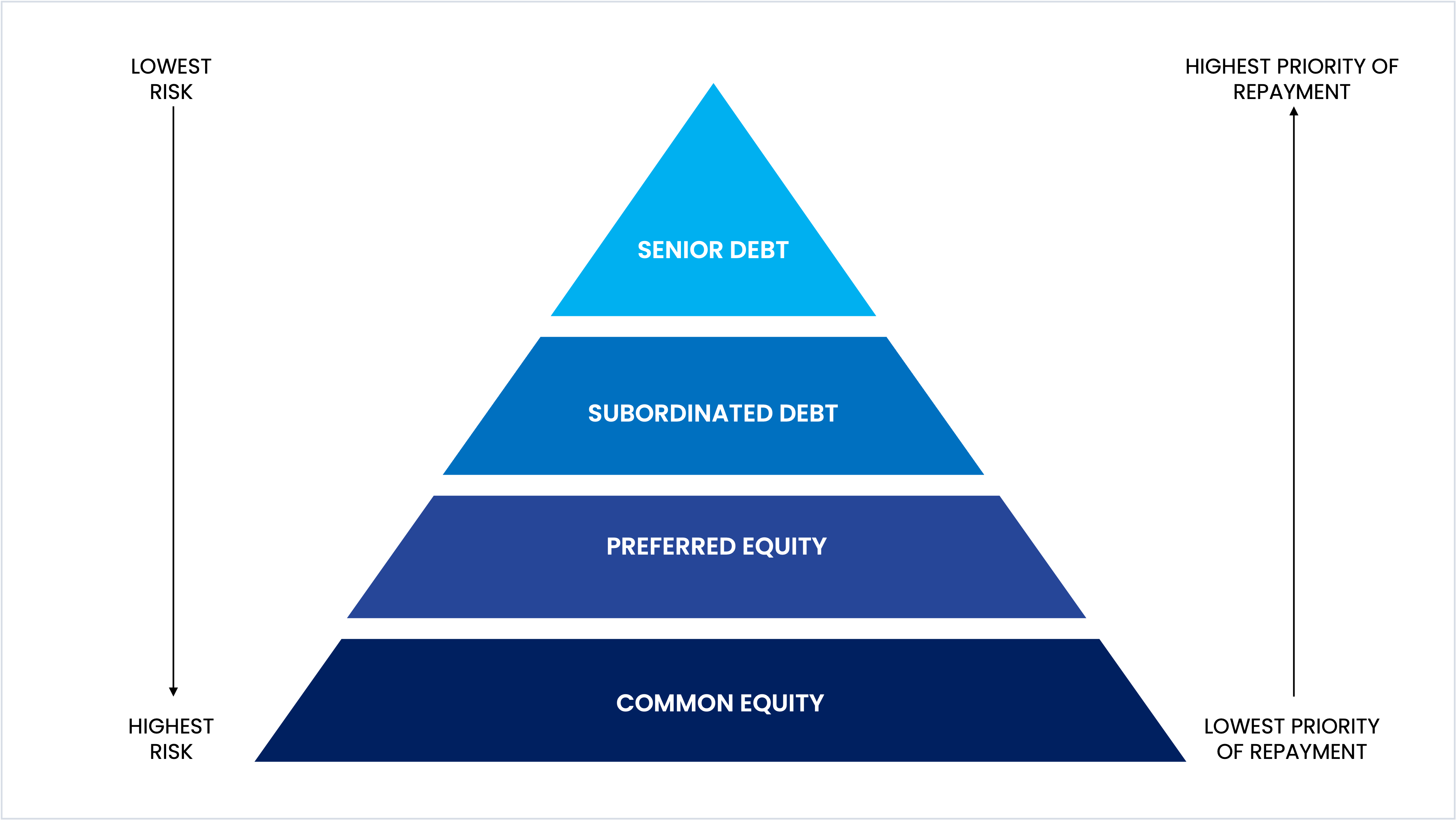
Figure 8.1 Overview of different capital types in terms of repayment priority and risk
By taking first-loss capital positions, charitable trusts and foundations can help develop and enhance the pipeline of investments that are fundable by the wider impact investing market. This will help demonstrate the long-term commercial viability of the impact investing ecosystem to wider investors, encouraging them to continue to impact invest without credit enhancement.
Spotlight on...
THE SVA DIVERSIFIED IMPACT FUND
AN INNOVATIVE USE OF A GUARANTEE TO COVER FIRST LOSS
The role that PAFs played in providing first loss protection to investors in the Diversified Impact Fund was important to maximise fund size. This was particularly relevant for new impact investors because it allowed them to gain exposure to the space while having their risk significantly reduced. Our hope is that with the continued development of the market, and growing investor confidence, we may not need this support in future funds but it was critical at this point in the evolution of the social impact investing market.
Michael Lynch - Managing Director Social Infrastructure Investment Partners (previously SVA)
Social Ventures Australia closed the raise of a $15 million Diversified Impact Fund (DIF) in March 2018. The DIF invests in social and affordable housing, social enterprises, impact businesses, non-profits and social impact bonds. The Fund replaced SVA’s $9 million Social Impact Fund (SIF), which had $4 million of government grant money. The SIF made 10 investments, created more than 160 jobs for disadvantaged Australians and enabled the construction of 22 social and affordable dwellings, and returned approximately 6.7% p.a. since inception.
The DIF featured an innovative 20% downside protection structure ($3 million) which is supported by 11 leading Australian PAFs and philanthropists. It is structured as a series of callable loans, with the money only called in the event of a shortfall at the end of the Fund. PAFs are not paid for providing the guarantee, but are able to count the implied market value of doing so against their 5% Minimum Annual Distribution. PAFs can count the following notional distributions:
- Annual commitment fee: 3% of callable loan amount for the full 10 years of the DIF (or until the loan is called)
- Interest rate: 3%+ RBA cash rate of any amount of the Loan drawn down for the duration it is called; and
- Loan forgiveness: Any amount of the Loan drawn and later forgiven.
Below is a summary of how the downside protection works:
- 1.Investors commit $15m into the Fund and PAFs separately commit $3m of downside protection via a series of callable loans. The Fund invests in a series of impact investments.
- 2.At the end of 10 years (or the early termination of the Fund), the Trustee calculates whether investors have received $1.00 per unit in combined capital and income distributions.
- 3.If a shortfall exists, SVA will call upon the callable loan from the PAFs, up to $0.20 per unit.
- 4.SVA provides the PAF moneys to the Fund via a back-to-back callable loan.
- 5.The callable loan will be repaid to the extent that the Fund realises assets following the Fund termination. PAFs agree to forgive the remaining amount of the loan.
8.2 Build capacity & help social enterprises become investment ready
Capacity builders
Charitable trusts and foundations can support the ecosystem by building the capacity of social enterprises and the broader impact investing ecosystem.
For example, a foundation may make a seed grant to help a social enterprise with a pilot program to prove their model, and then once they have revenue, make a loan to the social enterprise out of their corpus to help them scale the program.
Spotlight on:
ACCESS FOUNDATION
Access. the Foundation for Social Investment has a mission to make sure charities and social enterprises can access the finance they need to sustain or grow their impact.
Charities and social enterprises often struggle to access finance from mainstream lenders like banks. Social investment plays a vital role in ensuring these organisations have access to the capital they need to deliver long-lasting, tangible economic and social benefits in their communities.
Access targets those most in need of patient and flexible investment through:
- Funding enterprise development and blended finance programmes in England.
- Sharing knowledge and data and translating it into practical insight that others can use.
- Mobilising others who share our goal of making capital work for communities.
Access Foundation's Programmes
Through their programmes, Access develop the financial resilience of charities and social enterprises, while making sure more of our money flows to underserved places and communities. They achieve this by:
- Enabling the continued growth of blended finance, providing grants to social investment providers to blend with other forms of capital – this enables them to provide the kind of finance that most charities and social enterprises need.
- Supporting the capacity and resilience of key partners, while nurturing partnerships that can grow and live independently of us.
- Supporting six place-based partnerships via our Local Access programme creating strong local ecosystems that will enable the social economy the thrive and to build more diverse and resilient organisations that can deliver for their communities.
- Running programmes to support charities and social enterprises to increase and diversify their income through enterprise activity, and explore how social investment can help.
- Promoting a better understanding of revenue models in different sectors, highlighting the impact that enterprise grant-making and support can make.
Each quarter, the organisation makes a dashboard available, showing cross-programme data. an example is provided below:
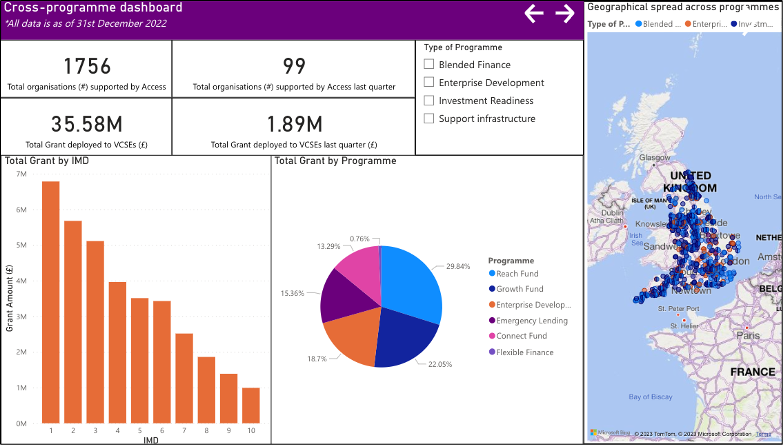
Incubators
One challenge often cited to be impeding growth of the impact investing sector is a lack of investment-ready social enterprises. There are more than 20,000 social enterprises in Australia and, while the number is growing, many social enterprises struggle to find and connect with the right knowledge and funding opportunities. This is where incubators play an important role in connecting social entrepreneurs with mentors, advice, assistance and, importantly, investors. Charitable trusts and foundations can assist by providing support to incubators through funding incubator’s operational costs, offering grants for aspiring social entrepreneurs, providing loans to organisations participating in incubator programs, or assisting with mentoring and skills sharing.
Foundations have the capacity to share capabilities and expertise through tailored programs. For example, KickStarter is a business planning competition and small grants program funded by the Macquarie Group Foundation which leverages the capability of Macquarie staff to support social enterprises.
Philanthropy for early stage impact ventures
Philanthropy alone generally cannot solve large-scale and complex social problems, but it can play a key role in supporting innovative ideas to address these problems. (5) Philanthropic grants, or donations with no expected return, are especially important in allowing early-stage enterprises to show proof-of-concept and to gain scale. These grants can support the function of enterprises in pioneering stages which require capital input to build their sustainability and reach. For example, Social Ventures Australia’s (SVA) venture philanthropy model connects philanthropists to ventures, and the funds are used not only to increase impact but to prove what they are doing works. (6)
Similarly, the Impact Investment Ready Discovery Grant program provided not-for-profits with grants up to $50,000 to explore pathways towards financial sustainability and enable capacity building towards future impact investment propositions. The initiative was established by Philanthropy Australia in partnership with NAB. In 2018, Philanthropy Australia received 110 applications for Discovery Grants, and awarded 12 grants with a total value of $530,000. A further 12 applications were strong and fundable, but did not receive Discovery Grants due to limited funds available. With more philanthropic capital available, more promising ideas and initiatives can be funded to kick-start more journeys towards impact investment readiness.
In order to address the social and environmental challenges facing Australia, we need a strong and vibrant not-for-profit sector with the capacity to develop and implement high quality impact investing programs.” Sarah Davies, CEO, Alannah & Madeline Foundation
Impact investment readiness work
Grants supporting impact investment readiness can help an organisation to deliver impact at scale by enabling it to focus on developing its capacity and capability to seek and utilise impact investment. While this section addresses financial help via grants, examples of non-financial impact readiness support include mentoring, seminars and workshops, courses, and bespoke professional advice.
The Impact Investment Ready program comprised of two grant programs: the Impact Investment Ready Growth Grant managed by Impact Investing Australia and the Impact Investment Ready Discovery Grant managed by Philanthropy Australia (discussed above).
The Impact Investment Ready Growth Grants provided impact businesses and mission-driven organisations with grants of up to $100,000 for business, legal and other capacity building support from providers to help secure investment. (7) The Growth Grants were originally established as the Impact Investment Readiness Fund with seed funding from NAB. Since its launch, the Fund has supported over 22 organisations on their journey to investment readiness, unlocking over $41 million in impact investment capital. (8)
The Impact Investment Ready Growth Grants play an important role in driving social innovation in Australia. It is supporting for-purpose businesses to connect with and attract impact investors, helping them to achieve scale and deliver greater social and environmental impact.” Daniel Madhavan, Partner - Ecotone Partners (ex CEO of Impact Investing Australia)
As the sector evolves, there is a critical role for the Australian Commonwealth Government to continue to support the social enterprise sector, especially during the investment readiness phase of growth and capital raising period, which is typically intensive. Charitiable trusts and foundations also have the opportunity to work collaboratively to fund investment readiness of the social enterprise ecosystem.
For example, the English Family Foundation (EFF) has provided grant funding to help organisations cover their operational costs while they are focused on becoming impact investment ready. In acknowledging that becoming impact investment ready can be draining on the resources of an organisation, EFF provided matched funding to a not-for-profit who received an Impact Investment Ready Growth Grant.
Providing Expertise, Skills and Mentoring
Foundations can also provide valuable human capital to support social enterprises build capacity. This might include serving as an advisor or mentor to the enterprise. Another example is funding a consultant to work with the organisation to support areas of weakness. EFF has also funded a consultant to work with a not-for-profit to develop a business plan to help the organisation make the most of future funding opportunities.
Spotlight on:
KL FELICITAS FOUNDATION
The KL Felicitas Foundation provides grants alongside many of its impact investments in order to help build the capacity and strength of the recipient enterprise. Often, in the early stages of starting a social enterprise, a subsidy is required to help pay the cost of operations until breakeven or profitability is reached. In other instances, these high-potential social enterprises may need some technical assistance, such as more robust accounting systems, to perform to their full potential and attract additional investment.
Grants from KL Felicitas can be single events, or may be part of a multi-year strategy to help social enterprises gain scale and increase social impact over time. Grants made by the foundation are viewed as a separate investment category, but one that is complementary to the overall impact investing strategy.
8.3 Build awareness & engage in ecosystem development
Engagers
Engagers play an important role in building awareness of impact investing and growing the ecosystem. As researchers, advocates and networkers, engagers can support the industry by institutionalising impact investing as a mainstream investment strategy. Notably, the impact investment field has reached a stage of growth where catalytic input from the government, investors and other organisations will be pivotal in advancing the market.
Storytelling, research and advocacy
Charitable trusts and foundations can generate interest in impact investing through storytelling and advocacy, as well as commissioning research.
Consider telling your impact investment story to peers, grantees and other stakeholders to share your insights, build on the knowledge and experiences of others, and inspire and mobilise others to get involved. This could include creating your own website, speaking and attending conferences, or having your story profiled in Guides like this or on the Impact Investing Hub.
You may also want to consider how you can support the means and infrastructure for sharing knowledge and collaborating. This could include sharing opportunities and insights about deals, and best practice initiatives through sharing impact reports, sharing due diligence, or by collaborating with organisations such as the GIIN or Impact Investing Australia. SEFA, Social Impact Hub and Whitebox are examples of organisations that run regular roundtable events for foundations to explore new types of finance models for not-for-profits and for-purpose organisations that leverage the impact of the philanthropic dollar. Sharing expertise and knowledge generates greater transparency in the field and encourages others to become involved.
Trusts and foundations can also provide funding to intermediaries which specialise in advocating for and building the ecosystem.
More broadly, you can contribute to market building by investing in or supporting areas such as:
- Institutionalising shared and consistent technical vocabulary for describing and measuring performance, analogous to traditional investing;
- Developing regulated exchanges to reduce transaction costs and improve liquidity;
- Establishing best practices for impact measurement and ratings systems to allow companies and funds to assess social and environmental performance;
- Creating repositories of comparable data to produce performance benchmarks and industry insights. (10)
Networks

Greater cooperation between market players can greatly enhance the credibility, efficiency, and sustainability of impact investing. Networks enable stakeholders in the impact investing space to come together, and by working cooperatively, push forward the market as a whole. In Australia and globally, several networks already exist which aim to connect industry stakeholders. Bringing together market participants can also achieve efficiency and sustainability by identifying opportunities where organisations can support each other, for example, in deal processes like due diligence.
The Impact Investment Forum launched by The Responsible Investment Association Australasia (RIAA), is an example of a platform for stakeholders in the industry to come together, collaborate, strengthen, and build participation in the impact investment market. The Forum provides investors with awareness about opportunities, and also promotes investment of private capital into social enterprises. (11) Impact Club is Australia’s first impact investing network created specifically for sophisticated investors who are using their investment capital to make investments that create positive social and environmental impact. The Club facilitates education, community, facilitating deal flow and co-investment between members.
Looking globally, the ImPact is a member network enabling families to make more impact investments more effectively. The ImPact shares data to help members make more informed impact investment decisions, and also provides strategic and actionable guidance to help families expand their impact investing activities.
In the UK, Big Society Capital gathers and disseminates knowledge of impact investment. More experienced impact-fund managers support newer funds to help the whole industry to become more sophisticated and establish more consistent standards. (12) The Impact Investment Network in the UK, has evolved from the Social Stock Exchange, to support member businesses in a number of service areas.
Conferences are another way to share learnings, engage stakeholders, advocate for social impact, and disseminate information around impact investing. For example, the Impact Investment Summit Asia Pacific is the peak gathering of the Asia Pacific’s impact investment community to foster knowledge sharing, build relationships and inspire greater commitment to deploying capital for social and environmental impact. (13)
Reference List
Part 1
1. Social Impact Investment Taskforce, 'Impact Investing: The Invisible Heart of Markets – Harnessing the power of entrepreneurship, innovation and capital for public good', UK2015, 1.
2. Global Impact Investing Network, 'About Impact Investing', available at <https://thegiin.org/impact-investing/need-to-know/#s1>.
3. Global Impact Investing Network, ‘Annual Impact Investor Survey 2017’ (Report, May 2017) 22.
4. Ibrahim AlHusseini, ‘10 Reasons Why You Should Consider Impact Investing’ (13 April 2017) Forbes, available at <https://www.forbes.com/sites/forbesfinancecouncil/2017/04/13/10-reasons-why-you-should-consider-impact-investing/#43847c2f7a11>.
5. Peter Berliner and Vicki Spruill, ‘Community Foundation Field Guide to Impact Investing: Reflections from the field and resources for moving forward’ (Report, Mission Investors Exchange, 2013) 15, available at <https://missioninvestors.org/resources/community-foundation-field-guide-impact-investing>.
6. Sonen Capital, 'Impact Investing Spectrum', available at <http://www.sonencapital.com/impact/methodology/>.
7. Anna Oleksiak, Alex Nicholls, and Jed Emerson, 'Impact Investing: A market in evolution, Social Finance, Oxford University Press, 2015, 227.
8. Anne Field, ‘MythBusters: Further Proof that Impact Investments Reap Healthy Returns’ (26 November 2017) Forbes.
9. Global Impact Investment Network, 'Annual Impact Investor Survey 2018'.
10. Global Impact Investment Network, 'Annual Impact Investor Survey 2020'.
11. Kylie Charlton et al., ‘Impact Investments: Perspectives for Australian charitable trusts and foundations’ (Report, The University of Sydney Business School, March 2014) 5.
12. Global Impact Investing Network, ‘GIINsight: Sizing the Impact Investing Market 2022’
13. ImpactAplha, ‘Impact Investing: Year in Review’ (December 2017).
14. Jean Case, ‘Fueling the Momentum of Impact Investing’ (28 February 2017) Stanford Social Innovation Review, available at <https://ssir.org/articles/entry/fueling_the_momentum_of_impact_investing>.
15. Morgan Stanley Institute for Sustainable Investing ‘Sustainable Signals: new data from the individual investor’ (2017).
16. Fidelity Charitable 2022, ‘Using dollars for change Seven key insights into impact investing for 2022 and beyond’ (2022).
17. U.S. Trust Bank of America Private Wealth Management, 2016 U.S. Trust Insights On Wealth and Worth, 11.
18. Jonathan Godsall and Aditya Sanghvi, ‘How impact investing can reach the mainstream’ McKinsey & Company (November 2016).
19. Global Impact Investing Network, 'Achieving the Sustainable Development Goals: The role of impact investing' (2016).
20. Responsible Investment Association Australasia, ‘Responsible Investment Benchmark Report 2022 Australia’ (2022).
21. Responsible Investment Association Australasia ‘Benchmarking Impact: Australian Impact Investment Activity and Performance Report’ (Report, 2018) 21.
22. Impact Investing Australia, ‘Impact Investment: Pre-Budget Submission 2017-18’ January 2017,3.
23. Regina Hill and Rosemary Addis, 'Views from the impact investing playing field in Australian on what’s happening and what’s needed next' (Report, December 2017), Australian Advisory Board on Impact Investing, 7.
24. Impact Investing Australia, ‘Impact Investment: Pre-Budget Submission 2017-18’ January 2017,3.
25. Minter Ellison, Government’s vision for social impact investing(17 November 2017) available at <https://www.minterellison.com/articles/governments-vision-for-social-impact-investing>.
26. Lina Caneva, ‘Commonwealth to Fund Social Impact Investing’ (10 May 2017) Australia Pro Bono Centre available at <https://probonoaustralia.com.au/news/2017/05/commonwealth-fund-social-impact-investing/>.
27. Australian Government Department of Foreign Affairs and Trade, 'Emerging Markets Impact Investment Fund — Tender Now Open' available at <http://dfat.gov.au/about-us/business-opportunities/tenders/Pages/emerging-markets-impact-investment-fund-tender.aspx>.
28. Misa Hun, 'Indigenous Business Australia to launch $50m Indigenous impact fund' (13 November 2017) Financial Review, available at <http://www.afr.com/news/indigenous-business-australia-to-launch-50m-indigenous-impact-fund-20171109-gzhz01>.
- 29.Global Impact Investing Network (GIIN), 2023 GIINsight: Impact Investor Demographics
- 30.Global Impact Investing Network (GIIN), 2023 GIINsight: Impact Investing Allocations, Activity & Performance
- 31.Responsible Investment Association Australasia, ‘Responsible Investment Benchmark Report 2023 Australia’ (2023).
Part 2
1. Impact Investing Australia, 'New to Impact Investing' available at <https://impactinvestingaustralia.com/new-impact-investing/>.
2. World Economic Forum, 'An introduction to the mainstreaming impact investing initiative'2013.
3. Alex Nicholls & Jed Emerson, 'Capitalising Social Impact', Social Finance, Oxford University Press, 2015, 2.
4. Global Impact Investment Network, 'Annual Impact Investor Survey 2017.
5. Tom Gotsis, 'Social Impact Bonds and recidivism: A new solution to an old problem?' (February 2017) NSW Parliamentary Research Service.
6. Organisation for Economic Cooperation and Development (OECD), 'Understanding Social Impact Bonds (Report 2016) available at <http://www.oecd.org/cfe/leed/UnderstandingSIBsLux-WorkingPaper.pdf>.
7. Peter Ramsden for OECD, 'Social Impact Bonds: State of Play & Lessons Learnt' (2016).
8. Brookings, ‘Social and development impact bonds by the numbers January 2023 snapshot’ (2023).
9. Krzysztof Dembek et al., ‘Impact Investing Australia 2016 Investor Report’ (Report 2016) 6.
10. Emma Tomkinson, 'Social impact bonds (SIBs) in Australia' (18 July 2017) available at <https://emmatomkinson.com/category/social-impact-bonds/australian-social-benefit-bonds/>.
11. Social Ventures Australia, 'Aspire SIB' available at <https://www.socialventures.com.au/work/aspire-sib/>.
12. United Nations Development Programme, 'Financing Solutions for Sustainable Development' available at http://www.undp.org/content/sdfinance/en/>.
13. Statistica Research Department available at https://www.statista.com/topics/9217/green-bonds-market-worldwide/#topicOverview.
14. Responsible Investment Association Australasia, ‘Responsible Investment Benchmark Report 2022 Australia’ (2022).
15. Brookings, ‘What is the size and scope of the impact bonds market?’ (2020).
16. Grant Thornton Australia, ‘The Green Bond Revolution’ (19 July 2017).
17. Alex Nicholls, Rob Parson and Jed Emerson,Social Finance, Oxford University Press, 2015.
18. OECD & World Economic Forum, 'Blended Finance Vol 1: A primer for development finance and philanthropic funders', (September 2015).
19. James Militzer, Next Billion, William Davidson Institute (November 2017) available at <https://nextbillion.net/blended-finance-gets-a-500-million-boost-convergence-ceo-discusses-groundbreaking-partnership-with-ifc/>.
20. Fiona Harvey, ‘Blended Finance is key to achieving global sustainability goals, says report’ The Guardian (24 January 2018) available at <https://www.theguardian.com/environment/2018/jan/23/blended-finance-is-key-to-achieving-global-sustainability-goals-says-report>.
Part 3
1. Impact Investing Australia, 'Trusts, foundations, family offices & high net wealth individuals' available at <https://impactinvestingaustralia.com/trusts-foundations-family-offices-high-net-wealth-individuals/>.
2. Arabella Advisors ‘Essentials for Impact Investing: A guide for small-staffed foundations’ Washington DC, USA, 2015, 4.
3. Kylie Charlton et al, 'Field Guide to Impact Investing for Charitable Trusts and Foundations' (Social Impact Hub Report 2015).
4. Krzysztof Dembek et al., ‘Impact Investing Australia 2016 Investor Report’ (Report, Impact Investing Australia, 2016) 12.
5. Kylie Charlton et al., ‘Impact Investments: Perspectives for Australian charitable trusts and foundations’ (Report, The University of Sydney Business School, March 2014) 13-17.
6. Cowan v Scargill (1985) Ch 270.
7. The Impact Investing Guidebook for Foundations, Purpose Capital, Canada (October 2017) available at <http://impactinvesting.ca/foundations/wp-content/uploads/2017/10/Impact-Investing-Guidebook-Foundations-v16-Linked.pdf>.
8. Private Ancillary Guidelines2009 (Cth) as amendend by the Private Ancillary Fund and Public Ancillary Fund Amendment Guidelines 2016(Cth) available at <https://hallandwilcox.com.au/private-public-ancillary-fund-amended-guidelines-reducing-red-tape/>.
9. Dr Patchin Curtis, Mark Carey et al, ‘Risk Assessment in Practice‘ (Deloitte & Touche LLP, October 2012).
10. Financial System Inquiry, 'Interim Report', (Report, Financial System Inquiry, 2014) 2-74.
Part 4
1. Kylie Charlton, Scott Donald, Jarrod Ormiston and Richard Seymour, 'Impact Investments: Perspectives for Australian Charitable Trusts and Foundations', 2014, 25.
2. Kylie Charlton, Scott Donald, Jarrod Ormiston and Richard Seymour, Impact Investments: Perspectives for Australian Charitable Trusts and Foundations, 2014 at 25
3. David Ward, 'Private Ancillary Funds Trustee Handbook' (Second Edition, 2016) available at <http://www.mfco.com.au/app/uploads/2016/09/Private_Ancillary_Fund_PAF_Trustee_Handbook_MFCo_Proudly_Supporting_Philanthropy_Australia.pdf>.
4. Taxation Administration (Public Ancillary Fund) Guidelines 2022
5. Martin v City of Edinburgh District Council (1989) PLR 10.
6. ATO Class Ruling 2016/1 'Income tax: loans from Public and Private Ancillary Funds to AUSiMED Limited'.
7. Private Portfolio Managers, 'Private Ancillary Funds', 29 October 2014 available at <http://www. ppmfunds.com/private-ancillary-funds>.
8. World Economic Forum Investors Industries, ‘From Ideas to Practice, Pilots to Strategy: Practical solutions and actionable insights on how to do impact investing’ (Report, World Economic Forum, Dec 2013) 19 available at <http://www3.weforum.org/docs/WEF_II_SolutionsInsights_ImpactInvesting_Report_2013.pdf>.
9. Peter Berliner and Vicki Spruill, ‘Community Foundation Field Guide to Impact Investing: Reflections from the field and resources for moving forward’ (Report, Mission Investors Exchange, 2013) 43 available at <https://missioninvestors.org/resources/community-foundation-field-guide-impact-investing>.
10. Julia Balandina-Jaquier, ‘Guide to Impact Investing for Family offices and High Net Worth Individuals: Managing wealth for impact and profit’ (Report, 2014) 75 available at <https://www.guidetoimpactinvesting.net/>.
Part 5
1. Rockefeller Philanthropy Advisors, ‘Impact Investing: Strategy and Action’ (Report, 2017) available at <http://www.rockpa.org/wp-content/uploads/2017/10/RPA_PRM_Impact_Investing_Strategy_Action_WEB.pdf>.
2. Private Ancillary Fund Guidelines2009 (Cth) r 30.1 ; Public Ancillary Fund Guidelines2011 (Cth) r 30.1.
3. Future Fund, 'Statement of Investment Policies' (February 2012) <http://www.futurefund.gov.au/_data/assets/pdf_file/0007/4120/Statement_of_Investment_Policies_February_2012_A227802.pdf>. Find a different source.
4. Toniic, 'The 7-Step Framework: Step 1: Developing an Investment Strategy', Toniic Insitute available at <https://www.toniic.com/step-1-developing-an-investment-strategy/>.
5. Toniic, 'The 7-Step Framework: Step 1: Developing an Investment Strategy', Toniic Insitute available at <https://www.toniic.com/step-1-developing-an-investment-strategy/>.
6. Brian Trelstad, 'Making Sense of the Many Kinds of Impact Investing', Harvard Business Review (28 January 2016) available at <https://hbr.org/2016/01/making-sense-of-the-many-kinds-of-impact-investing>.
7. Anthony Bugg-Levine and Jed Emerson, 'Impact Investing: Transforming How We Make Money While Making a Difference' (Jossey-Bass, 2011).
8. Global Impact Investing Network, ‘Lasting impact: the need for responsible exits’ (2018).
Part 6
1. Luke Michael, ‘Australia Launches its First Live Impact Investing Database’ (18 September 2017) Pro Bono Australia available at <https://probonoaustralia.com.au/news/2017/09/australia-launches-first-live-impact-investing-database/>.
Part 7
1. Ivy So and Alina Staskevicius, ‘Measuring the “Impact” in Impact Investing’,Harvard Business School (2015) 12 available at <http://www.hbs.edu/socialenterprise/Documents/MeasuringImpact.pdf>.
2. Regina Hill and Rosemary Addis, ‘Views from the impact investing playing field in Australia on what’s happening and what’s needed next’, Australian Advisory Board on Impact Investing(2017) available at <http://www.australianadvisoryboard.com/wp-content/uploads/2017/12/20171215_Views-from-the-Field-2017_FINAL.pdf>.
3. Yasemin Saltuk and Ali El Idrissi, ‘Impact Assessment in Practice’, J.P.Morgan (May 2015) 9, available at <https://www.jpmorgan.com/jpmpdf/1320674289368.pdf>.
4. Ivy So and Alina Staskevicius, ‘Measuring the “Impact” in Impact Investing’,Harvard Business School (2015) 11 available at <http://www.hbs.edu/socialenterprise/Documents/MeasuringImpact.pdf>.
5. Abhilash Mudaliar, Hannah Schiff, Rachel Bassand Hannah Dithrich, ‘Annual Impact Investor Survey’, Global Impact Investing Network (2017) available at <https://thegiin.org/assets/GIIN_AnnualImpactInvestorSurvey_2017_Web_Final.pdf>.
6. Adapted from Ivy So and Alina Staskevicius, ‘Measuring the “Impact” in Impact Investing’, Harvard Business School (2015) 11 available at <http://www.hbs.edu/socialenterprise/Documents/MeasuringImpact.pdf>.
7. Ivy So and Alina Staskevicius, ‘Measuring the “Impact” in Impact Investing’,Harvard Business School (2015) available at <http://www.hbs.edu/socialenterprise/Documents/MeasuringImpact.pdf>.
8. Rory Tews and Thomas Scheuerle, ‘Impact Investing: Measurement valued by investee business’, The Donor Committee for Enterprise Development (July 2017) available at <https://www.enterprise-development.org/wp-content/uploads/DCED-RM-investee-measurement-report.pdf>.
9. Yasemin Saltuk and Ali El Idrissi, ‘Impact Assessment in Practice’, J.P.Morgan (May 2015) available at <https://www.jpmorgan.com/jpmpdf/1320674289368.pdf>.
10. Ivy So and Alina Staskevicius, ‘Measuring the “Impact” in Impact Investing’,Harvard Business School (2015) available at <http://www.hbs.edu/socialenterprise/Documents/MeasuringImpact.pdf>
11. Frans Leeuw and Jos Vaessen, 'Impact evaluations and development : NONIE guidance on impact evaluation' (January 2009) 21-34 available at <http://siteresources.worldbank.org/EXTOED/Resources/chap4.pdf>
12. Gianni Zappalà, ‘Solving social problems & demonstrating impact’, Centre for Social Impact (February 2011) available at <http://www.csi.edu.au/media/uploads/Solving_Social_Problems_and_Demonstrating_Impact_-_February_2011.pdf>.
13. Alnoor Ebrahim and V. Kasturi Rangan, ‘A Framework for Measuring the Scale and Scope of Social Performance’, California Management Review (2014) available at <https://www.hbs.edu/faculty/Publication%20Files/CMR5603_07_Ebrahim_e3316477-8965-4287-be95-04642982b638.pdf>.
14. Global Impact Investing Network, ‘Achieving the Sustainable Development Goals: The Role of Impact Investing’ (September 2016) available at <https://thegiin.org/assets/GIIN_Impact%20InvestingSDGs_Finalprofiles_webfile.pdf>.
15. Abhilash Mudaliar, Hannah Schiff, Rachel Bassand Hannah Dithrich, ‘Annual Impact Investor Survey’, Global Impact Investing Network (2017) available at <https://thegiin.org/assets/GIIN_AnnualImpactInvestorSurvey_2017_Web_Final.pdf>.
16. Impact Management Project: more information available at <https://impactfrontiers.org/>.
17. Regina Hill and Rosemary Addis, ‘Views from the impact investing playing field in Australian on what’s happening and what’s needed next’, Australian Advisory Board on Impact Investing (December 2017) available at <http://www.australianadvisoryboard.com/wp-content/uploads/2017/12/20171215_Views-from-the-Field-2017_FINAL.pdf>.
18. Yasemin Saltuk and Ali El Idrissi, ‘Impact Assessment in Practice’, J.P.Morgan (May 2015) available at <https://www.jpmorgan.com/jpmpdf/1320674289368.pdf>.
- 19.'Impact Stack' Report available at <https://johntreadgold.com/impact-measurement-and-management/>
- 20.Global Impact Investing Network (GIIN), 2023 GIINsights: Impact Measurement & Management Practice
Part 8
1. Arabella Advisors, Essentials of Impact Investing, Mission Investors Exchange (2015) available at <https://missioninvestors.org/sites/default/files/resources/essentials-doc.pdf>.
2. Kylie Charlton, Scott Donald, Jarrod Ormiston and Richard Seymour, Impact Investments: Perspectives for Australian Charitable Trusts and Foundations, The University of Sydney Business School (2014) 19 available at <http://sydney.edu.au/business/__data/assets/pdf_file/0004/199768/BUS10008_Impact_Investments_web_sml_3.pdf>.
3. Amit Bouri and Abhilash Mudaliar, Catalytic First-Loss Capital, Global Impact Investing Network (2013) available at <https://thegiin.org/assets/documents/pub/CatalyticFirstLossCapital.pdf>
4. Note: If a Private Ancillary Fund (PAF) provides a guarantee on a financial institution loan to a Deductible Gift Recipient, the PAF can claim the discount to the market rate interest rate as part of its distribution requirements (see Part 4.4, Example 5).
5. Sara Kay and Cynthia Muller, ‘A Different Spin on a Market-Based Approach’ Stanford Social Innovation Review (29 December 2015) available at <https://ssir.org/articles/entry/a_different_spin_on_a_market_based_approach>.
6. Social Ventures Australia available at <https://www.socialventures.com.au/funding/venture-philanthropy-services/>.
7. Philanthropy Australia, ‘Empower Positive’ (2017) available at <http://www.philanthropy.org.au/impact-investment-ready/>.
8. Jennifer Ziegner, Sally McCutchan and Jason Hu, Paving Pathways Report: A Review of the Impact Investment Ready Growth Grant, Impact Investing Australia (February 2018) available at <https://impactinvestingaustralia.com/wp-content/uploads/Paving-Pathways_Final.pdf>
9. Impact Investing Australia, ‘New grants to help not-for-profits and businesses explore and attract impact investment’ (21 February 2017) available at <https://impactinvestingaustralia.com/media-releases/new-grants-help-not-profits-businesses-explore-attract-impact-investment/>.
10. Margot Brandenburg, ‘Impact Investing: Building an industry’, The Rockerfeller Foundation (2011) available at <https://www.scribd.com/document/59572587/Impact-Investing-Building-an-Industry-Rockefeller-Foundation>.
11. Responsible Investment Association Australasia 'Impact Investment Forum' available at <https://responsibleinvestment.org/impact-investment-forum/>.
12. Jonathan Goodsall and Aditya Sanghvi, How impact investing can reach the mainstream, McKinsey & Company (November 2016) available at <https://www.mckinsey.com/business-functions/sustainability-and-resource-productivity/our-insights/how-impact-investing-can-reach-the-mainstream>.
13. Impact Investment Summit Asia Pacific available at <http://www.impactinvestmentsummit.com>.